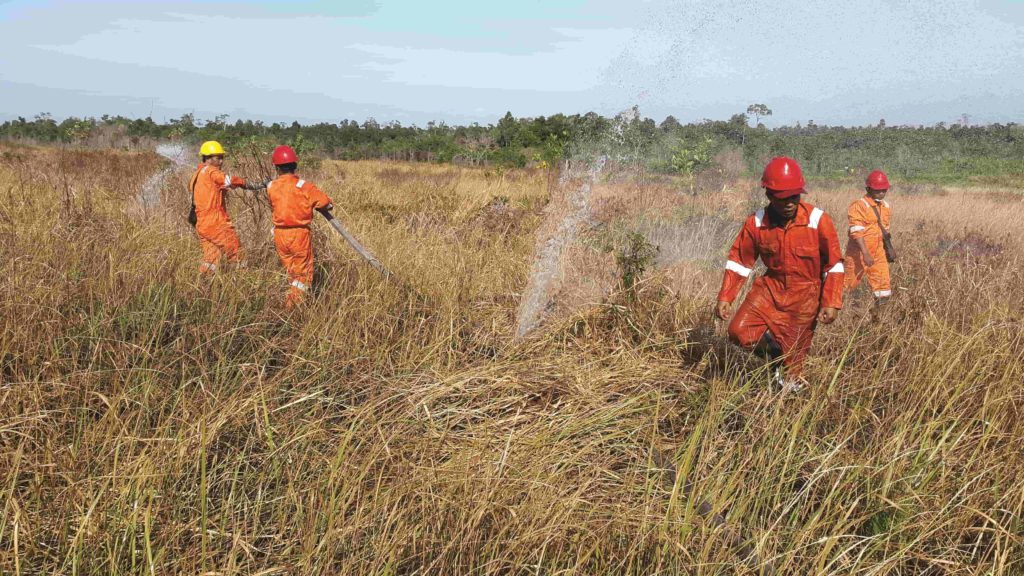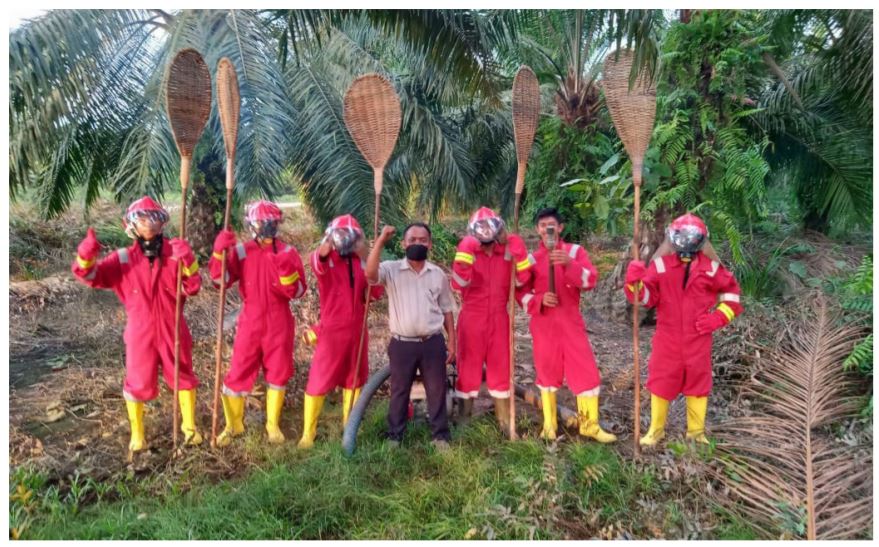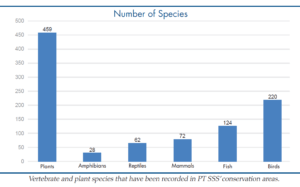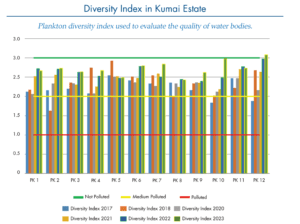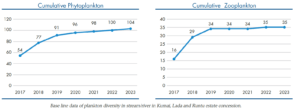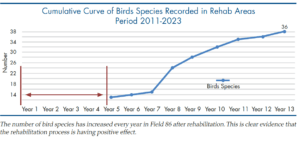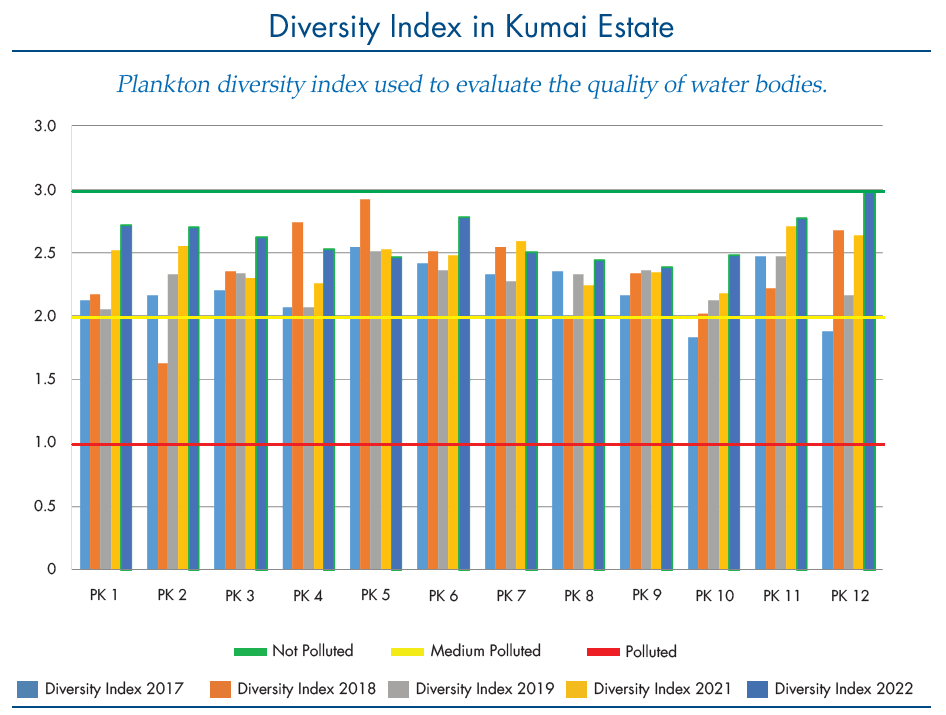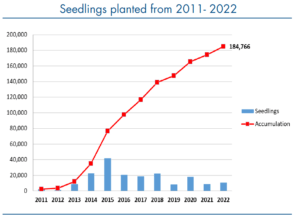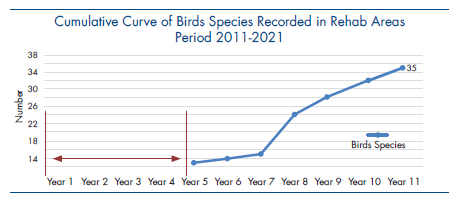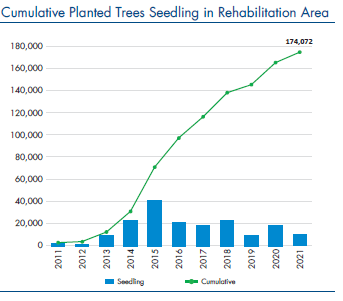ENVIRONMENT
UP is committed to being a leader in sustainable agricultural practices and is aware of the footprint it leaves on the environment and our Group therefore constantly strives towards reducing variables that impact the environment negatively. We strictly adhere to No
Deforestation and No New Development on Peat soils regardless of its depth since 2010 and focus on the reduction of GHGs, energy, water and waste in line with the concept of the circular economy as a vital part of our environmental policy. In addition, UP ensures no
conversion of all natural ecosystems including not to operate or develop within international or nationally designated protected areas.
We expect our direct and indirect suppliers live up to these commitments.
Global plantation development has contributed significantly to economic development and prosperity, however, deforestation and other unsustainable practices have many negative consequences for people and the environment and as a Group we therefore are fully committed to protect forests, peatlands, and human and community rights.

As an important part of our sustainability journey we work closely with our suppliers, contractors, customers, trading partners, scheme smallholders, other growers, traders, processors, NGOs, Brand manufacturers and other industry stakeholders to take part in transforming the industry as well as create further awareness on the importance of sustainable palm oil production.
In addition to our focus on continuous improvement to minimize waste and our overall carbon footprint our Group has through investments and a dedicated Group Sustainability Committee introduced policies to break the link between palm oil and deforestation. We fully adhere to the principles & criteria of the MSPO, ISPO and RSPO as well as our commitment on No Deforestation, No New Development on Peat and No Exploitation of People and Local Communities (NDPE) which are embedded in our Environment & Biodiversity Policy and Human Rights Policy.
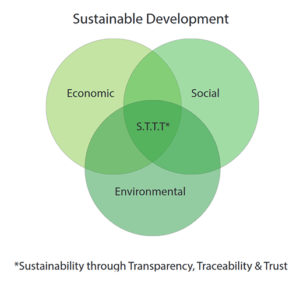

Conservation & Partnership
Efforts undertaken by the UP Group to conserve jungle reserves and wildlife sanctuaries as well as promoting green corridors as part of our commitment to the environment.
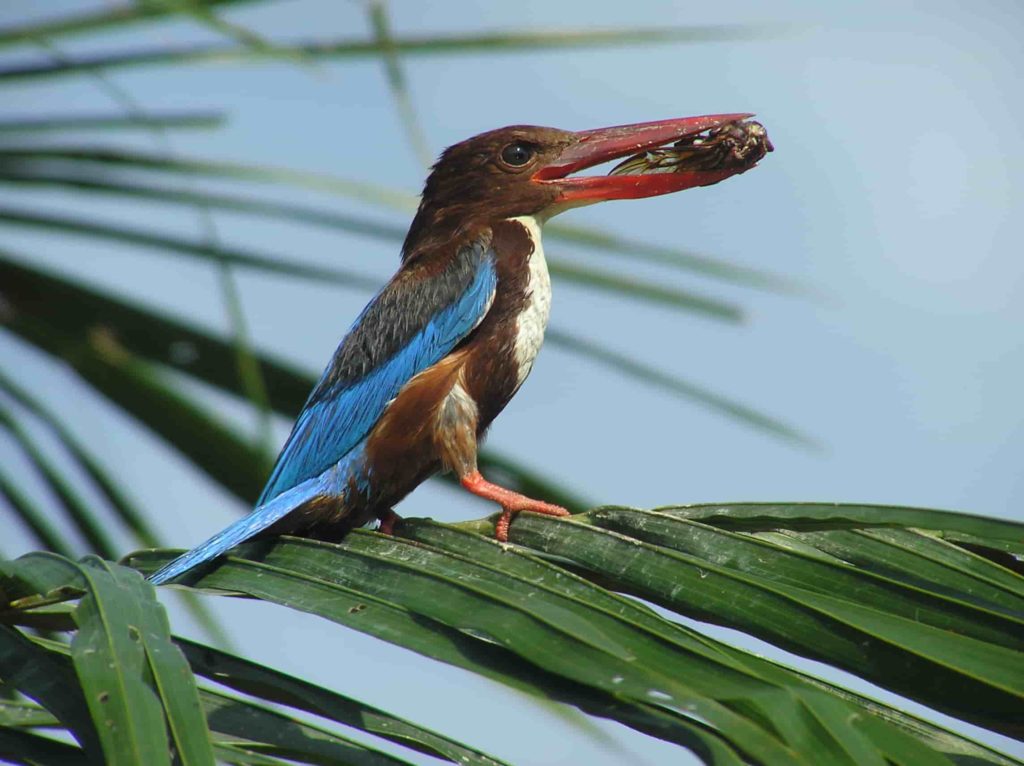
Adjacent Protected and Conservation Areas
Our Kumai Estate in PTSSS is approximately 2km away from the famous Tanjung Puting National park which is known to have a large diversity of forest ecosystems, including lowland forest, freshwater swamp forest, tropical heath forest which is called “Kerangas”, peat swamp forest, mangrove forest and coastal forest.
Tanjung Puting was originally declared as a game reserve in 1935 and a National Park in 1982. It covers a total area of 415,040 hectares. The best-known animals in Tanjung Puting are the orangutans, made famous through the long term efforts of the Orangutan Research and Conservation Program (predecessor to OFI), based at the landmark camp Leakey research station.
Tanjung Puting is also the habitat for proboscis monkeys as well as clouded leopards, civets, Malaysian sun bears , mouse deers , barking deers , sambar deers and the wild cattle known as banteng. Tanjung Puting hosts over 230 species of birds, including hornbills, deep forest birds and many wetland species.

Endangered and Protected Species
UP has a policy of “zero tolerance” to the killing of endangered and protected species, herein also orang-utan, Pongo pygmaeus. Staff that are directly or indirectly involved with the killing of and/or solicitation of killing, trading and harvesting of endangered and protected species, be it plants or animals-will be dismissed immediately. To the best of our knowledge, illegal killing and capture of orang-utans has not taken place at any of the properties under the legal management /jurisdiction of UP.

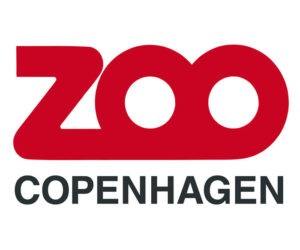
Biodiversity and Partnership
Conservation of jungle reserves and wildlife sanctuaries as well as promoting green corridors are examples of our commitment to the environment. To date, United Plantations has set aside more than 8,033 Ha of land for conservation purpose representing approximately 17.4% of our total planted area in order to encourage biodiversity and wildlife on our estate. In Indonesia, UP has set approximately 42.4% of its land concession for the purpose of conservation.
Riparian reserves are maintained to preserve flora and fauna, provide wildlife corridors, ensure water quality and prevent erosion. In order to develop effective conservation strategies, we need the assistance of experts in these fields who have established a series of collaborations and partnerships. One such partner is Copenhagen Zoo (CPH Zoo) which was initiated in 2007 and officially established on 1 October 2010, through a Memorandum of Understanding (MOU) between UP and CPH.
Biodiversity Department
In order to better manage our large conservation areas, UP set up its Biodiversity Department (BioD) under the purview of Dr. Carl Traeholt, our Group’s Chief Environmental Advisor a month later. It marked an important milestone for the Company’s target of producing certified sustainable palm oil in Indonesia and being able to document the environmental integrity of its Indonesian operations.
The Biodiversity team consists of a Division manager with solid natural resources management experiences, supported by five subject specialists and five field staff. This is supplemented by additional contract-workers when the need arises. The team is responsible for mainstreaming environmental concerns into standard operational procedures and focus on activities primarily within the following areas:
- Biodiversity (Fauna and Flora)
- Habitat and Ecosystem
- Forestry and rehabilitation
- Hydrology and Limnology
- GIS and Mapping
- Integrated Pest Management
- RSPO and ISPO
- Protection and Monitoring
- Community Outreach
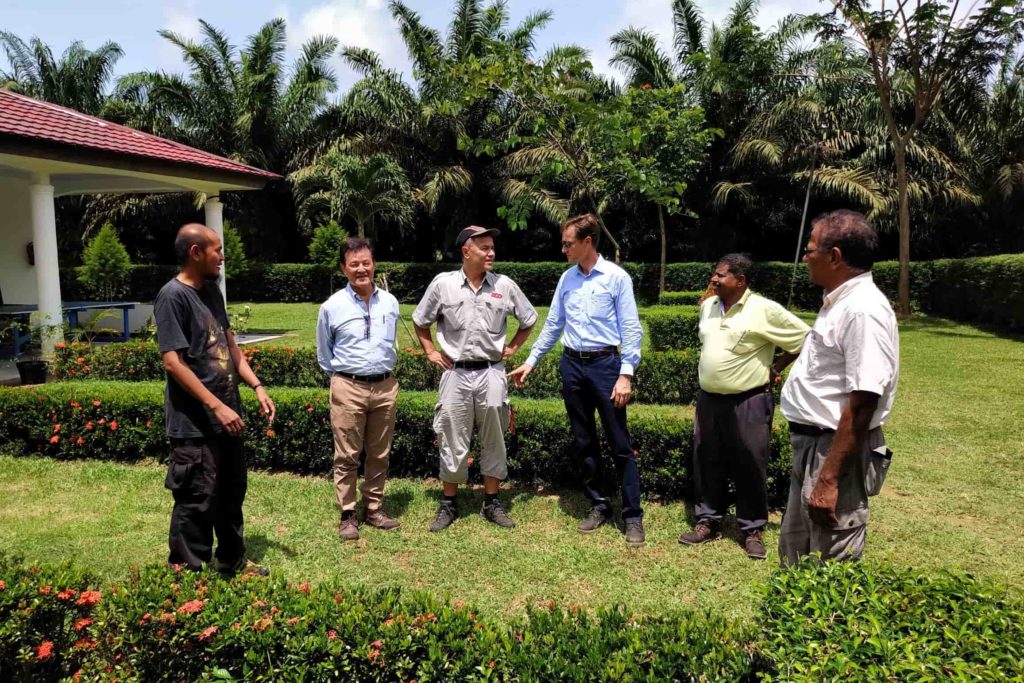
One of the key components in making the BioD a success which is our common goal was to develop internal capacity to manage and conserve UP’s ecological resources, and to make first-hand information about biodiversity assets easily available. This is possible with the current BioD consisting of Dr. Carl Traeholt, our Group’s Chief Environmental Advisor, Mr. Bjorn Dahlen, Environmental Advisor. Mr. Muhd Silmi, Senior Manager BioD and essential topic specialists, such as a limnologist, a forester/botanist, zoologist, herpetologist and database officer. These subjects’ specialists are supported by two chief rangers and a number of ranger assistants, as well as a native tree nursery manager.
Along the years since the establishment, this Department has undertaken an impressive amount of activities in support of the company’s commitment of producing sustainable palm oil. In the past, many exciting activities and accomplishments have been reported. For example, the Biodiversity Division has worked with leopard cats, Prionailurus bengalensis, as predator of rats to replace the environmentally detrimental chemical control.
Biodiversity Department’s activities
Since 2011, the BioD had undertaken an impressive amount of activities in support of the company’s commitment of producing sustainable palm oil and conserving the natural environment. In the past, many exciting activities and accomplishments have been reported. For example, the Biodiversity Division has worked with leopard cats, Prionailurus bengalensis, as predator of rats to replace the environmentally detrimental chemical control.
The work with the Sumatra cobra (Naja Sumatrana) and king cobra (Ophiophagus Hannah), the world’s largest venomous snake has not only produced some amazing results, it has also attracted one of the world’s best known and respected herpetologists, Romolus Whitaker, who continues to grace UP/PT SSS in Kalimantan and offer support and capacity building. The Biodiversity Division has also undertaken numerous camera trap surveys, bird and tree surveys to document the biodiversity within the company’s conservation areas. The BioD has recorded many of Borneo’s endangered species to date, among them Asia’s only great ape, the orangutan, Pongo pygmaeus.
While these are exciting and inspiring stories about exotic species, the BioD is far more than that. An entire host of other activities commenced right from the modest beginning in 2011, including developing a GIS database that incorporates literally all the team’s recorded data, be it from camera trap pictures, radio-tracking locations, number of tree seeds collected, time and place of illegal logging or recovery of aquatic fauna. Most of these stories can be found on our website.
Biodiversity activities during 2024 in PT SSS
When the Kunming-Montreal Global Biodiversity Framework (GBF) was adopted during the fifteenth meeting of the Conference of the Parties (COP 15) in December 2022, it marked the first time all 196 members agreed on a roadmap to halt and reverse nature loss by 2030.
This comes in the wake of two decades of failed attempts after the promises of the Convention on Biological Diversity, also known as the Rio Convention 1992. Although the GBF is not legally binding, it sets out several ambitious targets that are interlinked and interdependent on development processes and the Global Economy. One hugely important addition is the requirement for the Global private sector including financial institutions to play a significant role too.
The GBF marks an important milestone for nature. The vision to encourage and mandate both public and private efforts in this endeavor is exactly what the collaboration between United Plantations Bhd (UP) and Copenhagen ZOO (ZOO), both private entities, envisioned and engaged in more than a decade ago. In 2024, this collaboration reached an important milestone in itself, as it marked the 15th anniversary. It is, therefore, timely to provide a short status check on what has transpired within this period.
The biggest and most visible accomplishment is the development and integration of a professional, effective, and efficient Biodiversity Division at PT SSS (BioD). From a modest beginning with only three local project officers, Mr. Bjorn Dahlen, contributed two important years as interim manager with a responsibility to build and setup the BioD, as well as prepare the division’s current senior manager, Mr Muhd Silmi, for the tasks that lay ahead as a future leader of the team. Mr. Bjorn’s dedication to building a comprehensive database, attention to professionalism and integrity continue to form a solid foundation for the division.
Today the division consists of 18 full-time staff, including MSc and BSc degree holders in forestry, aquatic ecology, zoology, geographic information system (GIS) and dedicated field rangers. The maxim of “Think Global – Act Local” formed the philosophy of the development and, consequently, all BioD staff are Indonesian citizens, thereby ensuring long-term stability, local ownership and anchoring and the division has become an integrated part of PT SSS’ daily operation.
At an early stage, the BioD realized one of the main responsibilities concerned habitat rehabilitation, restoration and enrichment. Therefore, two native tree nurseries were set up and in the following years, more than 200,000 seeds belonging to a stunning 190 species have been collected, propagated into seedlings and out-planted. The sheer scale of this effort reflects the dedication of all involved from BioD’s forestry team leader, Mr. Ali Amran, field rangers, nursery assistants and estate managers and workers. Most of the BioD’s work, however, is far less evident. Working from an idea that “what can be measured can be managed”, BioD has focused primarily on data collection where this can be directly related to measuring the biological impact from the operation of palm oil production.
The daily diligent collection of data and analyses allows information flow to the resident President Director, estate managers and RSPO-officers enabling more informed and better decision-making opportunities. To date, PT SSS owns what is arguably the world’s most comprehensive biodiversity database in the palm oil sector. The data spans over many subjects such as species records, habitat rehabilitation and restoration procedures, seedling survival rates, growth and associated biological succession. It contains topographic features, satellite images and high-resolution drone images of all PT SSS’ conservation areas and beyond. It quantifies illegal land clearing, hunting and timber extraction and maps out hydrological features. A comprehensive snapshot of all these activities can be appreciated in the following pages of this annual report.
The enormous work undertaken at PT SSS has not gone unnoticed. At the end of 2024, BioD enjoys a very positive and progressive collaboration with the local Forestry Department (BKSDA). BioD’s senior manager has visited the Forestry Ministry Headquarters in Jakarta on several occasions, and engaged in high-level meetings and discussions with, among others the Director General and the future promises strengthening ties with the national entities to assist in direction Indonesia’s conservation efforts and fulfil her promises to the GBF. In addition, BioD staff have become increasingly engaged in local biodiversity conferences, seminars, and workshops, where they share experiences and solutions with contemporaries.
Apart from providing information for adaptive management purposes, the BioD has contributed as first author or co-authors in 14 scientific publications in local and international journals. This includes high impact journals such as Frontiers in Environmental Science, Ecology, Global Change Biology, Frontiers in Forests and Global Change and IUCN based journals.
The BioD was also the first ever to successfully detect orangutans at night by using drones fitted with infrared camera, and the first to record Hairy-nosed otters, Lutra sumatrana and breeding evidence of White-throated kingfisher, Halcyon smyrnensis, in the southern part of Kalimantan and in Borneo, respectively. In 2024, the BioD contributed to two new publications. Mendes, C. P., Wido, A. R., Amir, Z., Ancrenaz, M., Ash, E., Azhar, B., Bernard, H. ….Traeholt, C., Silmi, M. et al. (2024). CamTrapAsia: A Dataset of Tropical Forest Vertebrate Communities from 239 Camera Trapping Studies. Ecology e4299. https://doi.org/10.1002/ecy.4299 Silmi, M., Fanani, A., Huda, M., Amran, A., Suryadi, Mislan, Machid, F.I., Handayani, A.K. and C. Traeholt (2024). The first record of the White-throated kingfisher, Halcyon smyrnensis, breeding in Borneo, Indonesia. Journal of Oil Palm Research. DOI: https://doi.org/10.21894/jopr.2024.0052
There are many more manuscripts in the pipeline that will share the BioD Teams new findings, discoveries, and experiences. At the same time, these are being shared across the palm oil sector, conservation community and governments. For the past 15 years, BioD Team members have represented UP/PT SSS at conferences, symposia and workshops in Denmark, Holland, Croatia, Czeck Republic, South Africa, Malaysia and Indonesia with talks, presentations, and posters. This is a testament to the interest the work has generated across various sectors nationally and internationally.
Not only do these events communicate the achievements, challenges, and experiences of conservation work in Indonesia, they also constitute ongoing capacity building and knowledge sharing with the conservation community, academician, practitioners, and Governments. In this way, the BioD Team will remain current and relevant, with a solid understanding of contemporary challenges, technology, and science within the sector for many more years to come.
In 2024, the team added 33 new species to PT SSS’ species list, consisting of 3 reptiles, 14 fish, 15 birds and 1 mammal. To date, the BioD has recorded a total of 539 different vertebrate species of which 73 are mammals, 235 birds, 65 reptiles, 28 amphibians and 138 fish. In addition, 537 plants species have been recorded in PT SSS’ conservation areas. The total number of species is expected to increase significantly in the future when more surveys are completed, and rehabilitation areas mature.


Smart Patrol
Protecting conservation areas is one of the BioD’s core activities. The aim is to prevent possible negative impact from illegal activities such as logging, hunting, fire, over fishing and land clearing. BioD continue to use the SMART system to store all records in a digital format that is also integrated with the team’s GIS-database. This means that monitoring activities and evaluating the effect of them is easy to access to improve effectiveness and efficiency of patrols. In the middle of 2024, the region suffered very dry climate conditions. This caused extended dry seasons at PT SSS too and increased the risk of wildfires. Two fires were recorded in PT SSS in 2024, and fortunately limited long-term effect on conservation areas.
This was due to the teamwork by the BioD, estate and fire patrol teams who worked together for extended hours, often into the night, to contain fires. A combination of observation from estate towers and aerial observations by drone provided an effective combination as early warning to detect fires. This teamwork resulted in all fires in PT SSS contained to the effect that none of the outbreaks caused significant negative impact to the PT SSS concessions.
Water Quality Monitoring And The Plankton Diversity
Together with oxygen, water is the most important natural resource on earth that all known living organisms are dependent on. Therefore, the BioD Team affords water conservation the highest priority and focuses on protecting watersheds and maintain good water quality to support aquatic life as well as provide clean water to communities. The BioD Team has continuously monitored the water quality in PT SSS’ property to ensure actual water conditions in the water bodies across the estates remain as pristine as possible, and to improve the conditions of degraded systems. For this, the BioD Team focuses on aquatic microorganisms as indicators of water quality.
Aquatic invertebrate samples are collected from streams and ponds located in the planted and conservation areas in Lada, Runtu, and Kumai estates. Sampling sites are fixed points and to date the BioD Team has recorded 106 Phytoplankton and 35 Zooplankton species.
Based on the plankton diversity from sampling in Kumai, Lada and Runtu estates the water condition in the rivers in and surrounding the estates fall into the “medium condition” category. This means that the water is slightly polluted but showing signs of improving. The rehabilitation of riparian forest along the streams in PT SSS is showing positive effects by minimizing organic and inorganic pollution washout in all three estates.
Bird Diversity In A Rehabilitation Area
Rehabilitation activities in Lada Estate have been ongoing since 2011. The first phase of habitat rehabilitation was to plant as many native trees in degraded areas as possible to recreate a natural canopy cover. The BioD Team assumed that a good tree diversity with extensive canopy cover will attract many wildlife species, since it provides shelter and foraging areas for, particularly, understory birds and microbats. To date, approximately 350 ha have undergone intensive rehabilitation and restoration activities during which the BioD Team has planted ±195,420 native tree seedlings from 130 tree species. Despite difficult conditions, an estimated 65% seedlings have survived and have grown well today.
Concurrently with planting new trees, the BioD Team monitors biodiversity in the rehabilitation areas, and Lada Field 86, Div 2 is mainly used as a large experimental site. The understory bird diversity is a good indicator of habitat condition and succession, including the extent of a canopy. Understory bird species prefer habitat with dense canopy cover and are often cryptic and difficult to see, even when using binoculars. Therefore, mist-netting was used to capture birds in the area, in addition to direct observation. The bird monitoring began 4 years into the rehabilitation process, when the first planting activities were initiated.
Subsequent monitoring reveals an increasing number of bird species throughout the years. From merely 13 species in 2015, the BioD Team recorded 41 bird species in 2024. This is another testament to a successful rehabilitation process. It is expected that the bird diversity will continue to increase in tune with the increasing canopy height of Field 86. The next big milestone is when endangered and critically endangered birds begin to return to the area in the future.
Ficus Tree For Rehabilitation Program
Fig trees (Ficus spp.) are ecologically important keystone species because they sustain many species of seed-dispersing animals that feed on their fruits. The BioD Team has recorded orangutan, gibbon, hornbill, bats, other small mammals and many bird species flocking to a single fruiting fig tree. Considering the value of this group of trees, at an early state, BioD started propagating fig trees and outplant these in the rehabilitation areas. At the onset 4 species of fig trees were planted on the rehabilitation areas and, subsequently, 12 more species have been added, some of which are self-propagated, most likely through seed dropped from birds, or faeces from mammals and birds.
The record of “self-propagated” fig trees is an indication of how the recovery of an area is improving significantly by itself. The more tree diversity, the taller and denser the canopy, the more vertebrates are attracted to the areas, with the positive side effect of “importing” more seeds from a variety of other plant species, and the attraction of even more species diversity. This natural cycle helps accelerate the recovering of the rehabilitation area(s) and by 2024 the BioD Team has recorded 16 fig species in Field 86.
Restocking The Ficus Trees
Considering the value of Ficus trees, The BioD team has increased the emphasise on propagating fig tree seedlings nurseries. In 2024, the BioD Team identified three new Ficus species; Ficus glandulifera, Ficus xylophylla and Ficus delosyce. As many fruits as possible were collected and transferred to growth media. After sprouting and on one months’ growth, the seedlings were transferred to polybags, and at approx. 100cm height, they will be out-planted. Due to capacity limitations, not all seeds will be propagated at the same time, but stored for future use.
Conserving The Dipterocarp Mother Tree, Ketimpun (Anisoptera marginata)
The Ketimpun or Anisoptera marginata is a medium-sized to large tree up to 45 m tall. The trunk is branchless for 15-25 m and up to 135 cm in diameter, with buttresses up to 3m high and spreading out up to 1.5m. The wood durability varies from moderate to perishable. It is rapidly attacked and is unprotected. Ketimpun is a highly versatile timber, suitable for a variety of applications including furniture, construction, and joinery.
It is also a highly sought-after material, with many suppliers offering it from sustainable and legal sources. In the local community perspective, this tree is valuable and often targeted for wood extraction because of its profitability. Therefore, this species has become increasingly rare and is difficult to find and is listed as “Vulnerable” on the IUCN Red List. The high demand for Ketimpun timber puts this species in danger of disappearing entirely from the area. Therefore, the BioD Team has put additional focus on conserving every Ketimpun mother tree found in our estate property.
Fortunately, some were left during the plantation development phase. Unfortunately, some of these are left entirely exposed as a single tree without adjacent vegetation. The BioD Team will embark on replanting the adjacent space around these mother trees to minimize the risk of contracting diseases and suffering premature death.
In general, the dipterocarp family of trees produces large seed quantities during what is known as a period of mass flowering. This usually occurs once every 7-8 years, although this can be influenced by climatic variables. The Ketimpun trees in our estates first flowered and produced seeds in 2016.
This amazing event took place again 7 years later, when the trees began flowering at the end of 2023 for the fruits to ripen only in the middle of 2024. Because of such rare occurrences, the BioD Team collected as many seeds as possible to maximize the number of surviving seeds. In total the BioD Team collected 22,000 seeds of which the majority are being propagated in the nurseries and will be out-planted in rehabilitation areas. Some seedlings are shared with local neighbouring communities as an investment for future biodiversity and timber.
Diversity Of Ants In The Plantation Landscape
A comprehensive ant diversity study was undertaken in March to July 2024. This formed a collaboration between PT SSS and the Department of Biology at Padang State University (Universitas Negeri Padang). The Padang University team consisted of one of Indonesia’s leading ant specialists, Dr. Rizal Satria, along with two students, Mhd. Alfaris Pratama and Silvia Muharani. Ant samples were collected from various types of habitats in PT SSS; peat swam forest, mangrove forest, freshwater swamp forest, dipterocarp forest, heath forest (kerangas) and oil palm planted areas. In total, the joint team collected ±3000 ants representing at least 80 species. Due to the complex taxonomy of invertebrates, the Padang team will continue to identify and verify the samples at the university laboratory.
The ant baseline data for Borneo remains extremely limited, despite this group, together with termites, constitute the most important element in the decomposition process of a tropical rainforest. Therefore, the BioD Team feels it is essential to begin to contribute more to this monumental task, as well as to gain more knowledge about how leaflitter biodiversity determines regeneration speed and success of rehabilitation. There is little doubt that ant and termite diversity could also be important for the ecological process in the planted areas. Ants are already known to contribute significantly to aerating soil, dispersing seeds, consuming organic material, redistributing nutrients, and protecting plants.
Asian Primate Symposium In Medan, Indonesia
The 9th Asian Primate Symposium (APS) is one of the most prestigious national conservation events for academicians, practitioners, NGO’s and government authorities. This event is the largest of its kind in Asia and the Medan event held from 23-27th November 2024 attracted 299 participants from 20 countries. The BioD Team represented UP/PT SSS in this important event. Our Senior Manager Mr. Muhammad Silmi and research officer Mr. Satrio Nugroho participated, both contributing with oral presentation about primate research and conservation activities in PT SSS.
The titles were “Detectability of Borneo Orangutan Using Camera Traps on the Ground and In the Canopy” and “Assessing Activity Pattern Overlap among Four Primate Species in Plantation Landscape”. For the general audience, it created enormous positive feed-back and, to many, surprise to experience that a plantation company is committed to this level of safeguarding biodiversity. The event also exposed what has become almost customary in relation to both national and international biodiversity and conservation events that is, the UP/PT SSS was yet again the only team representing the palm oil sector. While it is a clear testament to the company’s unwavering dedication to biodiversity, it is also glaringly obvious that the wider industry continues to fall far behind. The sentiments expressed at the event revealed plainly that the palm oil sector continues to be perceived as the main villain in the loss of biodiversity narrative. The quality presentation from the BioD Team at the event turned out to be an eye-opener for many participants, who included the BioD Team in positive discussions related aiming at finding meaningful and effective conservation solutions and forge cross-sector partnerships.
Exposing the elusive biodiversity in the forest canopy
It is estimated that approximately half of all mammal species are arboreal that is, they live their entire lives in the forest canopy without ever descending to the forest floor. Despite this, the diversity of wildlife in the forest canopy is rarely studied and the species composition and intraspecific relationships remain little researched. Understanding the complex ecological functioning of this part of the rainforest habitat is essential to exposing the intricacies of, especially, the interdependencies, symbioses and species composition that play vital roles in forest regeneration and resilience.
The primary reason for the limited canopy studies is obvious vis-à-vis, access is difficult and sampling 40- 60m above the forest floor comes with an element of risk and requires specific training, safety equipment and skills. It has long been on the BioD Team’s priority list to undertake a comprehensive baseline study of the rainforest canopy in the UP/PT SSS landscape. After extensive tree-climbing training in Malaysia, Sabah, 2024 became the year when the planning and deployment of camera traps commenced in earnest. The study took place in the HCV-areas of Kumai estate from May to July 2024. The BioD Team deployed 29 camera traps systemically in 1 km2 grids and in varying heights from 8.5 – 20.3 meter above ground. The preliminary survey resulted in a total of 1,835 trap days, producing 18,196 photos in 7,570 independent events. In total, the BioD Team analyzed all photos and identified 28 species. Most were common in the area, such as Plantain squirrel, Orangutan, Long-tailed macaque and Pig-tailed macaque. We also detected rare species such as Giant squirrel, Slow loris and, especially, the very elusive Pen-tailed tree shrew (Ptilocercus lowii). The find of this species confirms a single older record and is a new record for the species in the southern part of Borneo. The BioD Team is currently working on a short manuscript to publish this important finding.
The camera traps remain in the canopy, with the aim of capturing at least one annual cycle. It is also anticipated that more species will be recorded as time goes by.
Conservation Awareness Program
The success of conservation efforts largely depends on broad-based public support. However, the World is experiencing a growing separation between people and nature, primarily due to urbanization and modernization. This may decrease individual connection with nature and public support for conservation. Encouraging interactions between people and nature becomes of major importance. Therefore, the BioD undertakes regular visits to local elementary schools (Grade 5-6) with an aim to create fascination about nature, inspire coming generations to take interest and action, and teach them about the importance of biodiversity and humanity’s dependence on biodiversity. During 2024, we visited five elementary school in five villages with an outreach to 276 students in total.
The UP/PT SSS outreach programme on biodiversity and conservation received tremendous support from schoolteachers at the respective schools. They and the pupils appreciate BioD’s effort in sharing their knowledge and experiences about conservation in practice. Using real life examples, videos and photos of wildlife and plants from the area helped to inspire the pupils and encourage them to contribute to conservation action. To many teachers and pupils, the sheer species richness is awe-inspiring and something they never knew existed in their own backyard.
The programme also included an element of “thinking about the bigger picture”, especially related to environmental carrying capacity and climate change. Both topics already have profound impact on peoples’ livelihoods, and it is certain that it will become an even bigger concern in the future. Inculcating a sense of conservation awareness into children of this age constitute an essential investment in the future by forming the coming generations with a mindset that is more in tune with nature and equipping them with the incremental knowledge of nature-based solutions.
Ministry of Environment and Forestry, Jakarta: Strategy meeting with the Director General KSDAE
At the national level, the responsibility to sustainably utilize and safeguard biodiversity falls under the Ministry of Forestry. The highest office that is specifically bestowed with the biodiversity conservation and protection mandate is the Unit for Natural Resources and Ecosystem Conservation (KSDAE). The KSDAE is headed by a Director General (DirJen KSDAE) who is also considered the Minister’s most important advisor. It is paramount to any conservation progress that all activities are undertaken with support from KSDAE that are represented in provinces by a sub-unit, BKSDA. The ongoing collaboration with the Provincial BKSDA in Pangkalan bun and UP/PT SSS has raised a lot of positive awareness in the Ministry. To help facilitate conservation efforts in the Kumai Estate landscape, the DirJen KSDAE extended an invitation to UP/PT SSS to present the conservation ideas for the extended landscape. The meeting took place at the Ministry in Jakarta on the 11th September 2024 and was chaired by DirJen KSDAE Prof. Dr. Satyawan Pudyatmoko with Director for Legal Affairs, Mdm Dewi Suyatman and Senior Manager for Biodiversity, Mr. Muhd Silmi representing UP/PT SSS.
The UP/PT SSS team made a presentation of their conservation initiatives, ongoing activities, and achievements before addressing the challenges in the area. UP/PT SSS requested support for the idea of conserving landscapes to support so-called meta population management of several endangered species in the area. Due to the extensive fragmentation of once large cohesive populations, many have become too small to sustain viable genetic diversity. Without active conservation intervention, these will go extinct due to, primarily inbreeding depression. There are two elementary options; either management authorities take actions to exchange individuals from different sub-populations at regular intervals, or let nature do the job by establishing ecological corridors where geneflow can take place naturally. Without any of those, sub-populations of larger vertebrates in UP/PT SSS’ conservation areas will perish in the near future.
The proposal was well received, and the DirJen officially encouraged UP/PT SSS to continue the initiative and work closely with BKSDA in Central Kalimantan Province. The DirJen also envisioned that UP/PT SSS conservation areas should be a model of preservation forest that is in line with the new Laws of Indonesia No. 32 Year 2024 (Undang-Undang Nomor 32 Tahun 2024). Preservation forest refers to forest areas that are not legally gazette as national parks or enjoy any kind of other legal protection, yet that contain high biodiversity value.
The positive feedback from the DirJen KSDAE solidifies the ongoing relationship between the two parties and gives hope for the future, where UP/PT SSS and BKSDA Pangkalan Bun can strengthen existing joint activities and expand it with new projects in the future.
Biodiversity Division’s Activities in the Past Years
In 2023, all biodiversity activities were back on target after two years of COVID-19 limitations, and the BioD continued to work at normal capacity throughout the year. The team also attended national and international seminars and workshops that formed part of ongoing capacity building and knowledge sharing with the conservation community, academician, practitioners and
government. This was also made possible due to uplifting travel restrictions from the COVID-19 outbreak.
In 2023, the team added eight new species to PT SSS’ species list, consisting of one reptile and seven bird species. To date, the BioD has recorded a total of 506 different vertebrate species of which 72 are mammals, 220 birds, 62 reptiles, 28 amphibians and 124 fish. In addition, 459 tree species have been recorded in PTSSS’ conservation areas. The total number of species is expected to increase significantly in the future when more surveys are completed, and rehabilitation areas mature.
In 2022, the team added six new species to our species list, namely two reptiles, one fish, and three birds. To date, the BioD has recorded a total of 498 different vertebrate species of which 72 are mammals, 213 birds, 61 reptiles, 28 amphibians and 124 fish. In addition, 425 tree species have been recorded in PT SSS conservation areas. The total number of species is expected to increase significantly in the future when more surveys are completed, and rehabilitation areas mature.
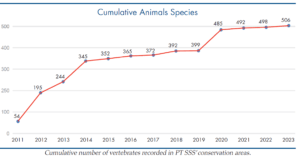
The World’s First Orangutan Survey Using Drone Fitted With Thermal Camera
The BioD team have already recorded baseline data regarding the distribution of orangutan. This has been undertaken through nest counts, camera trapping, and interviews of local residents. The past four years, the BioD team has also explored the opportunity of conducting orangutan survey using drone fitted with thermal camera. The survey was carried out in Kumai Estate from January
29th to February 10th 2023. The survey was first of its kind and a representative of TNI Air Force Sutan Iskandar military airport, Pangkalan Bun, the Head of BKSDA Kalimantan Tengah and Head Section II of BKSDA participated in the survey to learn about new technology and, potentially, a more cost effective survey method. The survey was conducted in the evening when the orangutans
are usually in nests. The BioD team successfully identified five orangutan including female, baby and juvenile, and adult male. In addition, the BioD team gained new insights into orangutan behaviour at night, and the method will be applied in all future orangutan population surveys and monitoring, in addition to line transects and camera trapping. The survey also detected other protected species such as long tailed macaque, langur, and southern pig tailed macaque.
The second drone survey was conducted from 6th to 12th November 2023, also in Kumai Estate. During the five-nights survey a total of 49 photos of orangutan were recorded that represented at least ten individual orangutans. This included four females and three babies This survey proved very useful and enabled the BioD team to survey the entire Kumai Estate in one night. The spotting
and identification of individual orangutans in their nests, as well as other protected species opens- up opportunities for a number of exciting future conservation activities. The survey also demonstrates that orangutans can live in relatively small forest patches in a landscape dominated by oil palms. The BioD team will strive towards enriching PT SSS’ forest patches with additional food plants, and continue to collaborate with and advise the government to develop new policies and plans regarding orangutan conservation in fragmented landscapes dominated by oil palm and other plantations. In addition, the BioD will work towards preserving a forest corridor that connects Kumai Estate with Tanjung Puting National Park, the largest orangutan park in the world, to allow a natural geneflow between PT SSS’ conservation landscape and the national park.
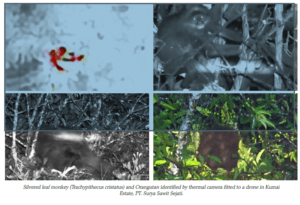
Wildlife Survey in the Forest Corridor Between Tanjung Puting National Park and Kumai Estate
The forest habitat connecting PT SSS’ conservation areas with Tanjung Puting National Park (TPNP) forms the last existing ecological corridor preventing these two landscapes from being isolated from each other. Once this connection is severed, non-volant wildlife populations will be genetically isolated from each other, and become increasingly vulnerable to inbreeding depression. Therefore, it is critical that this forest tract be protected to allow for natural dispersal of genes across both TPNP and PT SSS. In a joint effort, the BioD team and BKSDA Central Kalimantan undertook a camera trap survey of the forest corridor which
produced 398 pictures of animals belonging to 22 species. These include Sunda pangolin (Manis javanica), Orangutan (Pongo pygmaeus), Bornean sun bear (Helarctos malayanus), Pigtail macaque (Macaca nemestrina), Bornean Bearded Pig (Sus barbatus) and Bornean crestless fireback (Lophura pyronota). The survey revealed that this is indeed an important remaining forest that the company could try to protect permanently.
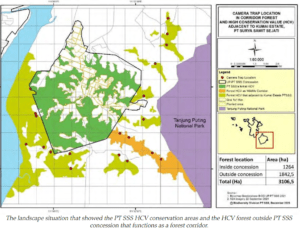
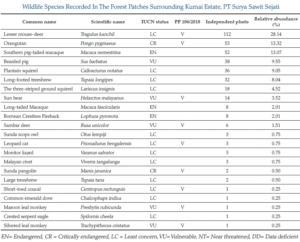
Whereas PTSSS has begun to encourage the government in protecting this remaining corridor, it remains a difficult challenge to obtain the necessary permits to assume management and conservation rights of the area. The forest corridor is located outside the PT SSS concession with a legal status of HPK and APL, which needs to go through a tedious process to convert into protection status. In 2023, the BioDteam continued to encourage the BKSDA Central Kalimantan to raise attention at the Head of and find a strategic way to conserve the forest corridor. On the 8th September 2023 the Head of BKSDA Central Kalimantan issued a letter No: S568/K.15/TU/ KSA/09/2023 requesting BKSDA Central Kalimantan to support the protection of the corridor. The letter also recommended to all stakeholders to join in the effort to protect the remaining forest fragments and refrain from activities like mining and palm oil plantation that can destroy the forest. The letter from BKSDA is of critical importance to PTSSS, because the BioD team will effectively have the government support to do more work on the ground to ensure the forest corridor can be protected. In the process, PTSSS will scale up communication with the community who own the land in the forest corridor and try to convince them to maintain the land intact for biodiversity. The work will also require intensive communication and coordination with the government to pursue a long-term legal solution to the land status
Tree Climbing Course In Sukau, Sabah, Malaysia

To increase team capacity to safely conducting biodiversity surveys in canopies, four staff from the BioD team, Mr. Silmi, Mr. Mahfud, Mr Suryadi and Mr. Luthfi participated in a tree climbing course in Sukau, Sabah Malaysia, from 15th to 18th February 2023. The training was led by the experienced, Mr. Jamiluddin Jami from Borneo Tree Climbing Academy (BTCA). All four BioD team members successfully passed the training and examination for both level 1 and level 2 and were presented with tree climbing certificate, authorised by an accredited trainer from BTCA. In the future, using this training, the BioD team will begin to explore the secrets of biodiversity and wildlife ecology of arboreal species.The knowledge of under- standing canopy biodiversity is critical for developing effective conservation management strategies.
Camera Trap Survey In The Forest Canopy
Immediately after becoming certified tree-climbers, the BioD team setup several camera traps in the tree canopy in Pulai Cempedak Lada Estate, to test the equipment and their newly acquired skills, as well as to prepare for a more extensive systematic canopy survey in Kumai Estate in 2024. The results turned out some positive surprises, including photos of orangutan feeding on wild Borneo mangoes. These photos of orangutans are also the first ever captured in Lada Estate using camera traps, despite the on-the-ground camara trap surveys which have been undertaken since 2014. In contrast to Runtu, Umpang and Kumai estates where the team has obtained many photos of orangutan, the species have remained elusive until this latest canopy survey.
Apart from the positive survey outcome, the team was also satisfied that the capacity to climb large trees and deploy camera traps in the canopy has already revealed promising and interesting information. Conservation Communication With “Gen Z” Apart from research and protecting conservation areas from illegal intruders and activities, it is important to share the common goals for conservation with the community surrounding the area. The BioD team deliberately focused on “Generation Z” or colloquially known as Zoomers, because they constitute a new generation that will safeguard the environment and biodiversity in the near future.
It is critical that this generation understands the purpose of conservation and how proper management of biodiversity and ecological processes is critical to their own present and future livelihoods. For the Gen Z programme, the BioD team collaborated
with the Junior High School in SMP Negeri 2 Pangkalan Lada. Joint meetings with the school principal resulted in a conservation syllabus covering several topics critical to future practices:
•Environment and wildlife conservation
• Borneo jungle seed propagation and nursery
• Habitat rehabilitation and restoration,
• Impact of rehabilitation on biodiversity
• Wildlife survey and monitoring
In this important programme staff from PT SSS BioD team served as teachers or mentors for the students during the period from September-November 2023. This programme included both indoor and outdoor sessions, where a site visit to PT SSS conservation areas was used to demonstrate critical processes such as rehabilitation and wildlife monitoring. This programme was successful
and may be replicated for new students in the future.
Smart Patrol
Protecting conservation areas is one of the BioD’s core activities. The aim is to prevent possible negative impact from illegal activities such as logging, hunting, fire, over fishing and land clearing. BioD continues to use the SMART system to store all records in a digital format that is also integrated with the team’s GIS-database. This means that monitoring activities and evaluating the effect of them is easy to access to improve quality of patrols. In 2023, the El Nino effect impacted most of the region. This caused
extended dry seasons at PT SSS areas, and increasing wildfire risk. A total of eight fires were recorded in PT SSS in 2023, and some affected conservation areas.
All fires recorded started outside PT SSS concessions before it reached PT SSS. The BioD, estate and fire patrol teams worked together for extended hours, often into the night, to contain the fires. A combination of observation from estate towers and aerial observations by drone provided an effective combination as early warning to detect fires. This teamwork resulted in controlling all fire outbreaks in PT SSS to the extent that none of the outbreaks caused significant negative impact to the PT SSS concessions.
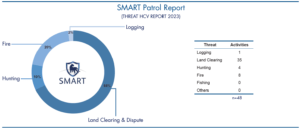
Water Quality Monitoring And The Plankton Diversity
Water is the most important natural resource on Earth that all known living organisms are dependent on. Therefore, the BioD Team affords water the highest priority and focuses on protecting watersheds and maintaining good water quality to support aquatic life as well as provide clean water to communities. The BioD Team has continuously monitored the water quality in PT SSS’ property to ensure actual water conditions in the water bodies across the estates remain as pristine as possible. For this, the BioD Team focuses on aquatic micro organisms as indicators of water quality. Aquatic invertebrate samples are collected from streams and ponds located in the planted and conservation areas in Lada, Runtu, and Kumai estates. Sampling sites are fixed points and to date the BioD Team has recorded 104 Phytoplankton and 35 Zooplankton species. Based on the plankton diversity from sampling in Kumai, Lada and Runtu estates the water condition in the rivers in and surrounding the estates fall into the “medium condition” category. This means that the water is slightly polluted but showing signs of improving. The rehabilitation of riparian forest along the streams in PTSSS is showing positive effects by minimising organic and inorganic pollution washout in all three estates.
Bird Diversity In A Rehabilitation Area
Rehabilitation activities in Lada Estate has been ongoing since 2011. The first phase of habitat rehabilitation was to plant as many native trees in degraded areas as possible to recreate a natural canopy cover. The BioD Team assumed that a good tree diversity with extensive canopy cover will attract many wildlife species, since it provides shelter and foraging areas, particularly for understory birds and microbats. To date, approximately 300 ha have undergone rehabilitation activities during which the BioD Team has planted ±192.110 native tree seedlings from 130 different tree species. Despite difficult conditions, an estimated 65% seedlings have survived and grow well today. Concurrently with planting new trees, the BioD Team monitors biodiversity in the rehabilitation areas, and Lada Field 86, Div 2 is mainly used as a large experimental site. The understory bird diversity is a good indicator of habitat condition that also reflects the condition of the forest canopy. They prefer habitat with dense canopy cover and are often cryptic in nature and difficult to see, even when using binoculars. Therefore, mist-netting were used to capture birds in the area, in addition to direct observation. The bird monitoring began 4 years into the rehabilitation process, when the first planting activities were initiated. Subsequent monitoring reveals an increasing number of bird species throughout the years. From merely 13 species in 2015, the BioD Team recorded 38 bird species in 2023. This is another testament to a successful rehabilitation process. It is expected that the bird diversity will continue to increase in tune with the increasing canopy height of Field 86. The next big
milestone is when endangered and critically endangered birds begin to return to the area in the future.
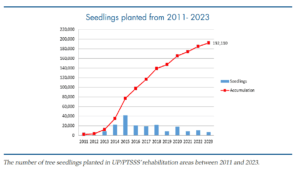
False Gharial Survey in Arut River
False Gharial, Tomistoma schlegelii, is a freshwater, mound nesting crocodilian with a distinctively long, narrow snout. This reptile native to Indonesia, Brunei, and Malaysia. The false gharial is threatened with extinction throughout most of its range due to habitat loss arising from human activities like drainage of freshwater swamplands and clearance of surrounding rainforests or riparian zones. The species is also hunted for its skin and meat, and the eggs are often harvested for human consumption. IUCN currently lists the False Gharial as Endangered (EN) on the IUCN Red List, because of the continued population decline across its range. Therefore BioD, PTSSS has taken the initiative to undertake a comprehensive population survey of the species in the Arut River that forms the western boundary of PT SSS conservation areas in Runtu and Umpang estates, as well as in the swampy lakes that form part of the estates. BioD have established permanent transect lines along a 32 km stretch of the Arut River that forms the boundary
of PT SSS’ conservation area. Surveys are conducted at night using torches to spot for crocodile eyeshine in the water. The crocodiles’ eyes reflect light that hits their eyes, making it relatively easy to identify them for a trained observer. Surveys were undertaken every fifteen days from a wooden boat. To limit noise as a possible deterrent, the BioD team float or paddle gentle downriver while spotting for crocodiles. The surveys conducted from August to December 2023 revealed promising results with a total of 42 records of crocodile eyeshine and 11 records of direct sighting — that is, when a team member could see parts or the full body of a False Gharial. The information gathered from the 2023 survey will form part of our annual monitoring and future ecological research about the False Gharial. Furthermore, it will eventually form a critical part to the development of a conservation management plan together with BKSDA Kalimantan Tengah. The BioD Team aims for greater success in the survey, hoping to provide further insights into the crocodile population on the Arut River.
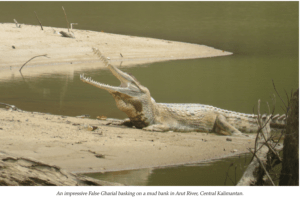
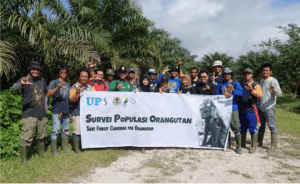
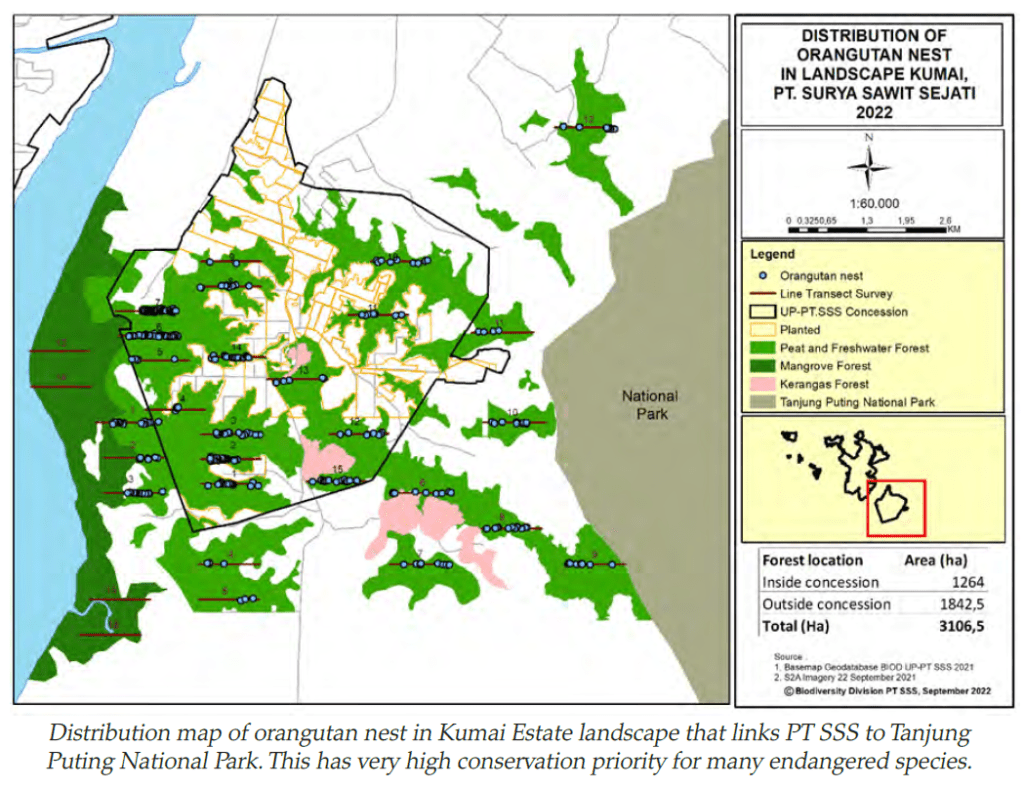
This is an exceptional high number that, if based on the BioD Team’s camera trap monitoring efforts, seemed surprisingly high. The nest account approach is associated with a number of uncertainties and biases that may appear in from surveys in “small patches of forest”. For example, in a small forest fragment, orangutan may be forced to build many nests in the same area, since they are confined to a very small roaming habitat. In addition to nest counting, the BioD Team will continue to monitor orangutan using camera traps and drones fitted with thermal camera that may increase the accuracy and documentation of orangutan in a specific area. An expansion of the wildlife surveys and management into sites adjacent to PTSSS’ estates will be executed under RaCP programme.
Baby and Juvenile Orangutan In Plantation Landscape
Orangutan presence in PT SSS conservation areas were already recorded during the early stages of plantation development, 14 years ago. What surprised the BioD Team then was the fact that the small population of orangutans remained healthy and were reproductively active. At the time, such few scattered and isolated populations were captured and moved into so-called “rescue centres” by local authorities, even if they did not specifically need to be “rescued.” Therefore, the BioD Team did not request removal of PT SSS orangutans but put priority in managing their existing habitat.
This included monthly monitoring and habitat enrichment, to ensure the few individuals roaming PT SSS HCV-areas had sufficient food. Unexpectedly, the BioD Team frequently recorded females with babies or juvenile estimated at around 1-4 years, often as second and third generation from the same female. This was fantastic evidence of the species’ resilience and adaptability to changing habitat circumstances, as well as a validation of the original decision to leave them where they were. In the face of ongoing scepticism and critics, by 2022 the BioD Team has recorded 11 photos of orangutan babies and juveniles that are estimated to be less than 4 years old. At least nine of these belong to different mothers and new-borns have been recorded almost every year since 2013.
It is this success that laid the foundation for the current collaboration with the local authorities BKSDAE and KPHP as well as OF-UK. The BioD Team is proud of having been instrumental in influencing a new strategy for Indonesia’s orangutan conservation efforts. This strategy proposes that orangutans should be left where they are found, except for circumstances where they suffer ill health, malnutrition, or any other form of distress. The BioD Team formed an important part of the recent publication Importance of Small Forest Fragments in Agricultural Landscapes for Maintaining Orangutan Metapopulations that was published together with the world’s leading orangutan conservationists. Having taken the lead in this approach, PT SSS is also faced with several future challenges and will be embarking on more advanced conservation intervention such as meta-population that is inherently reliant on genetic assessments at site level. In addition, studbook keeping may become relevant for small isolated population that need occasional genetic infusion in the form of translocated male(s) to ensure the orangutan population in plantations landscape are genetically viable. This requires even deeper collaboration with BKSDA as well as KSDA at Central level.
Landscape based conservation planning – discussions with BKSDA Central Kalimantan
Borneo’s once vast rainforests are increasingly being replaced by forest patches intersected by urban and agricultural landscape. Many species that were common and found in large cohesive populations are now found in much smaller numbers, as well as in isolated fragmented populations.
The challenge posed by managing endangered species in isolated fragmented populations is not new. However, the scale of it is. The BioD Team has grappled with this scenario since its formation and it has constantly communicated this challenge to the local conservation authority, BKSDA Kalimantan Tengah. Fortunately, the BKSDA now seems to acknowledge that there is a need for a solution. Using orangutan as an umbrella species the BioD Team has highlighted the challenges of conserving the species in small forest patches within the plantation landscape. For more than 10 years, the BioD Team has recorded and monitored the local orangutan population dynamics and is happy to report a slight increase in numbers. Unfortunately, such small habitat fragments reach a population carrying capacity relatively fast, and the subsequent overpopulation of a specific species will cause conflicts with local communities and/ or result in a higher degree of inbreeding. This problem can be solved either by active population intervention i.e., managers will manage genetic drift actively by translocating individuals between various isolated habitat fragments, or establish a natural corridor where animals can disperse freely in the landscape.
The HCV areas in PT SSS Kumai Estate is home to 20-30 orangutans. To date, the population seems to be within the biological capacity of the area. Since they are confined to the HCV area without any possibilities of dispersing to other habitats that are suitable for their survival, orangutans will, over time, suffer inbreeding depression. Interestingly, there is a natural corridor that links Kumai Estate to Tanjung Puting National Park. This area belongs to different stakeholders, but BKSDA agreed to collaborate and undertake a joint orangutan survey in the area, with the aim of securing the area as a future protected biological corridor.
In this process, the BioD Team has played a major role and proposed that PT SSS, under the RaCP scheme, assume joint management responsibility of the area. This will benefit species conservation in the area and provide a blueprint for how endangered species can be managed in a future fragmented landscape across Indonesia. For the past two year the BioD Team has had numerous formal and informal meetings with Government authorities to promote the idea of landscape-based conservation, and to encourage proactive intervention. In conservation and management of natural resources, there are a few examples of the Government engaging in a collaboration with a private entity, such as PT SSS. Because of this, the BioD Team has been aware of the need to develop trust between PT SSS and BKSDA, and since 2020 the shared interest and desire for a long-term conservation solution has developed into a stronger collaborative unit. In fact, in December 2022 the director of BKSDA Central Kalimantan, together with PT SSS, were invited to present their ideas of a joint conservation programme to the Ministry of Environment and Forestry, Jakarta. The meeting was hosted by the Director of KKH (Direktorat Konservasi Keanekaragaman Hayati – Department of Conservation and Biodiversity) at the Ministry office in Jakarta.
The BioD Team hopes that this inaugural meeting will lead to additional on-the-ground collaboration and a model of how to implement meta-population management of endangered species in a fragmented landscape.
Python population in the plantation landscape
Reticulated python (Malayopython reticulatus) is a beautiful and colourful snake that is commonly seen roaming the plantation landscape. It feeds on an abundance of prey species found in the estates, such as rats, leopard cats, wild boars and lizards.
Pythons are of particular interest to plantation operation, because they are effective as biological pest controllers. Pythons consume many rats every day and are excellent rat hunters even when these are young in nests as well as in the palms.
However, pythons can reach a size of 5-6m, and large pythons are dangerous to human beings too. With the many workers active in the estates daily, the BioD Team is monitoring the python population, and especially the average size to make sure that all staff can safely roam the plantation.
As part of the safety procedure, the BioD Team therefore introduced a policy of capturing all pythons above 3.5 metres and translocate these individuals to conservation areas managed by BKSDA Central Kalimantan.
Amphibian surveys
Kumai Estate was the first of UP’s plantations that was setup as an integrated agriculture-conservation landscape right from the beginning. This landscape is unique as it is both delivering high palm oil yield as well as enjoying a very high degree of biodiversity.
In September 2022, the BioD Team conducted an amphibian baseline survey, where 19 line transects were setup in the HCV areas. In total, 15 species from 5 families were recorded, which is a record for PT SSS.
In the future, the data will be used to monitor possible changes and trends in species distribution and population. Amphibians are specifically important as indicator species, because they are very sensitive to even slight changes in the environment and can provide the BioD Team with insight into how well the ecosystem is functioning.
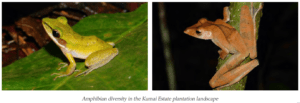
Water quality monitoring and the Plankton Diversity
Water is the most important natural resource on earth that all known living organisms are dependent on. Therefore, the BioD Team places the highest priority on this and focuses on protecting watersheds and maintain good water quality to support aquatic life as well as provide clean water to communities. The BioD Team has continuously monitored the water quality in PT SSS
to ensure that the actual water conditions in the water bodies across the estates remain as pristine as possible. For this, the BioD Team uses biodiversity of biotic organism in the water as an indicator of water quality. Aquatic invertebrate samples have been taken from streams and ponds located inside estate and conservation areas in Lada, Runtu, and Kumai estates. Sampling sites are fixed points and to date the BioD Team has recorded 100 Phytoplankton and 35 Zooplankton species.
Diversity sampling of plankton in Kumai, Lada and Runtu estates indicate that the water condition in the rivers surrounding the estate falls into the “medium condition” category. This means that the water is slightly polluted but showing signs of improving. In addition, the rehabilitation of riparian forest along the streams in PT SSS is showing positive effects by minimizing organic and inorganic pollution washout in all three estates.
Success Story from Rehabilitation Areas as Carbon Storage and Mother Trees Sources for Tree Seedling
The BioD Team has recorded positive progress from the rehabilitation activities that commenced in 2011. In some rehabilitation areas, trees such as Blangiran (Shorea balangeran) and Rengas (Gluta renghas) have grown above 10m tall and even become “mother trees” for the first time. The BioD Team collected a lot of seedlings and fruits from these, which are considered the second generation of the species. Some seedlings have also been recovered and moved into polybags in the jungle tree nursery site at Lada Estate. Here, the seedlings will grow for 10 -14 months before they are ready to be planted at a rehabilitation site. The BioD Team is proud to have reached this important rehabilitation milestone. With this, PT SSS is becoming an “independent” producer of some species of trees and can propagate these internally.
Furthermore, our rehabilitation areas have also become effective carbon storage sites. In 2011 there was nothing but grass in the rehabilitation areas, and from the first 80cm seedlings with little carbon storage value, many of these areas are now overgrown with 10-12m tall trees. The DBH (diameter at breast height) of some trees measure 43 cm which indicates healthy and strong growth and significant carbon sequestration. To better measure this effect and understand the carbon storage potential in the rehabilitation areas, the BioD Team have setup a 10,000 m² permanent plot that will be used as a live laboratory to measure the many aspects related to tree growth, species succession and plant diversity dynamics.
When planted trees form new canopy the area begins to attract other species, especially birds and rodents. These are also known as important seed dispersers, and from the five tree species originally planted, the BioD Team has recorded 10 “new” species in several rehabilitation sites. Since most of the tree species belong to large-seed trees, these are likely not dispersed by wind but by birds and mammals that have taken up residence in the rehabilitated habitat. The natural “recruitment” of seeds seems to work well in PT SSS areas and the BioD Team will continue to measure and monitor the effect of this local evolution
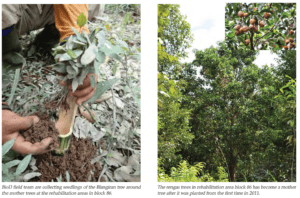
Birds Diversity in Rehabilitation Area
Rehabilitation activities in Lada Estate has been ongoing since 2011. The first phase of habitat rehabilitation was to plant as many native trees in degraded areas as possible to recreate a natural canopy cover.
The BioD Team assumed that a good tree diversity with extensive canopy cover will attract many wildlife species, since it provides shelter and foraging areas for particularly understory birds and microbats. To date, approximately 300 ha have undergone rehabilitation activities during which the BioD Team has planted ±184,766 native tree seedlings from 125 tree species. Despite difficult conditions, an estimated 65% of the seedlings have survived and are growing well today.
Concurrently with planting new trees, the BioD Team monitors biodiversity in the rehabilitation areas, and Lada Field 86, Division 2 is mainly used as a large experimental site. The understory bird diversity is a good indicator of habitat condition that also reflects the condition of the forest canopy.
They prefer habitat with dense canopy cover and are often cryptic and difficult to see, even when using binoculars. Therefore, mist-netting was used to capture birds in the area, in addition to direct observation. The bird monitoring began 4 years into the rehabilitation process, when the first planting activities were initiated. Subsequent monitoring reveals an increasing number of bird species throughout the years. From a mere 13 species in 2015, the BioD Team recorded 36 bird species in 2022. This is another testament to a successful rehabilitation process, and it is expected that the bird diversity will continue to increase in tune with the increasing canopy height of Field 86. The next big milestone is when endangered and critically endangered birds begin to return to the area in the future.
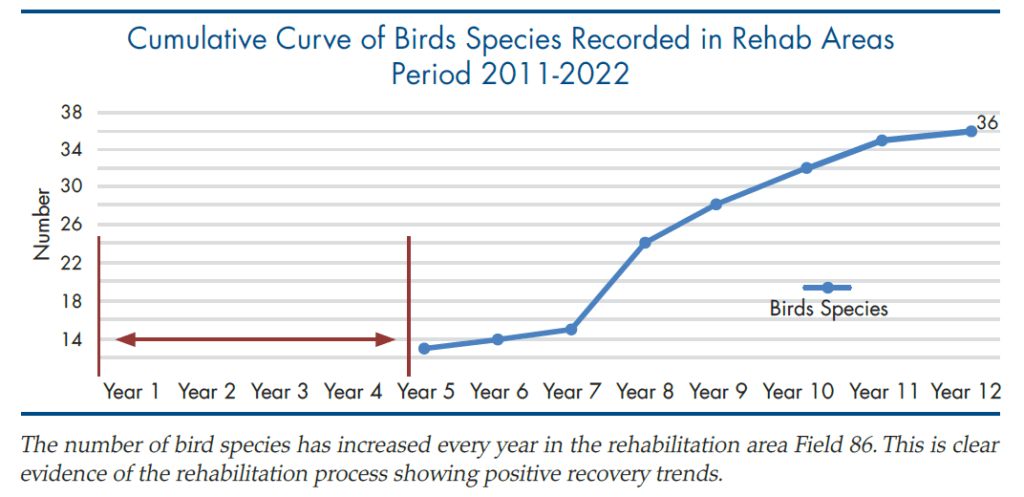
Building Science Communication by Attending Conference and Conservation Workshops
In addition to all the above-mentioned on-site activities, the BioD team is actively attending several national and international workshops and conferences that are relevant to biodiversity conservation and management. In multiple cases, representatives from the BioD Team have been invited to speak or present at conservation events, primarily about research and conservation activities in plantations landscape.
The specific topic of managing biodiversity in the plantation landscape has become increasingly important in a larger national as well as international context, because industrial agriculture at a global level is one of the main producers of CO2. At the same time, the BioD Team continues to engage with colleagues and experts at national and international level to learn and increase its own capacity and to become even more effective and valuable for the company in the future. The BioD Team has already become one of the leading biodiversity research and management entities and is known for its expertise within the palm oil sector and beyond.
Protecting Mangrove Forest
Mangrove is a special habitat type that is common along coastal zones and river deltas where the water is either saline or brackish. The vegetation consists of species that are specialized to live in saline and/or brackish water. Mangroves occur worldwide in the tropics and subtropics and even some temperate coastal areas, mainly between latitudes 30° N and 30° S, with the greatest mangrove area within 5° of the equator. This unique ecosystem plays important role in maintaining the natural ecosystem processes and therefore essential to keep. Since 2006, UP/PTSSS has maintained and managed approximately 1,200 ha mangrove forest as part of its estate concession area, or approximately equal to 16% of total conservation areas in PTSSS. This commitment to protect mangrove forest is in line with the 26th UN Climate Change Conference of the Parties (COP26), Glasgow 2021 target, to reach net zero emissions by 2050. In his remark at the Glasgow meeting, President of Djokovi of Indonesia committed to protecting forests (including mangrove) will form part of Indonesia’s climate action. Regarding the forest management, Indonesia has also changed its paradigm from forest product management to forest landscape management for a more comprehensive forest management. Indonesia, with support from World Bank and the Danish Foreign Aid has also initiated a mangrove ecosystems restoration programme. Indonesia is home to more than 20% of the world’s mangrove forests. With more than 3.3 million hectares of mangrove forests, Indonesia has the most extensive mangroves in the world.
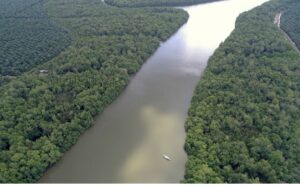
Mangroves acts as important spawning grounds for many commercial fish and prawn species and supports the livelihoods of fishermen and other local communities. UP/PTSSS is proud to be able to maintain and manage extensive mangrove areas as part of its landbank that benefit wildlife, local communities as well as act as a proactive contribution to the national and global climate change action
Conservation not solely about Orangutan
While much of the public connect rainforest conservation in Souteast Asia to orangutan, there is much more important biodiversity to consider as well. The risk of undervaluing small and less charismatic species often results in devaluing a forest habitat without orangutan to legitimize the eradication of such areas for industrial agricultural development. Therefore UP/PTSSS’ BioD team works to ensure the conservation management for all plant and wildlife species as part of a complete ecosystem.
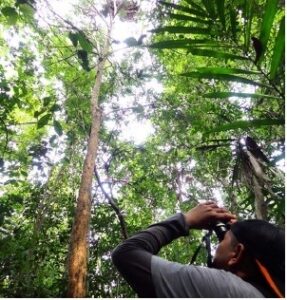
This begins with protecting the standing forest itself. Ensuring the forest standing by deterring illegal logging and clearing activities, combined with managed water table in peat areas form important priorities. Intact remaining forest forms a strong foundation for many important species of, for example, lizards, birds, snakes, insects and primates.
Quote of this year
“Every little space has biodiversity, irrespective of its protection status. Oil palm company should be encouraged to, and be responsible for, doing their part in biodiversity conservation, including collaborating with communities, Government and partner organization to manage biodiversity in its landbank and mitigate human wildlife-conflict”
-Silmi and Carl, Biodiversity Division, UP – PT SSS
Water Quality Monitoring and the Diversity Of Plankton
Water is likely the most important natural resource on earth that all known living organisms are dependent on. Therefore, it is of highest priority that the Biod Team focuses on protecting watersheds and maintain good water quality to support aquatic life as well as provide clean water to communities. The BioD Team has continuously monitored the water quality in PT SSS’ property to ensure actual water conditions in the water bodies across the estates remain as pristine as possible. For this, the BioD Team uses biodiversity of biotic organism in the water as an indicator of water quality. Aquatic invertebrate samples have been taken from streams and ponds located inside estate and conservation areas in the Lada, Runtu, and Kuma estate. Sampling sites are fixed points and to date the BioD Team has recorded 98 Phytoplankton and 34 Zooplankton species.
Data analysis of diversity plankton in Kumai, Lada and Runtu estate indicated that the water condition in the rivers surround the estate fall into the “medium condition” category. This means that the water slightly polluted albeit still above average. What is more important is the knowing that the rehabilitation of riparian forest along the streams in PTSSS is showing positive effects by minimizing organic and inorganic pollution washout in all three estates.

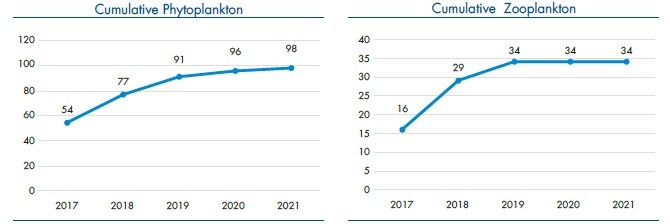
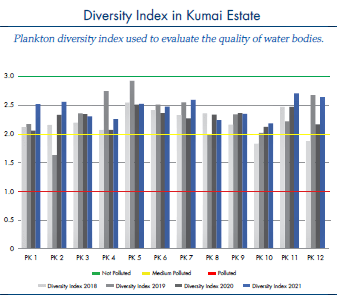
Bird Diversity in Rehabilitation Area
Rehabilitation activities has been undertaken since 2011 in several areas in PT SSS. The first phase of habitat rehabilitation was to plant as many native trees in degraded areas as possible to recreate a thicker canopy cover. A good tree diversity with extensive canopy cover attracts many wildlife species, since it provides shelter and foraging areas for, particularly, understory birds and microbats. To date, approx. 300 ha have undergone rehabilitation activities during which the BioD Team has planted ±174.000 native tree seedlings from 125 tree species. Despite difficult conditions, an estimated 65% seedlings have survived and grow well today.
In connection with rehabilitation activities, the Biod Team conducts monitoring of bird diversity in the rehabilitation area Field 86 Lada Estate Div 2. The understory bird diversity is a good indicator of habitat condition that also reflects the condition of the forest canopy. They prefer habitat with dense canopy cover and are often cryptic and difficult to see, even when using binoculars. Therefore, mist-netting was used to capture birds in the area, in addition to direct observation. The bird monitoring began four years into the rehabilitation process, when the first planting activities were initiated. Subsequent monitoring reveals an increasing number of bird species throughout the years. Eight years after rehabilitation began, 35 bird species have been observed in the area compared to 13 at the start of the monitoring process in 2015. The Biod Team is proud of the results emerging from the efforts PTSSS has put into the rehabilitation process. It is expected that the bird diversity will continue to increase in tune with the increasing canopy height of Field 86.
Leopard cat in the Plantations Landscape; Conservation and Biological Pest Control
In 2021, the research work on the leopard cat in oil pall landscape reached the publication stage. Although still ongoing, the paper “Activity and Ranging Behavior of Leopard Cats (Prionailurus bengalensis) in an Oil Palm Landscape”, was published in the known international journal Frontiers in Environmental Science Journal in March 2021. This is only one of several manuscripts that are being prepared by the BioD Team for publication in 2022 and 2023. These form very important milestones for the BioD Team, as these are the ultimate acknowledgement of the relevance of the work being undertaken on site.
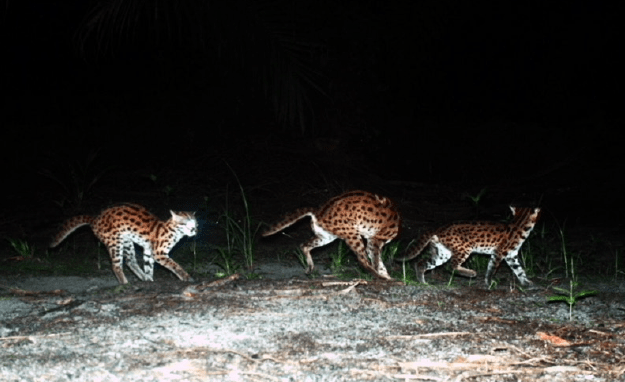
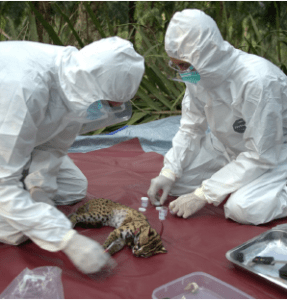
The BioD Team chose to publish it in an open access journal in the hope that more people with interest in the subject gain access to the information and experience obtained in the study. At the same time, we hope the paper will encourage more plantation companies to explore the advantages and effects of using wild cat and other vertebrates as biological pest control in oil palm plantations.
Socialisation and Awareness Programme
At the end of 2021, UP/PTSSS and BKSDA (Nature Resources and Ecosystem Conservation) Kalimantan Tengah province conducted a joint socialization programme with a focus on mitigating human wildlife conflict, particularly concerning possible accidents with venomous snakes. This initiative was setup after recording an increase in human-venomous snake encounter rate (e.g. sumatran cobra and king cobra) in PTSSS. In it, the UP/PTSSS and BKSDA team has successfully increased awareness, knowledge and capacity on safety and safe handling of venomous snake, especially concerning Sumatran Cobra and King Cobra). The BioD Team is proud to represent UP/PTSSS as part of this initiative to fund this initiative and build capacity amongst local communities. It is evident that communities and government institutions are keen to know more about snake ecology, behavior and handling technique to minimize the risk of snake bites.
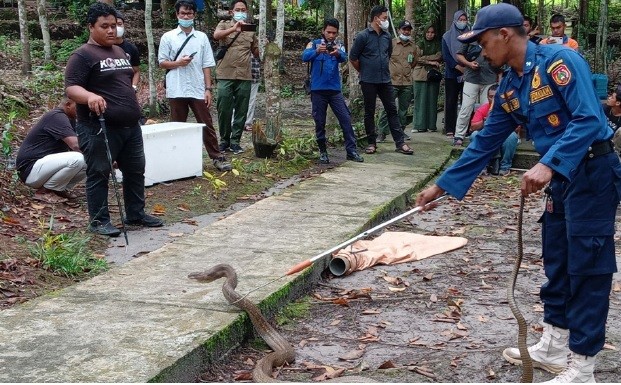
The BioD Team has also recorded increasing numbers of several snake species, mainly due to the abundance of food for these predators (e.g. rats) in the oil palm estates. While accidents have yet to be recorded, the growing snake populations will inevitably increase the probability of accidents happening too. Along with monitoring population sizes, the BioD Team conducts ecological research on the Sumatran cobra and king cobra, with all results shared with both the local authorities and communities in Pangkalan Bun.
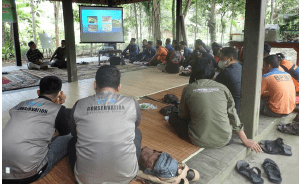
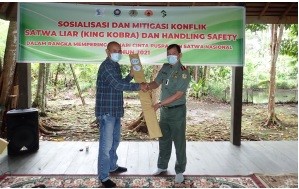
The elusive Bornean ground cuckoo
The elusive Bornean ground cuckoo, Carpococcyx radiceus, is a large terrestrial species of Cuckoo in the family Cuculidae. It is endemic to the island of Borneo and generally widespread across the island’s humid forests. Unfortunately, large parts of its preferred habitat are being lost from extensive agricultural and urban development activities and, from being common in the past, it is now listed as “Near Threatened” on the IUCN Red List and is only recorded in “good natural habitat”.
The species has been recorded occasionally in PT SSS’ conservation areas, where it forages the forest floor for insects and fruits, often following feeding frensies of bearded pigs, Sus barbatus, and Malayan sun bear, Ursus malayanus commonly found in our conservation areas. The species remain elusive and poorly known and its respective habitat have become a top priority for conservation managers across Borneo.
Saving critically endangered species
Fishing has always been a very important livelihood component to local communities. Despite the loss of traditional natural fishing grounds from excessive urban and agricultural development activities, fishing continues to contribute to community livelihoods in communities neighboring PTSSS. With our conservation areas often the only natural habitat left in a sea of agricultural and urban landscape, conserving these areas has become even more important.
Concurrently, with the loss of natural habitat surrounding PTSSS, the pressure to utilize resources in PTSSS’ conservation areas has increased significantly during the past decade. This has put increasing resource demands on the BioD team to patrol and manage the areas sustainably and as safely as possible. The team understands that no amount of patrolling and fencing can keep hungry humans out of the area and while “trespassing” into private property is illegal, it is unrealistic to keep local communities from using some of these resources.
Therefore, the BioD team has taken an integrated approach, where communities are generally allowed entry for subsistence purposes, provided they comply with “sustainability rules” set out by the BioD team. These rules prohibit, for example, fish bombing, using fish poison, logging and hunting. In certain areas, the use of fish nets is also prohibited, and during extreme dry periods, areas may be temporarily closed due to the high risk of causing bush fires.
In general, this approach has worked well and the BioD has built up a very good relationship with many adjacent communities which is an important factor that translates positively to the rest of PTSSS management. There is, of course, always a risk of “bad apples in the basket” and illegal activities and unwanted incidents happen simply due to violating the BioD rules and/or by pure chance. One such cases involved a regular fisherman who accidentally hooked a Malaysian giant turtle (Orlitia borneensis). This is an extremely rare and fully protected species in Indonesia and listed as “Critically Endangered” on the IUNC Red List.
There are only a few large reproductively mature individuals left in the wild and nesting grounds are few and far in between. There is a very high risk that this ancient species will be functionally extinct within the next two decades and the presence of a mature individuals in PTSSS’ conservation areas is akin to finding conservation gold. A fishing method that BioD prohibits is deploying line and hook overnight.
The reason for this is that it often results in the injury or deaths to species like turtles, otters and water birds, usually by drowning. Although the fisherman knew he had broken the rule, he reported the incident of having captured the Malaysian giant turtle instead of selling it for a very high price on the black market. The turtle’s flesh is very highly sort after both locally and in China. Quick response by the BioD team unhooked the turtle, treated the minor wound and released it back into its habitat.
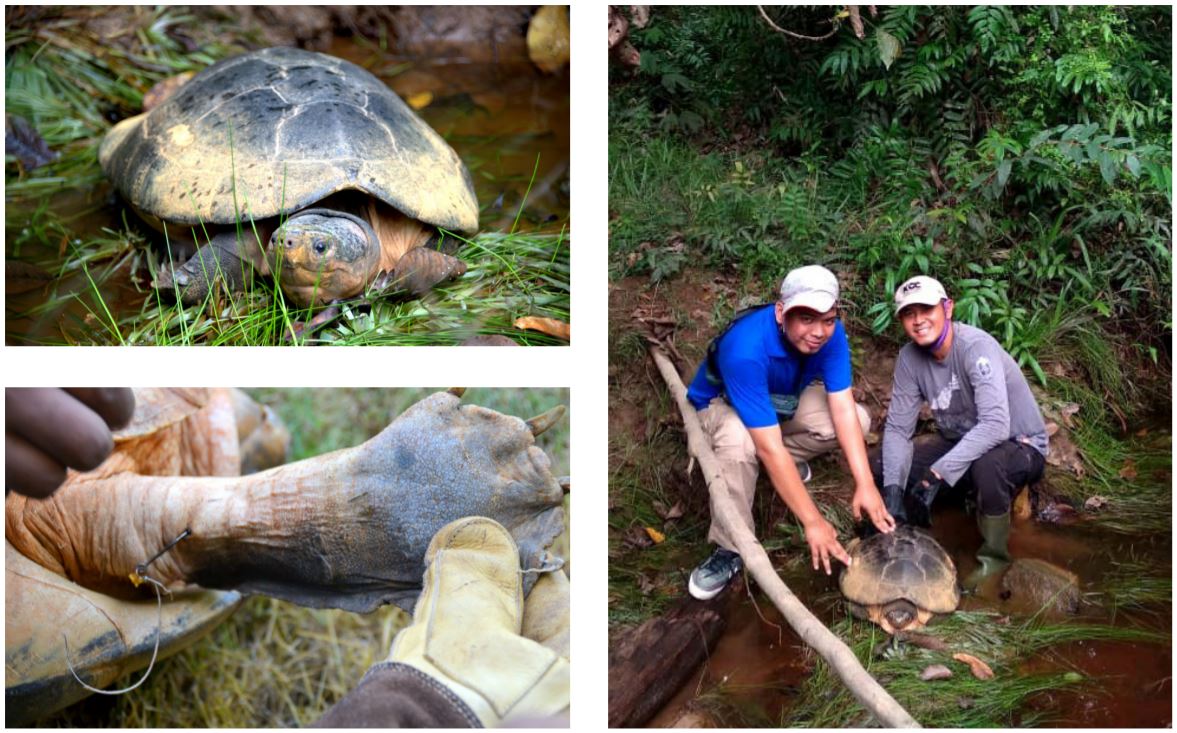
Orang Utans and their babies
Despite the relatively extensive conservation areas in PTSSS(7,500Ha), it remains too small to sustain genetically viable orangutan populations. However, it provides sufficient habitat for a number of individuals to thrive as well as reproduce actively in the area as long as they are left undisturbed. From the onset, PT SSS implemented a “no kill” policy of orangutan and did not consider them as a pest for the plantation. And, the positive conservation results of this strategy are emerging now.
For the past 10 years, the BioD team has conducted regularly awareness programmes internally with company employees as well as externally with communities who live adjacent to our conservation areas. Company staff and communities are aware of not disturbing orangutans when they encounter this animal. The result is positive i.e. there has been no reported conflicts with orangutans in neither PTSSS conservation areas nor inside the plantation land.
Whilst this is extremely positive, more focus on orangutan will be afforded in the near future, because orangutan conservation management in fragmented habitat requires habitat enrichment, landscape connectivity and possibly either reintroduction or replacement of a number of individuals to ensure genetic diversity and resilience. Only then, when such processes are undertaken smoothly in collaboration with the local authorities, will it be possible for our BioD to report “successful orangutan conservation accomplished”.
The BioD have continued to record and monitor orangutans. Whereas we have yet to capture on camera a picture of a large breeding male, we know that they must be around. The reason for this is that, almost every year the team has recorded a female orangutan with a baby. The fact that both mother and baby on the pictures appear healthy is a good sign, since it provides evidence that PTSSS’ conservation areas are home to reproductively active orangutan population(s). The BioD team will be focusing on habitat enrichment activities and, together with the local authorities, attempt to secure connectivity between, particularly, Tg Puting national park and PTSSS’ Kumai Estate.
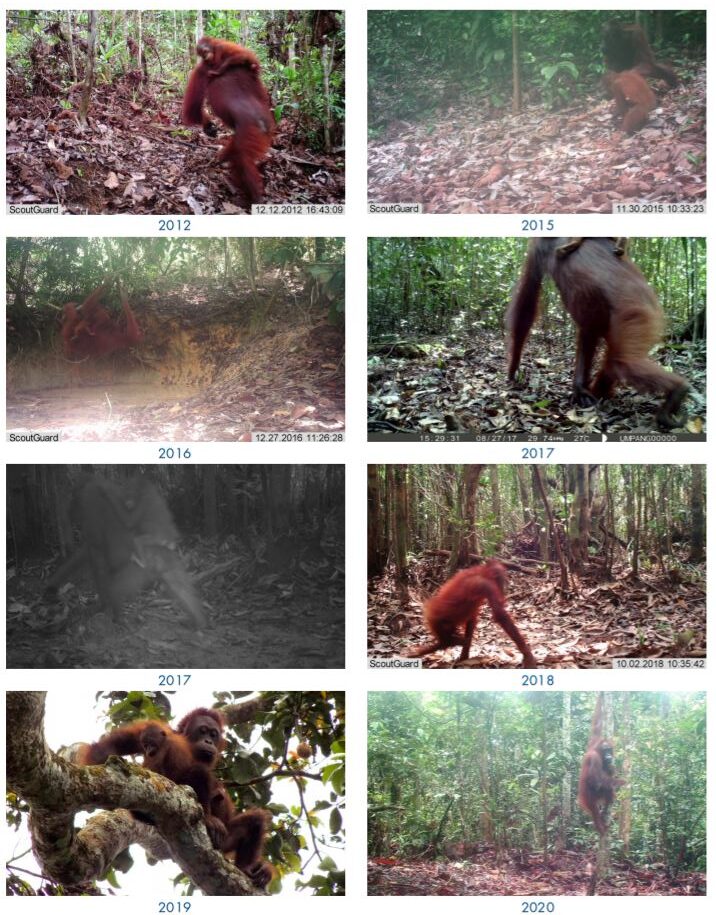
Monitoring bio-indicators in various water bodies
Streams, rivers and wetlands in and around PT SSS land areas play important roles in supplying both humans and wildlife with ecosystem services. The diversity of water plankton is often neglected in general conservation efforts, but they happen to be one of the best bio-indicators for water quality. This is mainly because they form one of the most fundamental lower part of the food chain that almost all other living creatures are dependent on. A good plankton diversity is a sign of good diversity of other species too, which in turn can be used to predict an area’s ecological health.
The BioD team has monitored plankton diversity in Lada and Kumai estate and use it to evaluate water quality. As of today, 106 species of plankton have been recorded to live on the surface water, indicating that the water quality in Lada, Kumai and Runtu Estates can be considered slightly polluted. Whereas this is considered “good” in a plantation context, the BioD will strive to reach a “not polluted” category in the future. Meanwhile, more work needs to be done to identify the potential source(s) of pollution and/or residual ecological factors from the original land preparation activities.
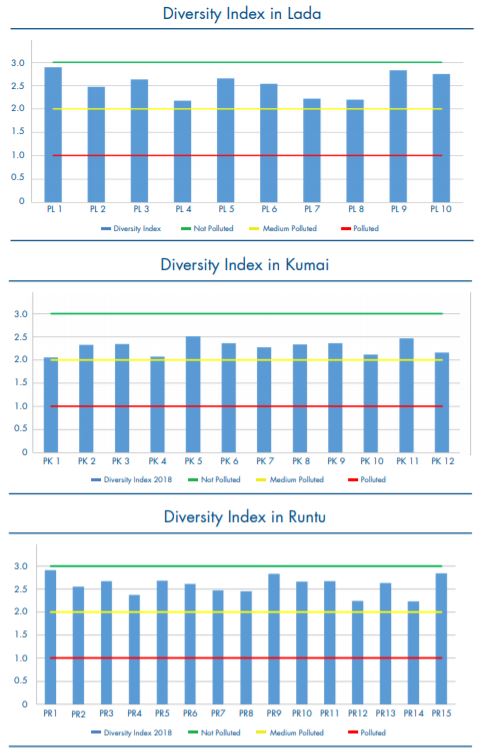
Leopard cat monitoring
Since 2015, the BioD team has monitored leopard cat population in Lada Estate, using 40 units of camera traps deployed in an 800 x 800meter grid system. In the first three years, the relative abundance of leopard cat increased peaking in 2018, however, in 2019 and 2020 data showed a significant drop with 2020 being the lowest on record.
Whereas it is not yet clear what has caused this downwards trend, it appears too significant to be simple statistical variation. It may be caused by dry season forest fires, decreasing habitat suitability, higher predator pressure (e.g. illegal hunting, increasing population of pythons), drop in prey density (e.g. chemical treatment of rats), diseases and/or other reasons. Nevertheless, leopard cat population continues to be high, with at least 2-4 individual/km2 compared to natural forest habitat (less than 1 individual/ km2).
The BioD team already knows that leopard cats are very effective rat predators. Rats constitute almost 75% of the leopard cats diet and an adult cat will often consume 2-3 rats per day.
A significant drop in prey availability, or a significant increase in predator pressure are the most common causes that can alter a predator’s population density. The BioD team has observed active Empty Fruit Bunch treatment in the study area that could easily cause disturbances and a temporary drop in the cat population. In addition, the number of reticulated python, Malayopython reticulatus, appear to have increased significantly.
Pythons are the most significant predator of adult leopard cats and they will do their best to avoid contact if possible. In 2021, the BioD will set up a comparative study to assess what may have caused the drop in leopard cat population. Hopefully, this biological controller of rats can be restored to its full potential.
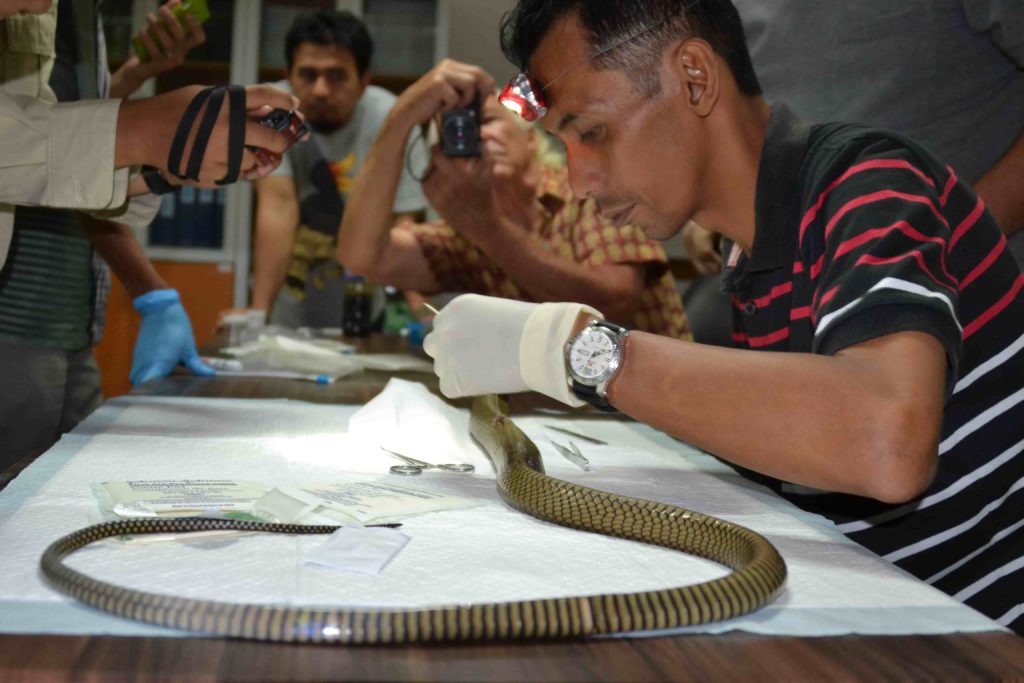
The work with the sumatran cobra (Naja Sumatrana) and king cobra (Ophiophagus Hannah), the world’s largest venomous snake has produced some amazing results. It has attracted one of the World’s best known and respected herpetologists, Romolus Whitaker, who continues to grace UP/PTSSS in Kalimantan and offer support and capacity building every year. The Biodiversity Division has also undertaken numerous camera trap surveys, bird and tree surveys to document the biodiversity within the company’s conservation areas. The BioD has recorded many of Borneo’s endangered species to date, among them Asia’s only great ape, the orangutan, Pongo pygmaeus.
Biodiversity Division’s Activities in the Past Years
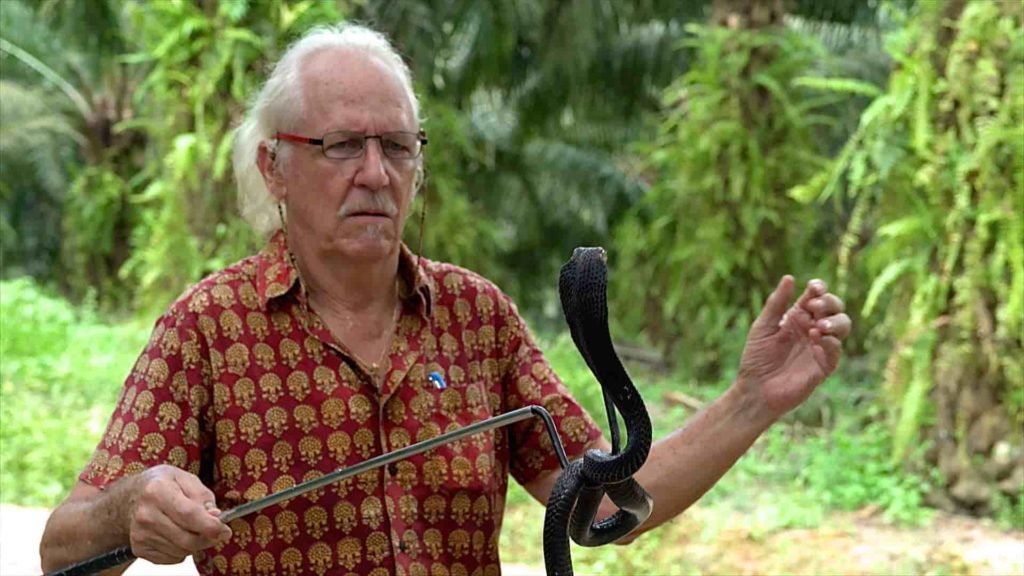
While these are exciting and inspiring stories about exotic species, the BioD is about far more than that. An entire host of other activities commenced right from the modest beginning in 2011, including developing a GIS database that incorporates literally all the team’s recorded data, be it from camera trap pictures, radio-tracking locations, number of tree seeds collected, time and place of illegal logging to recovery of aquatic fauna. Most of these stories are rarely told, however some of these will be revealed in the following.
Species record


To date, the BioD has recorded a stunning 68 species of mammals, 183 bird species, 48 reptiles, 22 amphibians, and 78 fish in PT SSS conservation areas. This is expected to increase significantly in the future as many more surveys are completed. In 2019, we found an additional 7 species which consist of 2 reptiles, 1 mammal, and 4 birds to the list bringing it to a new record in PT SSS.
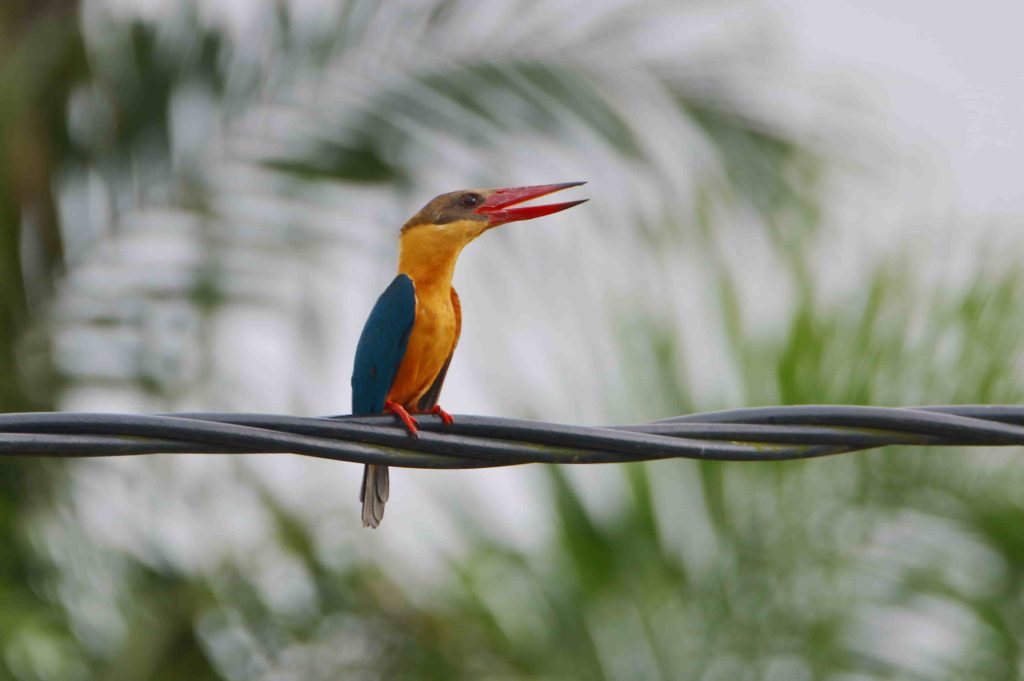
Rehabilitation Activities
Our Biodiversity Division continues to monitor the diversity of birds in rehabilitation areas Field 86. The monitoring purposes is to see the rehabilitation effect on the diversity of birds. We monitored understory birds which mostly use tree canopies for their daily activities and tend to be elusive in behavior. By use of mist nets, the monitoring started in 2015 and every year the same method has been applied in that rehabilitation location. The result is really interesting. We found that the number of bird species cumulative increased every year. In 2019, cumulative number of birds has reached 28 species. It means that there is a positive trend of an increasing number of bird species that use the rehabilitation areas as their habitat. We are proud of the fact that the rehabilitation program has proven to be a success and provides an increasingly comfortable habitat particularly for birds. In addition to birds and as highlighted during 2018, we were also thrilled to identify the clouded leopard that has started to use the rehabilitation areas. We hope for further progress in the years ahead.

Bird diversity at an increasing trend along the year.

The aerial photos of the rehabilitation areas in field 86, Lada Estate Div II.
Efforts to propagate jungle tree seeds for our rehabilitation activities


The jungle trees nursery in Lada Estate and seed of fruit trees
Propagating the native Borneo fruit trees is the main program in our nursery site which is located in the Lada and Runtu Estate. The fruit trees are very important in providing food sources for a lot of animals in PT SSS conservation areas. Under our rehabilitation programs, we are enriching the forests with these important fruit trees. During 2019, we have planted 8492 jungle trees in our rehabilitation areas. As of todate, we have a stock of 34,685 jungle tree seedlings in our nursery. Not just fruit trees, we also prioritize to propagate the trees from the Dipterocarpaceae family or commonly called Dipterocarp trees. The Dipterocarp trees or Meranti which is their local name are diminishing due to high demand for wood extraction, mainly illegal logging. As of todate, we have around 4000 Dipterocarp tree seedlings which consist of 4 different species. In the next few months the seeds will be ready for planting in our rehabilitation and conservation areas.

Sprouted seeds of the Tengkawang trees, one of the species of dipterocarp trees. In the past before palm oil production expanded, the native people of Borneo used the tengkawang seed to extract oil for cooking purposes.
The value of the wetland Pangkalan Durin
The Pangkalan Durin wetland area of 28 Ha is located in Lada Div I. Historically the Pangkalan Durin wetland was owned by some people in the village or Desa of Pangkalan Durin. In 2012, the group of people offered the areas of wetland to PTSSS to be planted with palm oil trees under the Plasma scheme. Due to the conservation qualities of the land the Company together with the BioD offered the owners of the land to buy it or offer them a similar land area size to be planted with oil palm under the Plasma scheme in another location. After some negotiations, the Pangkalan Durin wetland area of 28 ha was bought and converted to a permanent conservation area which has given a lot of value for biodiversity conservation and ground water management.
The wetland has become a paradise for many water birds. In particular during the dry season where water birds like Whistling duck, Yellow bittern, Egret, Waterhen, Moorhens and Purple heron can be found. The most impressive and pleasing finding in the Pangkalan Durin wetland area was the presence of a group of Storm stork (Ciconia stormi) which is an Endangered species criteria in reference to IUCN Red List. At least 4-5 individual storm storks were recorded during the dry season from September-November 2019. It was a meaningful decision that was taken by the company to protect this particular wetland and convert it into a conservation site


The Storm stork (Ciconia stormi) hanging around in the Pangkalan Durin wetland area.
The Leopard cat monitoring
Since 2015 we have started monitoring leopard cats in Lada Estate using 40 units of camera traps spread in a 800 x 800 meter grid system. Every year We keep track of their abundance and population. The abundance of leopard cats increased as well as their population. Although the data in 2019 showed a drop of abundance of leopard cats, we think it is due to a change in capturing probability.
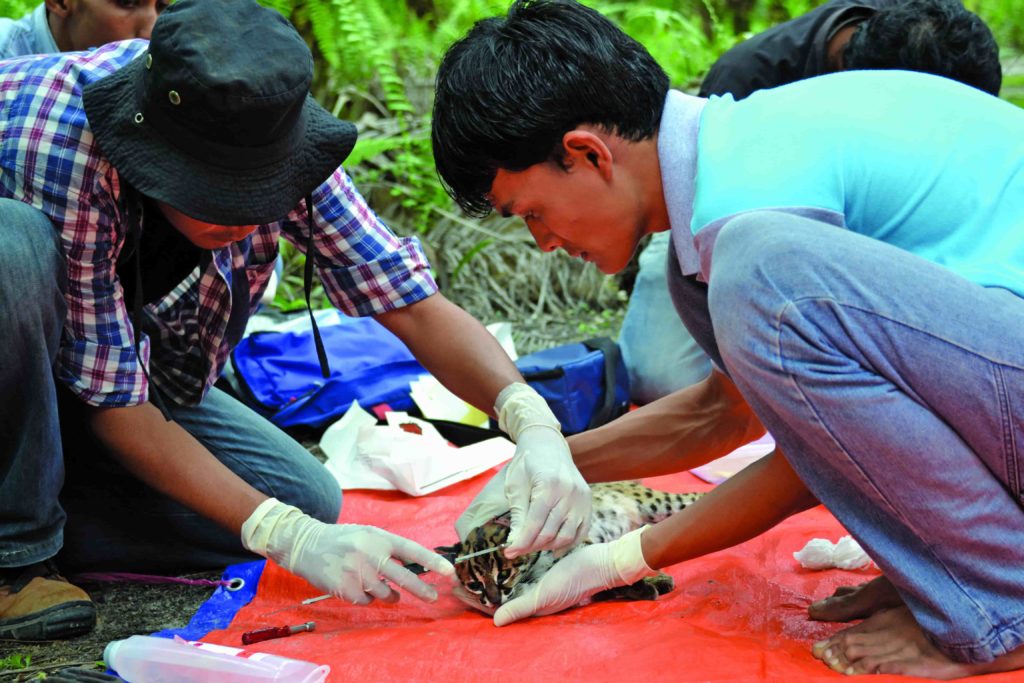
Installation of collar for radio tagging of leopard cat
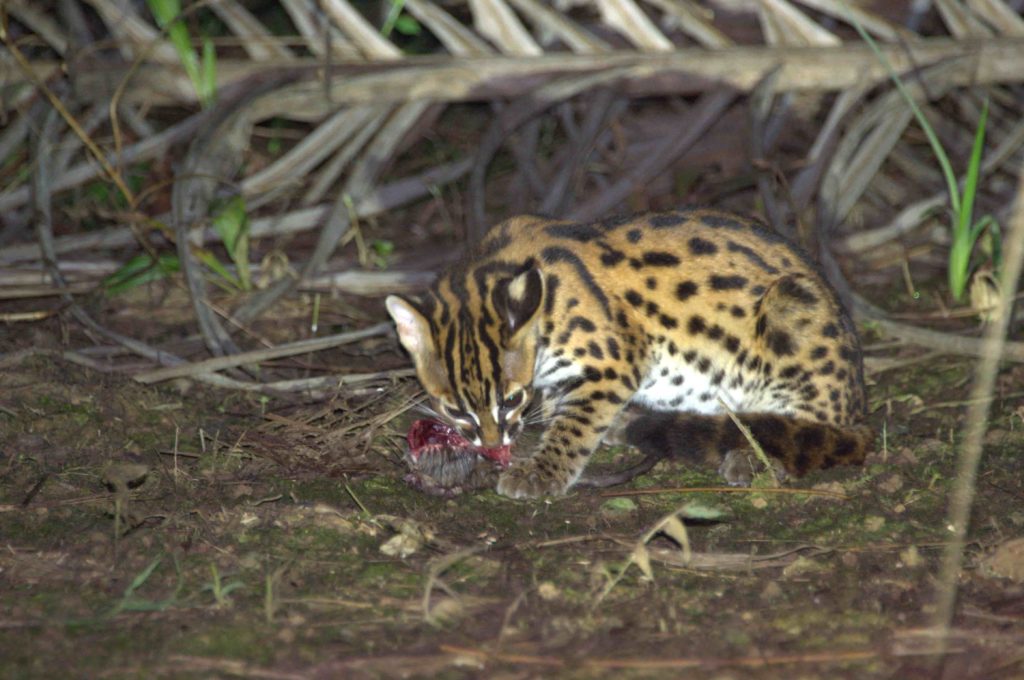
We assume the dry season which caused smoke in the air and heat might have changed the leopard cat activity pattern. The leopard cat density is considered very high in the oil palm estate with at least 2-4 individuals/km2 compared with the conservation forest which mostly houses less than 1 individual/ km2. We have observed that the leopard cats are very effective when hunting rats. Our observation data from the cats fitted with radio telemetry indicated that one individual leopard cat can eat 2-3 rats per day. The leopard cats are smart and intelligent, they can hunt the rat on the ground, under heap of palm fronds, and in the oil palm trees. We also recorded many photos from our camera traps showing leopard cats carrying the rats after a successful hunt. It is our clear opinion that Leopard cats in oil Palm plantations are excellent means of biological control to reduce the rat population


Leopard cats with their meal (rat)
Monitoring of bio-indicators in various water bodies
The water bodies like streams and rivers around the land concession of PTSSS play an important role to ensure the future conservation of wildlife and even human beings. The diversity of the water plankton is sometimes neglected as a holistic part of conservation efforts. Bio indicators like plankton can reflect how the practices of the palm oil business affect the area’s water quality.
We have monitored the plankton diversity on Lada and Kumai estate and used that as reference to evaluate water quality. As of todate, 106 species of plankton have been recorded to live on the surface water. Based on Diversity Indices of plankton, the quality of the water in Lada and Kumai Estate is considered fairly good. The existence of plankton is very important for aquatic life and will continue to be monitored going forward.


The plankton diversity indices in the Lada and Kumai Estates are used as indicators of water quality.
Research conducted on Smooth Otter
PTSSS has around 1200 Ha of mangrove forest under its conservation areas in Lada Estate. The mangrove forest is a habitat for at least 3 species of otter, like the Small clawed otter (Aonyx cinerea), Smooth otter (lutrogale perspicillata) and Hairy-nosed otter (Lutra sumatrana). The presence of the otter in the mangrove conservation areas is a good sign of the state of the mangrove forest itself. In 2018 we had conducted research using camera traps in the mangrove forest areas. The interesting result was that we found the presence of the Lutra sumatrana in our mangrove conservation areas.
The status of this species is considered as an Endangered species criteria in reference to IUCN Red List. We have published the short note of “First Record of Hairy-Nosed Otter (Lutra sumatrana) in Southern Central Kalimantan, Indonesia” in the reputable “IUCN Otter Spec. Group Bull. 36 (2) 2019. We published our story about Lutra sumatrana and its presence in the Southern part of Borneo. The last reference only recognized that the Lutra sumatrana only was distributed in the Northern part of Borneo like Sabah and Brunei.

Smooth otter (lutrogale perspicillata)
Attended seminars about conservation and sustainability
The BioD staff actively participate in local and international forums in the form of seminars and conferences during the year. The purpose is to share our knowledge of conservation and learn from others other practitioners, academicians and thereby to improve the conservation effort in PT SSS. In 2019 our BioD attended the Song Bird seminar and Sustainable Palm Oil seminar in Copenhagen at the 28-29th May 2019 which was hosted by Copenhagen Zoo. The BioD also attend the 29th International Congress for Conservation Biology (ICCB), Kuala Lumpur, Malaysia. We presented our research paper on leopard cat study using radio telemetry in the oil palm landscape.


Attending conference on conservation of Biodiversity in Copenhagen, Denmark and Kuala Lumpur
Socialization on the importance of conservation to the local community surrounding PT SSS is on our routine agenda . We share information about the conservation efforts conducted by the company. We also encourage the local community to support the program because the value of conservation is not just for the company, but also for the community who live around the areas as well as the future generations of people. We present many pictures and videos, and use simple sentences to explain the importance of conservation and the value of it. By doing that, we hope the community will continue to be our partners and to further understand the efforts taken to protect the conservation areas and actively take part in protecting the conservation areas with us. We also made painting competitions with conservation themes with kids in elementary school as part of their familiarization towards conservation efforts and its importance. Because they are the ones who will own the environment in the future.
Peat Management
Since 2010, our Group has strictly adhered to No Deforestation and No new development on peat soils regardless of its depth policy. For existing plantation areas with Peat Soils best management practices are in place to minimize any adverse impact by operating on these fragile soils. The total land bank of United Plantations Berhad as of 31 December 2024 is 62,458Ha. The total planted area under oil palm is 46,227 Ha of which Malaysia has 37,507 Ha and 8,720 Ha in Indonesia. In Malaysia the total peat area is 4,130Ha and in Indonesia it is 280Ha, i.e total peat is approximately 4,410Ha equal to approximately 9.54% of our total oil palm planted area.
Our Research Team has re-assessed the peat area in our Indonesian estates, where significant areas of peat subsided over the years, and as a result , some of the peat area with high water table has been set-aside as peat rehabilitation area. This is in line with the latest peat inventory which has been submitted to RSPO Secretariat.
Water Management
Water management is particularly important on the acid sulphate and peat soils. These soils are fragile and if over drained, they will rapidly deteriorate. On the acid sulphate soils, the water level should be maintained up to the jarosite layer, submerging the pyrite (FeS2) and preventing it from oxidizing to sulphuric acid, which can cause a steep drop in the pH.
Weirs for Moisture Conservation
To conserve moisture during these periods, a series of weirs are constructed across the collection drains to hold back water and raise the water-table to within 50-75 cm from the surface. To regulate the height of the water table, wooden planks are slotted into the desired level.
The density of weirs varies with the soil type, slope, rainfall and cropping system. On the average, one weir is provided for every 40 to 60 hectares or every 600-1000 m along the collection drain. Assisted by the water gates at the discharge ends of the main drains, the weirs are very effective in minimizing the adverse effects of the moisture stress.
United Plantations has recently engaged an external consultant to undertake a peat drainability study in our Malaysian operations to better understand the hydrological characteristics of our peat areas.
Monitoring of meteorological parameters
Weather stations have been set up at strategically important locations throughout our Group. These provide a large amount of micro-climatic information critical to, particularly, make accurate fire-risk predictions.
Being able to predict the risk of fire allows the management in each estate to implement proactive measures, to prevent and minimize the risk of fire, as well as to be on high alert with firefighting equipment, in case of fire outbreak.
For more information, please click here to view our Standard Operating Procedure on peat soil management.
Energy Management
We, at UP, are committed towards energy reduction and promoting renewable energy. The implementation of green technology has resulted in reduction of fossil fuel usage and thus reduced greenhouse gas emissions. The fossil fuel consumption in all of our operations is closely monitored as part of Life Cycle Analysis (LCA) study.
Biomass Reciprocating Boiler
The first Biomass Reciprocating Boiler (BRBI) was successfully commissioned in 2006 and supplied green steam to Jendarata Palm Oil Mill as well as the Unitata Refinery, thus playing a crucial role in reducing the fossil fuel consumption at the refinery.
Since then the company has built and commissioned another 7 biomass reciprocating boilers with the latest unit at UIE (M) installed in 2019.
Biomass boilers in our mills are also equipped with VORSEP dust particle minimizing system, and an automatic fuel feeding system with greater energy efficiency, reduced dust emissions and a lower labour requirement.
Biogas to Grid
Today, all our mills are equipped with biogas plants, and the biogas generated from the palm oil mill effluent is mainly used in our own operations as is or after being converted to electricity. If this is not possible, which is the case at our UIE mill, it is sold as electricity to the grid or used as a substitute fuel in the mill boiler. In 2024 a total of 6,945MWh of green electricity was generated from the UIE biogas plants and sold to the grid, which represents a decrease of 8% compared to 2023.
Photovoltaic Cell Pilot Project
A pilot project was initiated in 2020 to evaluate the feasibility of photovoltaic cells to produce green electricity from sunlight to offset electricity consumption from the grid. Located on the roof of the Tissue Culture Laboratory, these cells generate about 525 kW/day for the Tissue Culture Laboratory, with the unutilised electricity channelled to other laboratories in the Research Department. A total of 201MWh of renewable electricity was generated in 2023. In May 2023, additional photovoltaic cells were installed at the Tractor Pool which generated a further 329MWh of electricity over the year 2024. In addition a larger photovoltaic project was commissioned at the Unitata Refinery in May 2022, which generated 7772MWh of electricity throughout the past year. The most recent addition is an array set up in Tanarata Estate which generated 93MWh of electricity in 2024. For the UP group a total of 1,356MVh of renewable electricity was generated during the year.
Conversion to Energy saving T5 Fluorescent lamps
As part of our efforts to improve energy efficiency and to reduce wastages, there is an on-going exercise to replace the existing T8 fluorescent lamps with the newer T5 lamps.
Some advantages of the T5 tubes are:
- A 25% gain in luminous efficacy vis a vis T8 lamps
- Light output that is closer to natural light spectrum which is beneficial to human health
- Less heat emitted during operation, with potential saving in air conditioning costs
- Minimal (5%) degradation in lumen output over the life of the lamp as opposed to 20% degradation for the T8 lamps
- Does not require replacing existing fixtures
To date 99% of the T8 lights at the Unitata refinery and another 60% of the lights in several estates which numbered in excess of 4,000 lights have been converted to T5 lighting, resulting in an energy saving of 92.5kW. Going forward the Company is also actively exploring other energy efficient measures.
Integrated Pest Management and Chemical Usage
Conducting our operations under the best principles of agriculture and to reduce chemical and pesticides usage thereby minimising the impact to the natural environment.
UP has a strong commitment to Integrated Pest Management (IPM), and in line with the Principles and Criteria of the RSPO we are continuously working on reducing the usage of pesticides. Our employees’ safety is a top priority and in this connection all sprayers are trained extensively and are required to use full Personal Protective Equipment.
According to CropLIfe International, a global federation representing the plant science industry, 42% of crop production throughout the world is lost as a result of insects, plant diseases and weeds every year in the tropics crop losses can reach as high as 75%.
Careful use of pesticides can deliver substantial benefits for our society through increasing the availability of good quality and more affordable priced food products. However, pesticides are inherently dangerous and it is in everyone’s interest to minimize the risk they pose to people and the environment.
According to FAO, IPM, means a pest management system that in the context of the associated environment and the population dynamics of the pest species, utilizes all suitable techniques and methods in as compatible a manner as possible and maintains the pest population at levels below those causing economically unacceptable damage or loss.
Our commitment towards continuous improvements has resulted in minimizing the usage of pesticides in relation to other major oil seed crops, primarily through Good Agricultural Practices and improvement in planting materials. Today, UP’s use of pesticide is 5-8 times lower per tonne of oil produced compared to Rapeseed farmers and about 40-50 times lower compared to Soybean farmers.
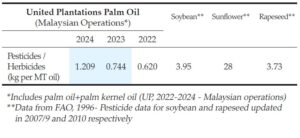

Establishing Beneficial Flowering Plants
To date a total of 295,640 broadleaf flowering plants have been planted in our plantations to encourage parasite and predator activities which is a vital part of our IPM programme. There has been a steady increase in the number of beneficial plants which were planted in our Malaysian and Indonesian properties over the last few years to function as shelter and food source for the beneficial insects.
However due to replanting activities in most of the Malaysian estates as well as the loss of beneficial plants to flood, beneficial plants numbers have set back for some years although numbers are expected to further rise in the coming years.

Surveillance and Monitoring of Pest Outbreaks
The key to minimizing both the economic impact of pest and environmental impacts from excessive use of pesticides is by regular surveillance and monitoring. Treatment is only carried out when the damage exceeds established critical thresholds. Several census gangs are deployed on each estate to survey the extent of pest infestation. This is coupled with regular aerial reconnaissance in order to track and pre-empt pest build-up thereby more effectively treating potential outbreaks.
Use of biological pesticides and pheromones
First line treatment against leaf pests i.e. Nettle Caterpillar and Bagworm is by biological treatment in the form of Bacillus thuringiensis. The use of pheromones to trap Rhinoceros Beetles thus reducing the dependency on chemical pesticides is also adopted on all estates.
Besides trapping out the beetles, pheromone traps also provide management with statistical information of the severity of the beetle problem and supplements the chemical spraying operations to minimise beetle damage.
Overpopulation of rats, beetles and various kinds of weeds can have a profound negative impact on production yield. UP Group attempts to minimize the usage of chemical control-agents where possible, and the BioD undertakes a number of research projects to maximise the usage of biological control agents where possible. For example, leopard cat (Prionailurus bengalensis) is one of the key-predators of rats and other small rodents, and preliminary studies on the effect of these cats as rat-controllers in a plantation landscape is ongoing.
The results have been very promising, and UP’s biodiversity team is currently exploring ways to enrich the habitat conditions for leopard cats, to maximise the population density and thereby reduce the effect of rat damage. Apart from leopard cats, the team also records ecological parameters along with the effect on rat populations of other predators such as barn owls (Tyto alba), Spitting cobra (Naja sumatrana) and water monitor lizards (Varanus v. salvator).
Below is the 5-Step Integrated Pest Management Programme approach taken to contain and/or control Bagworm outbreak:
|
• Integrated Pest Management |
E.g. planting of beneficial plants to enhance the natural parasitic and predator activities against bagworm. To date more than 295,640 beneficial broadleaf flowering plants have been planted in both Malaysia and Indonesia. |
|
• On-going Monitoring |
Census gangs deployed on each estate who take random frond samples in a predetermined pattern throughout each estate. These fronds are subsequently subjected to insect counts and damage assessments by trained personnel. |
|
• Aerial Surveillance |
Regular aerial reconnaissance is carried out to better detect, pre-empt and treat potential outbreaks. |
|
• Use of biological control agents |
E.g. Bacillus Thuringiensis as the first line of treatment against an outbreak. |
|
• Final Resort |
As a final resort and only when Steps 1 to 4 have proven to be futile in containing or controlling the natural equilibrium between pest and beneficial predator, our trained personnel intervene with the specific treatment of trunk injection using monocrotophos. |
Mowing of Harvesters’ Paths
Blanket weeding is discouraged, soft weeds with shallow root system which do not grow to excessive heights are encouraged outside the weeded palm circle. Harvesters’ paths are mowed. This practice maintains a flora which is favourable to natural enemies of crop pests and reduce soil loss.
Use of Safer Class 3 & 4 pesticides wherever possible
In line with the RSPO’s continuous improvements initiative the Company’s Group Sustainability Committee monitors and reviews the pesticides usage, exploring avenues to reduce overall pesticide usage as well as evaluating alternative safer pesticides. In this context, UP has since February 2008 been working towards minimizing the usage of Paraquat, which has been documented in the annual RSPO Surveillance Audits. In May 2010, Management took the decision to voluntarily phase out the usage of Paraquat, a goal which was realized with effect from October 2010.
Monocrotophos phased out completely
In 2020, we have successfully phased out monocrotophos, which is a key milestone. Concerted efforts to source and evaluate alternatives for the Class 1A insecticide, monocrotophos, have been ongoing since 2006 through our collaboration with several multinational chemical companies, amongst others Bayer and BASF (Germany), Syngenta (Switzerland), Cheminova (Denmark), Sumitomo (Japan), Rainbow Agrosciences (China) and UPL (India).
Multiple experimental and existing insecticidal compounds have been evaluated for bagworm control with our partners with no success in matching the efficacy of monocrotophos. In recent years our Research Department was able to test new formulations of an existing insecticide that hitherto gave inconsistent bagworm control. It has now been established that with these new formulations we are able to have a commercially viable and effective alternative to monocrotophos with a Class II toxicity rating which is a much safer product.
As a result, we have since September 2020 successfully phased out the use of monocrotophos and metamidophos for trunk injection to control bagworm. This is a key milestone as our plantations can now dispense with the use of WHO Class 1A or 1B pesticides for bagworm control and replaced them with an equally effective product.
Nonetheless, bagworm is an endemic pest in Lower Perak and the Federal Government has gazetted this as a “Dangerous Pest” on 15the November 2013. It is an offence under the Plant Quarantine Act 1976 if this dangerous pest is left without any control and can be fined up to RM10,000.
Outbreaks of bagworms continue to occur in the properties neighbouring UP in the State of Perak, West Malaysia. This is of great concern as it is important that collaborated effort by the government authorities, neighbouring smallholders and other plantations are put in place in an attempt to eradicate this serious pest.
UP is working closely together with its neighbours as well as the authorities in the form of the Malaysian Palm Oil Board (MPOB) to achieve positive progress on this concerning issue. UP has extended its service to the neighbouring plantations the use of its airstrips for aerial bagworm control and also taking the plantation managers for aerial reconnaissance flights to monitor the extent of bagworm infestations in the region.
The quantity of agrochemicals (fertilizer nutrients and pesticide/ herbicide) per tonne of oil produced in oil palm cultivation at UP over the last three years remain substantially lower than annual oilseed crops such as soybean, sunflower and rapeseed, a reflection on the resource utilization efficiency of the oil palm crop.
Pesticide usage in 2024 was higher than 2023 level in Malaysia with more herbicides used in the immature areas and due to an increased need to control leaf pests in mature plantings. In our Indonesian operations pesticide use in 2024 was slightly higher than the preceding year but it is still in the low range. The direct fossil fuel energy consumption per tonne oil produced in 2024 remained similar to 2023.
Agrochemical and Energy Inputs in the Cultivation of Oil Palm and Other Oilseed Crops

Biological Control Agents to Substitute for Chemical Insecticides
Leaf eating pest outbreaks in immature oil palms will need to be treated with insecticides. The use of biological insecticides such as Bacillus thuringiensis is encouraged at this young crop stage to minimise collateral damage on beneficial insects in the field as well as to reduce dependency on chemical insecticides.
Fortunately, we have not had any severe infestation in neither our Malaysian operations nor in Indonesia over the last several years, hence there has been no use of Bacillus thuringiensis.
Quantity (kg) of Bacillus thuringiensis applied in our Malaysian and Indonesian operations

Harnessing advances in pesticide technology to reduce herbicide inputs in mature oil palm
In the wet tropics, weed species rapidly cover the ground and if left unchecked, will encroach into palm circles to compete with the palms for nutrients and water as well as interfere with field operations. Consequently, herbicides are an important tool to keep the palm circles weed free. Of the total pesticides used in a mature field, herbicides will therefore account for more than half of the total pesticide load.
Thus, any improvement in the length of control for weeds will contribute significantly to a reduction in pesticide use for mature palms. Over the years United Plantations has actively cooperated with leading agrochemical manufacturers to evaluate a range of herbicidal compounds.
Arising from the close collaboration with Bayer CropScience a new compound, Indaziflam, with long lasting weed control was extensively tested in our fields and was found to be able to slash the number of herbicide rounds from four rounds a year with the standard herbicide mix to two rounds a year with the Indaziflam combination. This confers the clear benefit of almost halving the herbicide in a field and greatly improving labour productivity where this herbicide can be applied. Whilst introduction of Indaziflam has contributed to reducing the overall herbicide usage per hectare in our operation, there has been an upsurge in herbicide use in our Malaysian operations in 2024 due to a relative in newly mature fields which require more weeding rounds than the old mature fields. In contrast our Indonesian operations has been stable in herbicide use in the past year with more even weather conditions.
Below is the statistics of herbicide usage (kg a.i./ha/year) in mature oil palm:

Calibration for Pesticide Application Equipment
The Company engages the services of equipment suppliers to regularly monitor the calibration of the equipment to avoid application error (under and over applications) and safety to operators. Regular training and refresher courses are implemented, all of which are audited by accredited auditors of the MSPO and RSPO every year.
Biological pest control of rats
Rats thrive in the oil palm ecosystem with an abundance of food sources (palm shoots, fruit mesocarp, kernels, weevil grubs etc.) as well as plentiful harborage amongst the cut frond heaps. The common rat species encountered in an oil palm field are the Malaysian wood rat (Rattus tiomanicus), padi field rat (Rattus argentiventer) and the house rats (Rattus rattus diardii).
With its prolific reproductive rate, whereby a sexually mature female could conceive multiple times a year and produce an average of 8 pups in each litter, rat populations can mushroom and threaten the oil palm plantings within a short time, given the right conditions.
Various researchers have estimated crop loss caused by rats feeding on fruit mesocarp to be able to reduce oil yield by 5 – 10% (Wood, 1976; Liau, 1990). Badly gnawed male and female inflorescences, as well as young palms killed by rat attacks further contribute to crop loss.
Barn Owls
The Barn owl is a much-loved countryside bird by oil palm planters as it predates on rats, resulting in major reduction of rodent damage. It is also one of the most widely distributed birds in the world.
This bird is the best partner to growers due to its ability to adapt well to oil palm plantations. It survives on a staple diet of 99% rats. It is estimated that a pair of barn owls together with its chicks consume about 800 to 1,000 rats per year.
The barn owls are medium sized (34-36cm) with long legs that have feathers all the way down to their grey toes. The owls have large, round heads without ear tufts and pale heart-shaped facial discs. The owls ingest the rats whole and use their digestive juices to dissolve the nutrients of the fleshy parts. The tougher indigestible parts such as the bones, skulls are regurgitated out.
Barn owl population in tandem with preys’ availability can be expanded in the plantation by construction of boxes at vantage points – about 5 meters from the ground and shaded by the palms’ canopies. A zinc baffle or collar should be placed on the pole to prevent snakes etc. from predation of the owl’s eggs and new born chicks. These boxes should be inspected regularly and repaired where necessary in order to optimize its occupancy.
At United Plantations, the barn owl is the first line of defence against this serious pest. Where owls could not cope with the high rat population, first generation rat baits such as warfarin are employed to selectively bring down the population. Warfarin baits are preferred as they are relatively safer to barn owls than second generation rat baits. Based on the low usage of rodenticides in the past years, we can infer that the barn owl programme has been fairly successful in keeping rats under control.

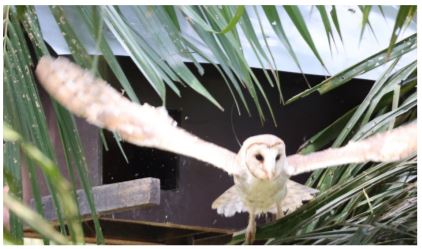
Leopard cats
Since its formation in 2011, the Biodiversity Division in UP/PTSSS has recorded a surprising number of leopard cats, Prionailurus bengalensis, in the estates. The species is common throughout Southeast Asia in undisturbed as well as altered habitats. They are common in some oil palm estates; however, little is understood about their role as rat predators in a plantation landscape although studies have shown that rats and mice constitute 93% of the leopard cat’s mammalian diet (Rajaratnam at.,2007). Field observations demonstrate there is a negative relationship between cat numbers and rat population, with high abundance of cats associated with low rat numbers and vice versa (Silmi et al.,2013)
Since 2015, nine individual leopard cats have been collared and continuously tracked for 23 months and aided by 40 camera traps set up in a 800m by 800m grid generated estimates of the respective cats’ home-ranges and dispersal patterns. With at least 2-4 individual/km2 the leopard cat density in the oil palm estate is much higher than in the conservation forest with a density of less than 1 individual / km2. Leopard cat population in the study area declined in 2019 and 2020 and studies are underway to determine the cause of decline.
The cats are strictly nocturnal and prefer to hide and rest in thick bush, primarily consisting of sword-fern (Nephrolepis sp) during day-time, but forage both on the ground and in the palm canopy at night. Some preliminary results conclude that leopard cats can feed, reproduce and thrive in a palm oil estate, with a mean home range (95% MCP) for male leopard cats 1.39 km2 (n = 5; SD = 1.40 km2 ) and a mean home range of female cats smaller at 1.26 km2 (n = 4; SD = 0.36 km2).
In areas where rats constitute the main prey, leopard cats eat an average of 2-3 rats per day. Amphibians, snakes and birds are also on the menu. With a body weight range of 2.5-4.0 kg leopard cats are expected to consume more food than the much lighter barn owl, a factor which may be favourable in its role as a rat control agent (Silmi et al.,2013). Our observations reveal that leopard cats can reproduce rapidly with some females giving birth to 4 cubs, with a reproduction cycle every five to six months.
Zero Waste
We, at UP, are fully committed to sustainable palm oil production with the implementation of zero waste concept. The wastes from our business activities include solid and liquid waste. Solid waste consists of empty fruit bunches (EFB) of oil palm, fibre and shells. Liquid waste or Palm Oil Mill Effluent (POME) is generated from the processing of fresh fruit bunches to CPO. In order to minimise the use of chemical, including pesticides and chemical fertilisers, we implement effective biological pest control as well as promoting the use of organic fertilisers as stated above. Furthermore, we expect all our direct and indirect suppliers to show the same commitment and adopt similar practices.
Nutrient Recycling
Organic matter is an important constituent of soil health. It needs to be maintained at a healthy level for sustainable crop production. Malaysian soils, like most tropical soils, are low in organic matter. The situation in some areas is further aggravated by the fact that oil palm is already in the second or third generation of planting where organic matter depletion can be a serious problem.
Besides improving oil palm growth and yield, the recycling of the pruned fronds, trunks at replanting, spent male flowers and empty fruit bunches on land, on mineralisation release large quantities of locked carbon and plant nutrients to the soil. Herein, it is gratifying to note that the maintenance of the carbon cycle by returning the biomass to the field has enabled scout harvesting to commence at 28 months after planting rather than 36 months.
Biomass utilisation and economic value
In 2024, a total of 801,077MT of biomass residues were generated through the various field and mill operations of the Company’s Malaysian operations.
Almost all of the total biomass generated (99.7%) or 798,406MT were effectively utilised as organic matter back to the fields applied as organic mulch in the nursery or as fuel source, thereby enriching our soils and displacing the use of fossil fuels whilst adding value to the biomass generated.
Our Indonesian operations generated a total of 148,031MT of biomass dry matter in 2024. Here too, a very high proportion of biomass (147,591MT or 99.7% ) was utilised through recycling in the field or as a green energy source.
Production and Level of Utilisation of Oil Palm Biomass Residues in UP -2024
Fertilizer Equivalent and Monetary Value of Oil Palm Biomass Residues Recycled on Land in UP in 2024

With our commitment to sustainability and good agricultural practices, the recycling of field and mill biomass residues back to the oil palm land remains a cornerstone in UP. These measures have been shown to maintain and even improve soil fertility in the long term and enhance palm growth and yield.
In 2024, the total organic matter recycled on land in UP amounted to 612,739MT of dry matter which is equivalent to 355,389MT of carbon. This corresponds to an annual recycling rate of 17 MT organic matter or 9MT of carbon to each hectare of land, thereby replenishing the soil carbon stock which is a vital component of soil health.
Upon mineralisation, the organic residues release substantial quantities of previously locked plant nutrients to the soil which is available for palm uptake. The fertiliser equivalent of the material recycled on land is of the order of 41,314MT of NPKMg fertiliser which in itself has a monetary worth of RM55.45 million based on the fertiliser prices in 2024.
For our Indonesian operations, a total of 118,368MT of biomass was recycled back onto our plantation land. This is equivalent to enriching our soils with 68,6534MT of organic matter which on a hectare basis is akin to returning 14MT organic matter or over 8MT organic carbon to the land.
On the more sandy soils in Indonesia such inputs will improve long term soil health significantly as the soil carbon status is built up over the years enriches soil fertility . The nutrient content in the recycled biomass is equivalent to 8,869MT of inorganic NPKMg fertilisers, with a value equivalent to RM12.96 million at prevailing 2024 prices.
Clarification Sludge
The effluent from the clarification station, which accounts for 75% of the total BOD generated in the mill, is processed via a decanter and the resultant cake is mixed with inorganic fertilisers and dried in a rotary drier to produce organic fertilisers commercially marketed as Supergro, Turfgro and Bajaria. Apart from adding value to waste, the system reduces methane production by 75%. Additionally, the rotary drier used for drying the fertilisers also functions as a scrubber of unburnt carbon particles in the flue gas producing, in the process, cleaner emissions.
Palm Oil Mill Effluent (POME) and Palm Oil Refinery Effluent (PORE) Treatment
Palm oil mill effluent and palm oil refinery effluent are treated in treatment ponds to reduce their BOD and COD contents before they are used to irrigate the oil palm fields. The quality of effluent is monitored monthly as shown below and reported to the respective Government authorities.
With the implementation of Biogas plant and other initiatives to reduce the BOD and COD of effluent, we aim to reduce the BOD and COD by 10% from the respective average of 550 and 2200 mg/L in 2021 by 2025.
In addition, we are commissioning a polishing plant to treat POME from the Optimill with the objective of reaching a BOD of <25ppm.

The above consolidated data are extracted from the respective mills and refineries. The data at the respective processing facilities are verified during RSPO annual audits where the Public Summary Reports are available in the RSPO website.
Steriliser Condensate
The steriliser condensate is anaerobically treated in biodegradation ponds and the digested effluent used for irrigating oil palms. Apart from improving the soil’s physical, chemical and biological properties, land application of digested effluent increases oil palm yield by up to 25%. Presently about 140 hectares in the Company is under land application. Analysis on BOD in effluent is carried out on a monthly basis to ensure the BOD level is below the permissible level recommended by the Department of Environment.
Empty Fruit Bunches (EFB)
Most of the EFBs that come out of the mill as waste are used as an organic fertilizer for oil palms via mulching in the field. This compliments the nutrient level and improves the physical properties of the soil.
Shells
The shells are commonly used as combustion material in the mill boiler/s to generate steam and electricity for our operations.
Waste Management
To avoid contaminating the environment and prevent misuse of pesticide containers and other scheduled wastes we have been collecting and disposing off triple rinsed pesticide containers, spent lubricants, used batteries and spent fuel filters through certified waste managers. The waste managers will either safely recycle these items or dispose of them in accordance with government regulations. There is no deemed hazardous waste under the terms of Basel Convention Annex I, II, III and VIII, that were transported, imported, exported or treated.


The Optimill Project
In 2015 the Board of UP decided to build a new palm Oil Mill called “Optimill”, with the most modern equipment and technologies available in the industry and incorporating this into a layout that would not only mirror the Danish Dairy Industry standards but also be a perfect example of the circular economy.
By choosing the right location and capacity for the Optimill it has enabled UP to close two of its older mills and process the crop from approximately 18,000 Ha of UP’s land. In addition, it was agreed that UP should explore the opportunities to utilize the enormous amount of biomass that would be available from the new mill. This amongst others would include an adjacent Biogas Plant thereby closing the loop and mitigating greenhouse gas emissions considerably as is the case at all of UP’s other Palm Oil Mills.
The Optimill, being the biggest engineering project undertaken in UP’s 113 years history was completed on the 29November 2017.
The Unifuji Project
With the large amounts of renewable energy available from the Optimill, UP managed to pursue a collaboration with the Japanese Company, Fuji Oil as they had been looking to expand their refining business to produce value added palm fractions made from RSPO certified plantations. The common objective was to do this without the use of fossil fuels as well as complying with the highest possible food safety and quality standards in the world.
The Unifuji Refinery Project, which is a 50:50 JV between UP and Fuji Oil, was therefore conceptually agreed upon in 2016 after which the initial foundation works and site preparations began.
During the second half of 2018, the JV materialized into a super modern and efficient integrated refinery setup including a solvent fractionation plant in Ulu Bernam Area of Lower Perak providing employment for about 60 people.
The state-of-the-art factory is a result of two companies coming together with a shared goal of producing value added palm components based solely on UP’s certified sustainability and traceable palm oil and Fuji’s expertise on technical capabilities.
With the completed projects depicted in the pictures above, UP and Fuji Oil have taken a giant leap forward in terms of encompassing and amalgamating the most modern equipment and technologies available in the industry and marrying this into a layout which today is a perfect example of what the circular economy can look like.
The projects are testimony to the fact that no one in the top is stronger than the pyramid of people who support them. Both UP’s and Fuji’s appreciation goes out to the team involved for their admirable dedication and commitment which exemplifies the spirit of being ‘second to none’’.
UP respects and recognises the importance of global initiatives to protect fragile ecosystems and combat climate change. Since 2005, UP has actively been pursuing means of identifying ways to reduce its Greenhouse Gas (GHG) emissions and with that its reliance on fossil fuels. On a global perspective much more attention must be directed towards the adverse impacts of fossil fuel usage and minimising this as about 70% of all CO2 (eq) emissions still come from burning fossil fuels. The world purchases about 93 million barrels of crude oil per day (equal to about 130 million MT per day), and it is therefore important to apply more pressure on mineral oil producers. As an example, the country like Norway today produces about 2 million barrels of crude oil per day. This alone is equal to 913,194 MT of CO2 emission /day or similar to the CO2 (eq) emitted from clearing 1,793 hectares of tropical jungles per day or deforestation rate of 650,000 hectares per year.
Positive change can be made through individual accountability and collective action and it is therefore important that we focus on a balanced approach where we all have to help minimize the impact of deforestation and green house gas emission and not just a selected few. There must be a commensurate effort in reaching this goal and therefore things should be put in perspective and acknowledgement given to the fact that palm oil production is not the main cause of deforestation. In this connection, ongoing initiatives must be intensified to minimize the impact of not just agriculture but all activities that in one way or the other contribute to deforestation and global warming.
Life Cycle Assessment (LCA)
Significant reduction in UP’s GHG emissions since 2004
Below, time series of GHG emissions from palm oil at UP is presented. The time series for NBD palm oil at UP shows a reduction of 63% (with iLUC and nature conservation) from 2004 to 2023. In 2021, we achieved our internal goal of reaching a 60% GHG emissions reduction per MT of refined palm oil produced by 2025 when compared to 2004 levels, four years ahead of time.
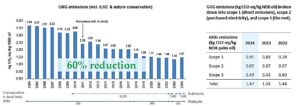
Left: Time-series for NBD palm oil at United Plantations Berhad 2004-2024. Right : GHG emissions from 2022-2024 broken down into scope 1, scope 2, and scope 3. Results include contributions form iLUC and off-setting from nature conservation.
This study highlights the fact that UP’s palm oil has significantly lower GHG emissions when compared to average RSPO certified palm oil as well as Rapeseed and Sunflower oil produced in Europe.
For more information on LCA 2025 (for data 2004-2024 ) on GHG intensity /ratio covering all of our plantations, mills and refineries (Scope 1,2 and 3 emissions) including the absolute emissions, please click here
We have been participating in Carbon Disclosure Project (CDP) since 2019. For more information about CDP, please refer to https://www.cdp.net/en/info/about-us
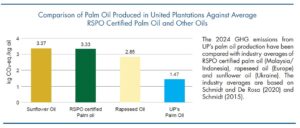
Background of UP’s LCA Study
In 2006 following the completion of the world ‘s first peer reviewed Life Cycle Assessment (LCA) study on the “cradle to grave” production of 1 MT of refined palm oil, various areas were identified within our production chain, which could mitigate GHG emissions.
Following that, the world’s first comprehensive LCA in accordance with ISO 14040 and 14044 International Standards on palm oil was finalized in 2008 and subsequently underwent a critical panel review.
Further annual updates to this LCA were carried out by 2.0-LCA Consultants involving Professor Jannick Schmidt from Aalborg, Denmark with the latest update undertaken in the period January to February 2022 thereby providing management with a detailed and clear overview of the development in the Company’s efforts to reduce its carbon footprint since 2004.
The updated 2021 LCA model incorporated the new EXIOBASE background database and the contributions from indirect land use change, peat emissions and nature conservation have been reviewed in light of new data. These studies indeed helped to identify additional areas in need of further improvement within our Group.
It should be noted that the GHG emissions per kg palm oil calculated in this study cannot be compared with the results obtained with the GHG accounting tool RSPO PalmGHG Calculator, due to key methodological differences between the two models.
In particular, main differences between the models are: the approach used to deal with land use changes and nature conservation, the modelling of by-products; emission models for nitrogen related field emissions, and peat soil emissions.
Moreover, the current study operates without cut-off, i.e. no-inputs to the system is excluded. Further, the currently study includes the GHG emissions relating to the production of pesticides, and results are presented per kg refined palm oil, whereas the RSPO Palm GHG Calculator does not include emissions for the production of pesticides, and results are presented per kg crude oil. The GHG emissions calculated in the current LCA study are systematically higher compared to a similar calculation using the RSPO Palm GHG Calculator.
2030 Target
In 2021, we achieved our internal goal of reaching a 60% GHG emissions reductio per MT of refined palm oil produced by 2025 when compared to 2004 levels (with iLUC and nature conservation), four years ahead of time. However, in line with our Group’s commitment to environmental leadership, we acknowledge that even more can be done and we therefore set a new target of 66% reduction by 2030 (all-in target for Scope 1, 2 and 3) when compared to 2004 levels (with iLUC and nature conservation). We shall relentlessly pursue to reach and exceed this through more initiatives and further investments over the next 6 years.
Emissions Reductions & Biogas Plants
Since 2005, significant investments have been made in promoting green energy starting with the Biomass Reciprocating Boiler cum Power Plant and the first Biogas Plants built and commissioned in 2006. These projects combined have since helped to significantly reduce our emissions of CO2 by 70% and CH4 by 80% at the respective operating units thereby paving the way for additional green investments.
Biomass Reciprocating Boiler
The first Biomass Reciprocating Boiler (BRBI) was successfully commissioned in 2006 to supply green steam to Jendarata Palm Oil Mill as well as the Unitata Refinery, thus playing a crucial role in reducing our fossil fuel consumption.
Since then the company has built and commissioned another 7 biomass reciprocating boilers with the latest unit at UIE (M) installed in 2019.
Isokinetic Monitoring of Gaseous Emissions from the Palm Oil Mills
In conformance to the Department of Environment’s stipulations as well as to monitor the quality of our gaseous emissions, flue gas compositions were regularly checked by certified assessors throughout 2024.
In all Malaysian mills the average dust concentrations were below the limit of 0.15g/Nm3 set by the Department of Environment as per the Environment Quality Act (Clean Air Regulations) 2014and the Lada mill emissions is well within the 0.3g/Nm3 set by the Peraturan Menteri Negara Lingkungan Hidup No 07 Tahun 2007 in Indonesia.

VORSEP Dust Collector System
The VORSEP dust collector system was first installed on our Biomass Reciprocating boiler at Ulu Basir Palm Oil Mill replacing the old conventional multi-cyclone dust collector system. The unit was commissioned in June 2015 followed by progressive installation of additional units in the rest of the mills. With the commissioning of the VORSEP system at UIE(M) mill in 2019 all of UP’s palm oil mills are now fitted with the VORSEP dust collector system.
These units were installed primarily to meet the DOE’s Environmental Quality Act (Clean Air Regulation) 2014 among others requires a cleaner emission standard from the boiler with the following conditions: –
- The dust concentration emitted from the stack should not be more than 0.150g/Nm3
- The smoke should not exceed shade No. 1 on the Ringlemann chart and should be less than 20% opacity.
Climate Risk Assessment
In UP, we recognise the threat of climate change and its effect on the planet and livelihoods. Unpredictable and extreme weather patterns directly impact agriculture operations and are a risk to food production. This may have substantial financial or strategic impact on our business too.
We have therefore conducted an assessment in line with the guidelines by the Task Force on Climate- Related Financial Disclosures (TCFD) to identify risks, opportunities, and challenges across all our operations in Malaysia and Indonesia to build resilience for our business and mitigate climate change.
The identified transition risks are summarised in the table below, which has been produced by the Sustainability Team of UP who is well-versed with the TCFD guidelines and the identification of transition and physical risks.
Climate related transition risks, opportunities, challenges and processes to mitigate the risks
| Types of transition risks | Risks | Opportunities | Challenges | Processes/Measures to Mitigate the Risks |
| Current and emerging regulations
• Adhering to existing and new rules and regulations on emissions or climate change mitigations. |
Higher compliance costs (additional costs associated to carbon pricing, taxes imposed on fossils fuels, etc)
Failure to comply with new regulations which restrict emissions or promote climate-change adaptation |
Low carbon footprint operations will significantly reduce the operational costs arising from increasing carbon prices and the dependence on non-renewable fuels | Significant investments needed to meet new requirements. | – Reducing dust emissions at palm oil mills to levels far below DOE requirements.
– New effluent treatment plants to treat waste- water down to the lowest possible industry levels. – New polishing plant to further reduce the BOD of mill effluent after biogas capture to levels above and beyond current requirements. |
| Technology
• Innovative technology to optimise efficiency of production. |
New processing methods and technology lead to different waste output and environment impact
Increasing costs associated with conventional systems that are energy inefficient. |
New innovative technology and circular economy solutions could bring about efficiency in energy usage and resilience in the use of natural resources. | High costs associated with the advancement of new technologies to reduce carbon footprints.
Availability of new proven technologies to continuously reduce carbon footprints. |
– Investments in new steam- and biogas turbines, and solar panels to drastically reduce our consumption of fossil fuels.
– Actuator valves to preserve energy throughout our refineries |
| Market
• Increasing consumer awareness on climate change and expectations to manage climate-related impacts. |
Failure to comply with increasing customer expectations and requirements insofar as low carbon products is concerned. | Benign low footprint could give access to markets and customers with strict carbon emissions regulations and requirements. | Reduced pool of compliant suppliers.
Reduced demand for commodities that fail to meet market expectations. |
– Measuring our GHG footprint for refined palm oil incl. scope 3 emissions yearly, which in turn help our customers calculate their own scope 3 supply chain emissions. |
| Reputational
•Increased scrutiny from non-governmental organisations (NGOs) and consumers. |
Reputational risks as stakeholders are increasingly focusing on the companies’ carbon footprint and plan to manage climate risks | Improved environmental score and reputation could lead to new opportunities with conscious customers | The industry as a whole must raise the bar or all companies risk being painted with the same brush regardless of individual efforts. | – Measuring our GHG footprint yearly through thorough all-encompassing LCA study factoring in both scope 1, 2 and 3 emissions. |
Physical Risks
| Types of transition risks | Risks | Opportunities | Challenges | Mitigation measures |
| Acute
• Temperature change and increased frequency of extreme weather events such as floods and droughts. |
All our properties are in areas with relatively low acute weather risks meaning that operational disruption due to such event taking place is relatively low | Safeguard operations by ensuring that emergency response teams are prepared to deal with fire and flood during drought and flood seasons. | Peat areas possess high risk of fire outbreaks during drought seasons and maintaining adequate water levels is therefore crucial. | – The fire drills are conducted periodically to ensure the readiness and prepared of fire firefighting equipment and Emergency Response Team.
– Maintaining water level at 40-60cm from ground level in the collection drains of peat area. |
| Chronic
• Rising sea levels. |
We have some properties located close to the coast and there are risk related to the rising sea levels. | Develop mitigation plans to address the risk of rising level, and identify alternative water sources and water retention facilities to increase operational resilience | Significant cost associated with establishing additional water retention facilities. | – Rainwater capturing facilities available at all operational sites.
– Ensuring proper drainages are constructed prior to the replanting. |
UP is committed to continuously improve and operationalise the short-, medium- and long-term measures and strategies to minimise the identified climate risks. This goes hand in hand with our strategic focus on the “circular economy” concept of converting waste into renewable energy via innovations and investments in new technologies to reduce our GHG emissions.
The UP Group’s GHG emissions intensity baseline and target covering plantations, milling, and refining operations are assessed and monitored annually, and in line with the TCFD’s recommendations, we have also initiated our disclosure of GHG emissions for Scope 1, 2 and 3. For more information on our journey to reduce the company’s carbon footprint vis-à-vis our baseline monitoring in 2004, reduction trends and targets, please refer to page 54.
All strategies, programmes and developments related to the climate risk assessment are headed by the Chief Executive Director of UP and any significant resources required for related projects are subject to approval by the UP Board. The climate risks will be deliberated and reviewed as deemed necessary during the Group Sustainability Committee (GSC) Meeting. Lastly, climate change is also listed as an important indicator under our materiality assessment and the level of prioritisation is assessed annually based on feedback from our stakeholders.
For more information on the financial disclosures and targets related to climate related risks, please click here
Tree Reserves
Grut Sanctuary
UP´s commitment to sustainable agriculture originated with its founder, a Danish Engineer & Entrepreneur, Svend Aage Westenholz who established UP in 1906.
One of the key figures during the foundation of UP was Westenholz’s brother-in-law, a navy officer, Commander William Lennart Grut. The two stalwarts, Westenholz and Grut not only linked together in kinship, also shared common values of Vision, Compassion and Discipline and introduced the first jungle sanctuary (The Grut Sanctuary) as well as the concept of mulching to maintain soil fertility in the 1930´s.
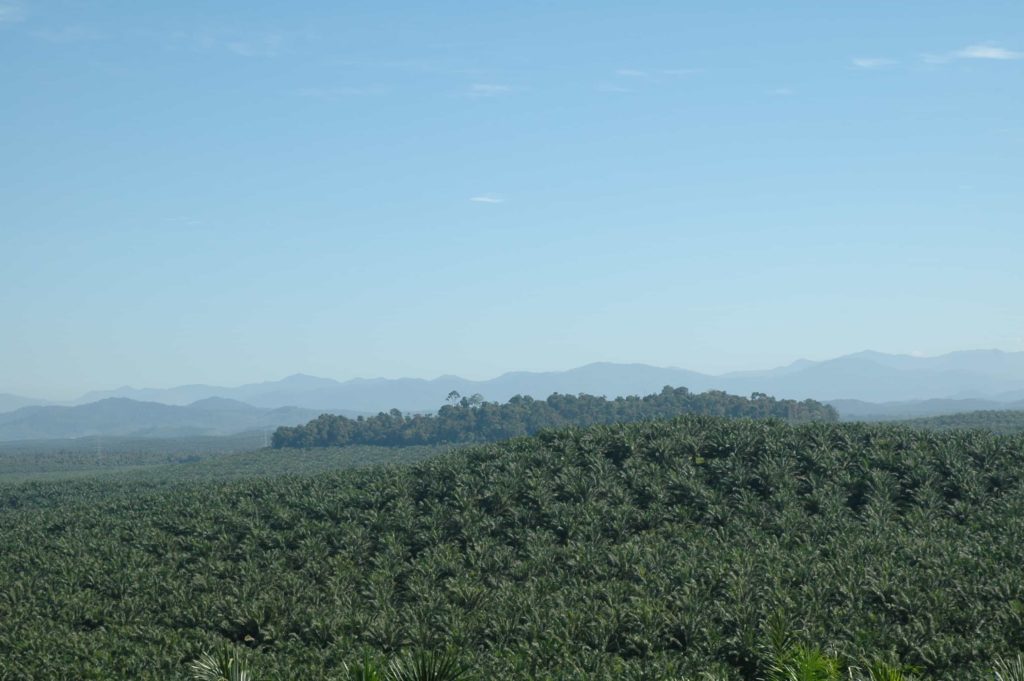
Lima Blas Jungle Reserve
With the acquisition of Lima Blas Estate from Socfin Plantations Sdn Bhd in December 2003, United Plantations also inherited an 85 hectare jungle in the estate. Situated on a hill behind the site of the now decommissioned palm oil mill, the manager’s house situated in the midst of this reserve was designed by a Mr B M Iversen, the brother of Mr W M Iversen who was the first manager of Lima Blas Estate. Built in the late 1920s, this 90 years old bungalow still stands tall in the midst of the jungle reserve today.
The jungle reserve has been enriched with Malaysian native jungle trees sourced from Kingham nursery over the years and as part of an on-going exercise, forest rangers have been invited to identify and catalogue some of the trees in the reserve which is believed to include trees from Magnolia sp. amongst other native tree species.
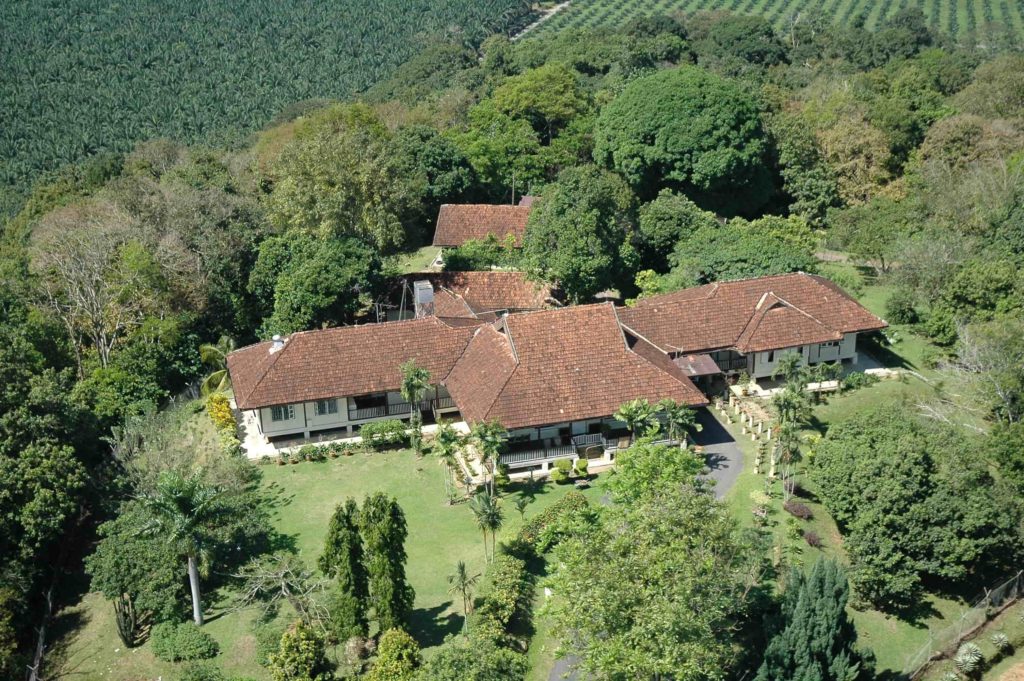
The Lagoon Tree (‘Kingham-Cooper’) Reserve
This 7.50 hectares area established in 2008 started as a barren piece of land surrounding the Lagoon (man-made-lake supplying UIE Palm Oil Mill with processing water). The Lagoon Tree Reserve had since been planted with several thousand local trees, and now resembles a natural thick jungle, with over 250 diverse species and 12,500 trees at this area alone.
A major source of planting material, serves as a gene-bank for the on-site Nursery to germinate harvested seeds and for growing the saplings to be planted on this Estate, as well as the other Estates in the Group to be able to establish its own reserve areas. The Lagoon is well stocked with a variety of local fish species, attracting numerous bird types (fish eagles, kingfishers, bee eaters, egrets & herons) as well as mammals such as the Malayan Otter.
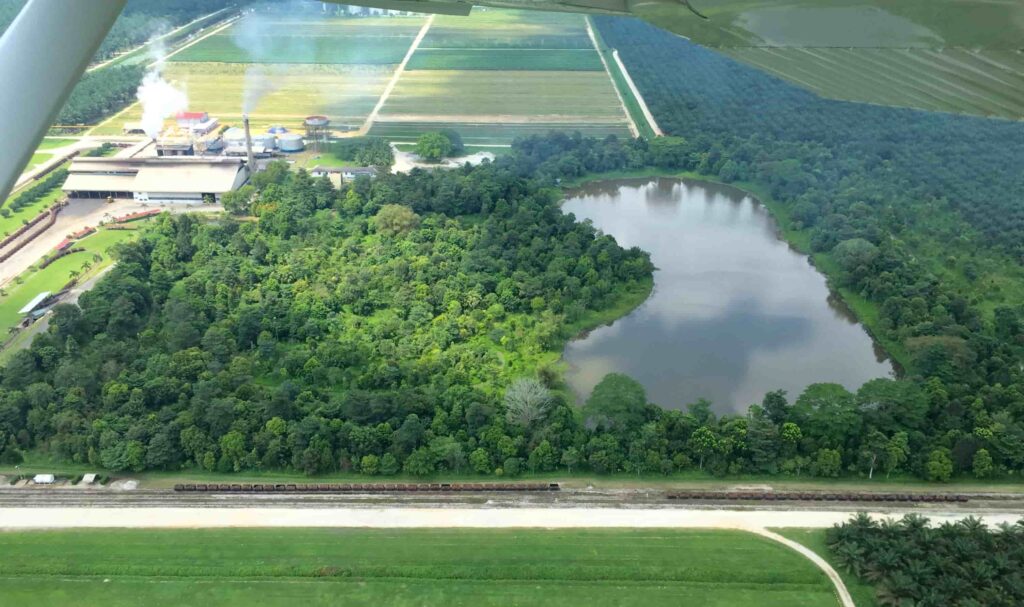
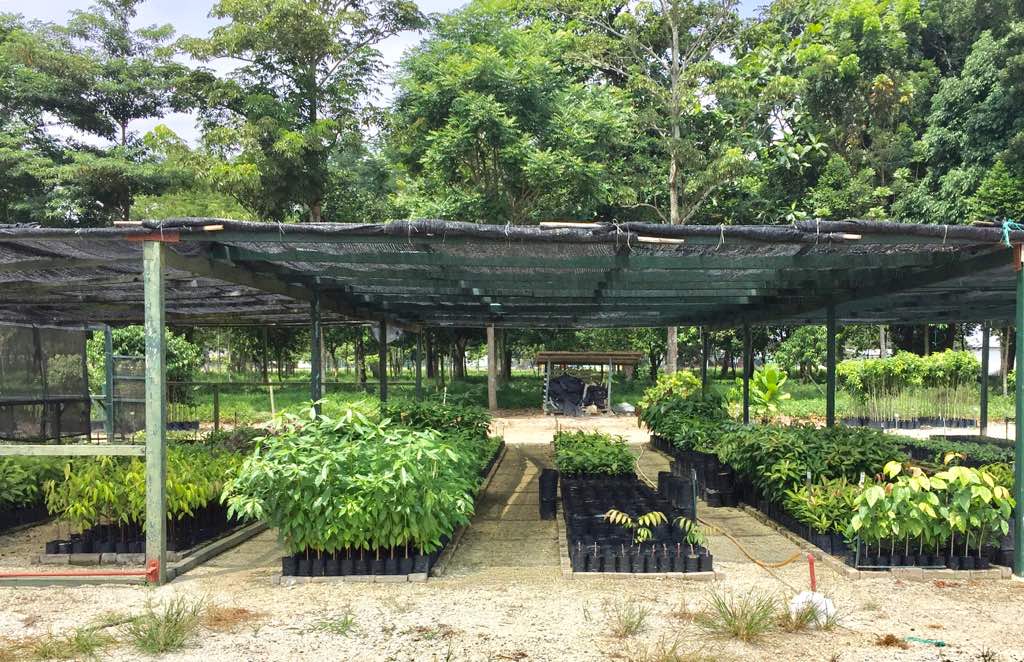
UIE Main-Office Tree Parks
Extending beyond the Lagoon, are a number of other fields planted with more diverse trees, emphasis on rare and valuable hardwoods such as the Dipterocarpaceae Family (Shorea, Hopea, and Dipterocarpus). Additionally, a variety of “food chain” species have been planted to provide food & nesting for birds, habitat for wildlife.
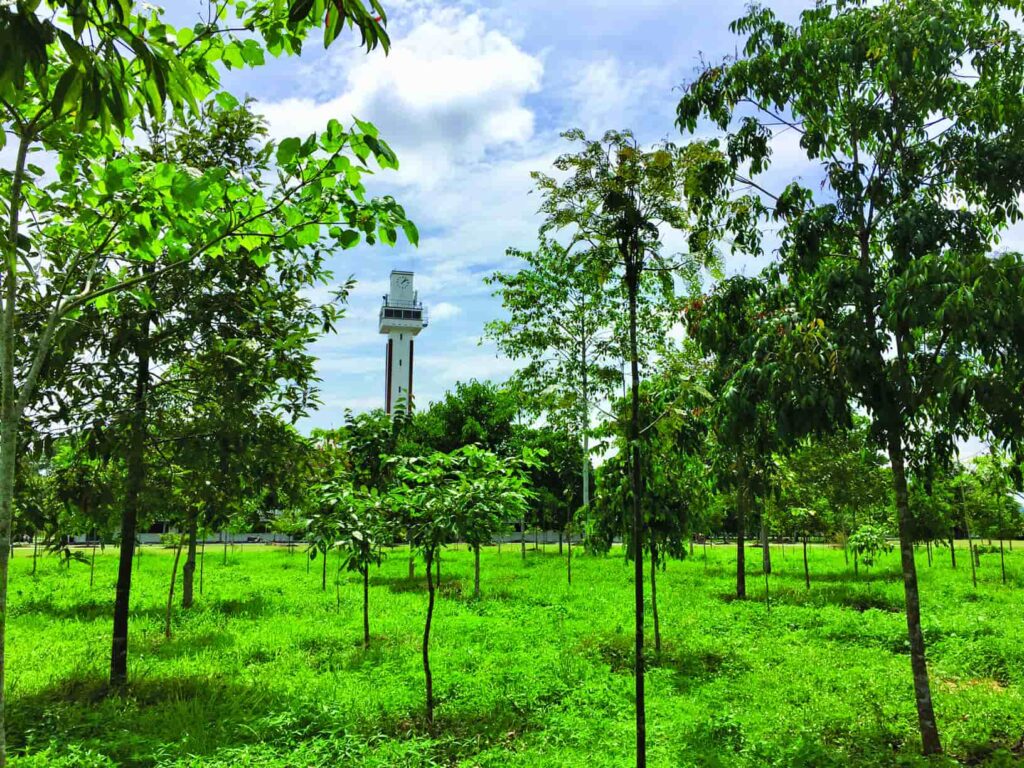
The Anak Macang Riverbank Reserve
This 5.85 kilometres strip of land along the southern boundary to Anak Macang River (which is not permitted to be cultivated with commercial crops, as regulated by the RSPO, and which has to revert back to natural vegetation). Since 2011, it has been enriched with a variety of jungle tree species and become a pleasant, diverse area for biodiversity.
Numerous valuable hard-wood (Dioterocarpaceae species like Anisoptera Marginata, from James Kinghams Nursery. Penawar Hutan Sdn. Bhd) as well as Hopea species and Shorea species from the UIE Nursery have been planted here.To date, well over 3,000 trees have been planted along the Anak Macang Riparian Reserve, adding to the variety of wild trees available for the desired range of Biodiversity.
The main focus during 2020 has been the harvesting and raising of tree seeds to the sapling stage, for transplanting and supplying the other Estates in the Group, which one day should replicate the project commenced on UIE in 2008. The trees serve “a 360 degrees purpose”: not only being admired as magnificent life form but also to provide future generations of planting material for propagation and conservation. To date, over 18,500 trees have been planted on UIE in the numerous Parks and Reserves which will no doubt be a lasting legacy for generations to come.
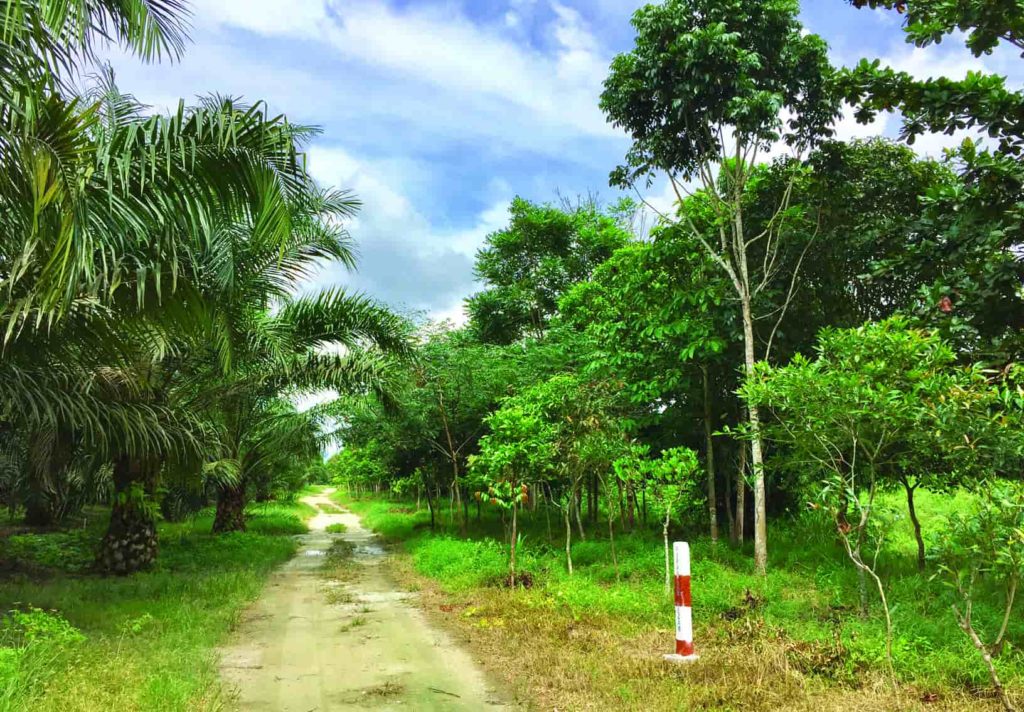
Ulu Bernam Optimill
A sizeable number of trees from the UIE indigenous tree nursery have been sent to the UP Group Estates, Upriver, and in particular for the new Ulu Bernam Optimill project for establishing its own Tree Park which can be used for gathering seeds and conservation later on.
Apart from UIE’s tree nursery, a wide variety of large ‘rare and endangered’ trees have been sourced from Penawar Hutan Nursery, Malaysia’s leading supplier of rare jungle trees, so that United Plantations will be able to carry out its commitment to conservation and future development of Indigenous Malaysian Jungle trees.
As usual we are grateful to Malaysia’s “Tree Guru” (Mr James Kingham and his family, owners of one on Malaysia’s largest and most diverse tree nurseries) who has provided us with much generous time and advice over the years for direction and the way forward.
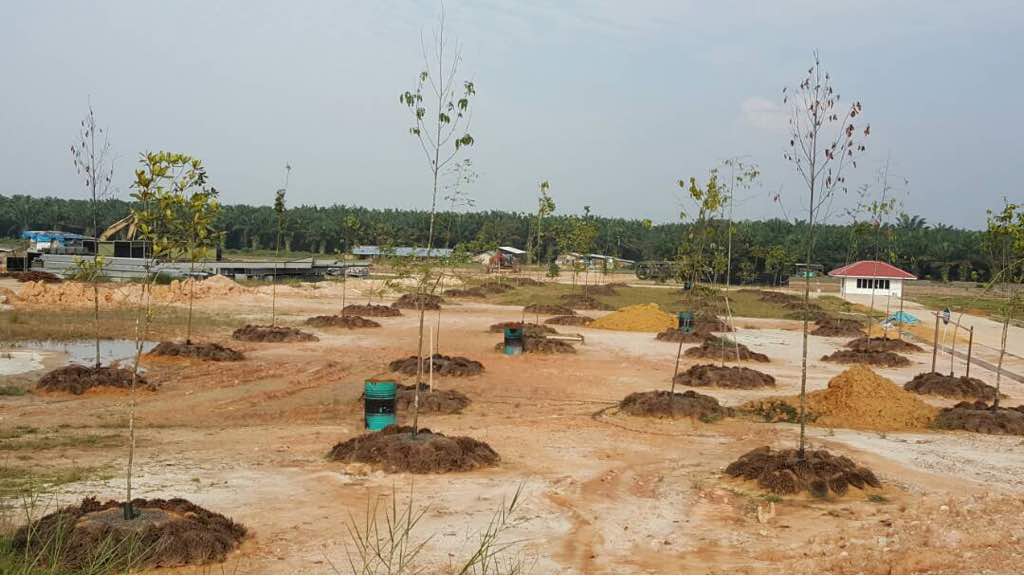
UP strictly adheres to No Deforestation and No New Development on Peat Soils regardless of its depth since 2010 which is embedded in the Environment and Biodiversity Policy. In addition, we are committed to live up to the European Union Deforestation Regulation (EUDR). We have been collaborating with an internationally recognized real time satellite monitoring database, palmoil.io since the 3rd quarter of 2023 to monitor the deforestation in our concessions as well as our direct and indirect suppliers.
![]()
| Concessions | Confirmed Illegal/non-compliant deforestation (Land size in hectares * Cut-off date 1 January 2010) |
| Malaysian operations | 0 |
| Indonesian operations | 0 |
| Third-party suppliers | 0 |
*Updated as of 31st December 2024
We are pleased to inform that the due diligence on deforestation for both UP and suppliers’ concessions was conducted and externally verified by a third-party satellite monitoring database company based on the land cover assessment. To view the external assurance statement, please click here
The above assurance statement from MapHubs is referring to the external assurance as required by our EU customers which import our palm oil material into the EU market, hence the EUDR due diligence (including monitoring of deforestation as of 31 December 2020) is required. To ensure the alignment of external assurance and EUDR requirements, the assurance is conducted using 31 December 2020 as the cut-off date, merely for EUDR purpose.
However, the UP’s strict adherence to no deforestation by UP by its own operations and third-party suppliers remain at 2010.
In addition to the above, we also subscribe to Global Forest Watch (GFW) to monitor any forms of deforestation and /or conversion of natural ecosystem either through illegal logging or fire within our own concessions and our suppliers’ concessions. GFW monitoring system is real time and notification will be sent to our Sustainability Team once any deforestation/land use change is detected.
The extent of monitoring covering all UP Malaysia and Indonesia concessions (63,000ha) and three direct third-party FFB suppliers for our Indonesian Mills (approximately 890ha). The radius or outer ring of monitoring is 500m.
All of our Malaysian Mills sourcing FFB from UP owned plantations only. The outcome of monitoring is summarised on a monthly basis. From January to December 2023, there is no deforestation and/ or conversion of natural ecosystem detected in our own concessions and direct third-party FFB suppliers.
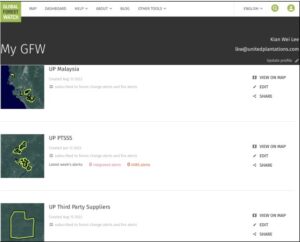
We contribute to the protection of critical ecosystems and biodiversity in and around the landscapes where we operate. Furthermore, we are committed towards restoration or rehabilitation of non-compliant deforestation or HCV loss in our plantations and the similar commitment applies for our direct and indirect suppliers.
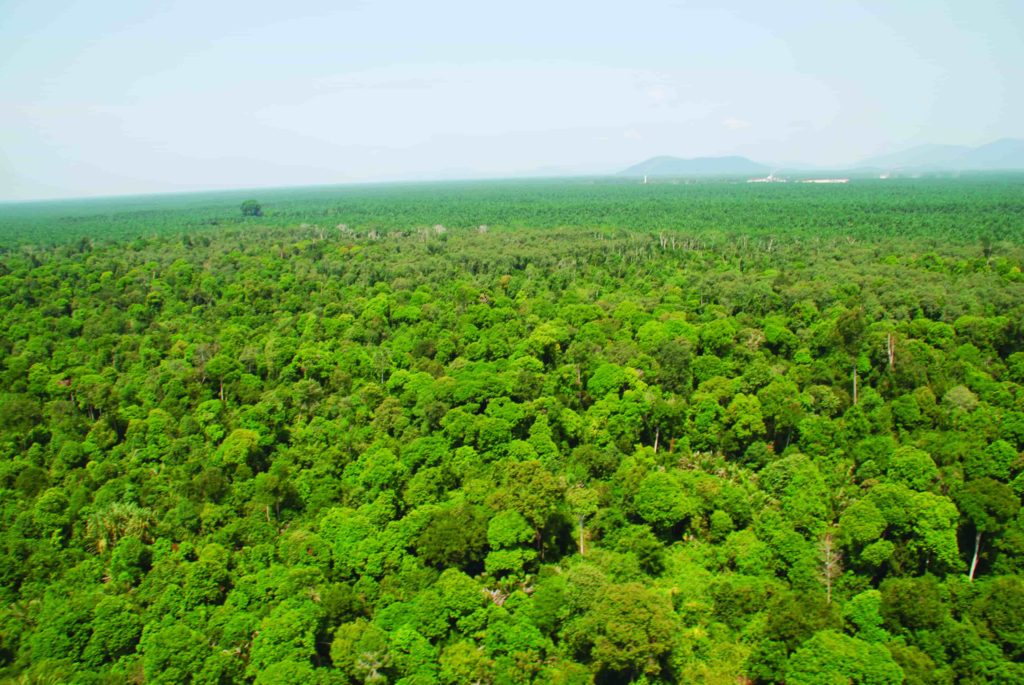
RSPO Remediation and Compensation Procedure (RaCP)
The Remediation and Compensation Procedure (RaCP) was established by RSPO to address land clearance and plantation development undertaken since November 2005 without prior High Conservation Value (HCV) assessment. The procedure requires growers to first disclose any new land development that took place without conducting a HCV assessment, calculate environmental liabilities through a Land Use Change Analysis (LUCA), and to carry out onsite or offsite remediation for the affected sites or remediation with affected parties.
The objective of LUCA is to:
- Identify the area which have been cleared by the organization for commercial purpose (for developing of oil palm plantation and its supporting infrastructure), as of November 2005 until the date of HCV assessment period;
- Access the company’s compensation liability as a result of such land clearing without prior HCV assessment
For more detail on the assessment, please click here to view our LUCA report.
RSPO New Planting Procedure (NPP)
As a RSPO certified grower, any new oil palm plantings from 1 January 2010 must be in accordance with the RSPO NPP. The NPP consists of a set of assessments and verification activities to be conducted by growers and certification bodies (CB) prior to a new oil palm development in order to ensure responsible planting.
The NPP applies to any development of new plantings, regardless of size (Ha). The intention is that new oil palm plantings will not negatively impact primary forest, HCV, HCS, fragile and marginal soils or local people’s lands. UP subscribes and supports this stance.
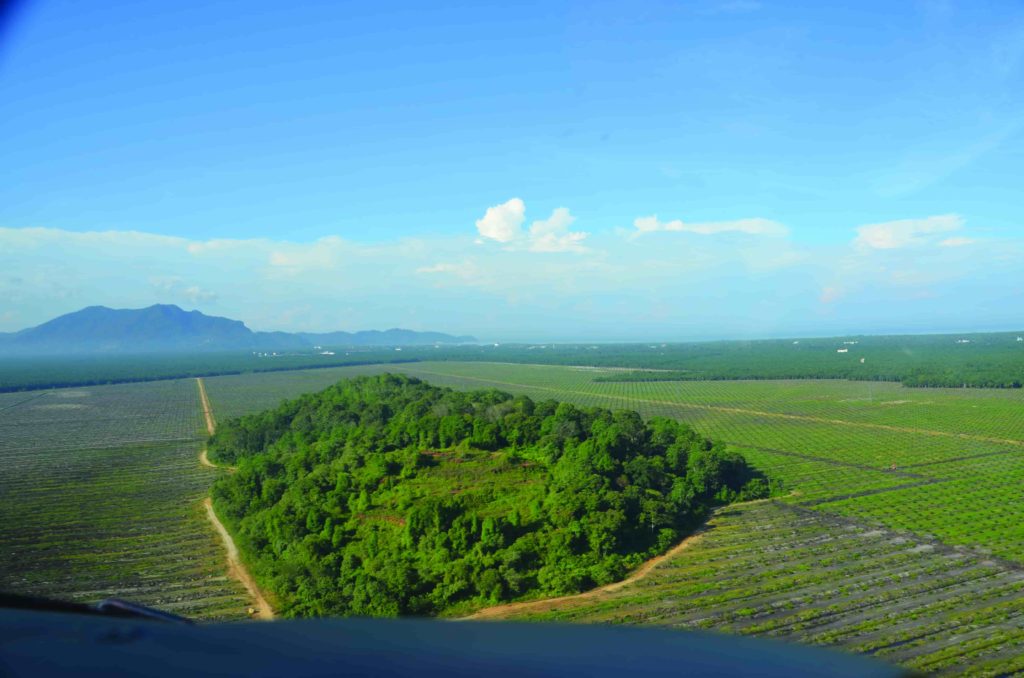
It is not enough to set aside areas for conservation. Patrolling of the conservation areas need to be conducted to protect these areas from intruders and fires so that the biodiversity is truly conserved.
The main assessments of the NPP are as follows:
- Soil suitability and topographic surveys
- Social Environmental Impact Assessments (SEIA)
- HCV and HCS assessments
- Stakeholders engagement/consultation including Free, Prior and Informed Consent (FPIC)
- Land Use Change Analyses (LUCA)
- GHG assessments
A successful implementation of the NPP ensures that all the indicators of the RSPO Principles and Criteria (P&C) are being implemented and therefore in compliance when the new development starts.
One of the outputs of the NPP is a report that proposes how and where new oil palm plantings should proceed, or not, for a given management area. The NPP report is posted on the RSPO website for public consultation for a duration of 30 days. Planting and any associated development (such as road development) can only begin once the NPP is completed and RSPO approval is granted.
The RSPO NPP underwent review in 2014 and the final document was endorsed on 20th November 2015. The additional requirements are as follows:
- Requires that new plantation developments are designed to minimize net GHG emissions, taking into account avoidance of land areas with high carbon stocks (HCS) and/or sequestration options.
- Land use change analysis from November 2005 shall be conducted prior to any conversion or new planting.
- Endorsement of the High Conservation Value Resource Network (HCVRN) Assessor Licensing Scheme (ALS) as a robust and credible replacement for the RSPO HCV Assessor approved list, now obsolete. The ALS is effective from 1st January 2015.
The current NPP guideline is under revision and consultation process and will be released upon the endorsement by the RSPO Board of Governors.
The last NPP submitted and approved by RSPO was back in 2014. The more information on our NPP report, please refer here
Social and Environment Impact Assessment (SEIA)
We have engaged an independent consultant to conduct a comprehensive SEIA in the proposed new clearing area in accordance to NPP requirement. The SEIA was conducted with participation of relevant stakeholders and the management plan is reviewed annually. The similar commitment applies for our direct and indirect suppliers.
High Conservation Value (HCV) Assessment
As a RSPO member, UP is 100% committed to embrace and implement the sustainability concepts outlined in the RSPO Principles and Criteria (P&C). In line with the RSPO P&C as well as Indonesian laws, Social and Environmental Impact Assessments (SEIA) and HCV Assessment were conducted prior to commencing plantation development by UP.
UP has not only followed the recommendations of these assessments but expanded the scope to include much larger conservation areas than that stipulated in the SEIA and HCV assessments. To date more than 8,000Ha are set aside as conservation areas in line with the Company’s policy to maintain and manage the ecological integrity of the landscape in which UP operates its palm oil plantations, as well as to provide necessary habitat for endangered and critically endangered species that are found in or adjacent to UP properties.
We are committed to only engage HCV assessors who are accredited under High Conservation Value Resource Network (HCVRN) Assessor Licensing Scheme (ALS) since 1st January 2015. The similar commitment applies for our direct and indirect suppliers. The HCV assessment shall undergo satisfactory review by the ALS Quality Panel prior to any new land clearing after 1st January 2015.
High Carbon Stock (HCS) Assessment
UP adheres to HCV combined with HCS assessments and Land Use Change Analysis (LUCA) for new plantings since 2014, UP in October 2014 requested Daemeter Consulting to perform a Land Use Change analysis as part of RSPO’s New Planting Procedure (NPP).
Daemeter Consulting is a leading consulting firm promoting sustainable development through responsible and equitable management of natural resources, particularly in Asia’s emerging economies. (For more info, please refer to www.daemeter.org)
The objective was to produce a land use map indicating exactly which areas ideally should be set aside for conservation and what areas ideally should be set aside for its Plasma commitments in Kumai Concession area.
This has been fully adhered to and the plasma development project in the Kumai conservation area has progressed well during 2018, and is a fine example of how development and conservation can go hand in hand for the benefit of the local community and the environment.
The more information on our HCV and HCS summary report, please refer here
Monitoring of Deforestation
Monitoring and managing conservation areas and biodiversity resources requires a comprehensive knowledge of baseline ecological conditions before commencing on agricultural development.
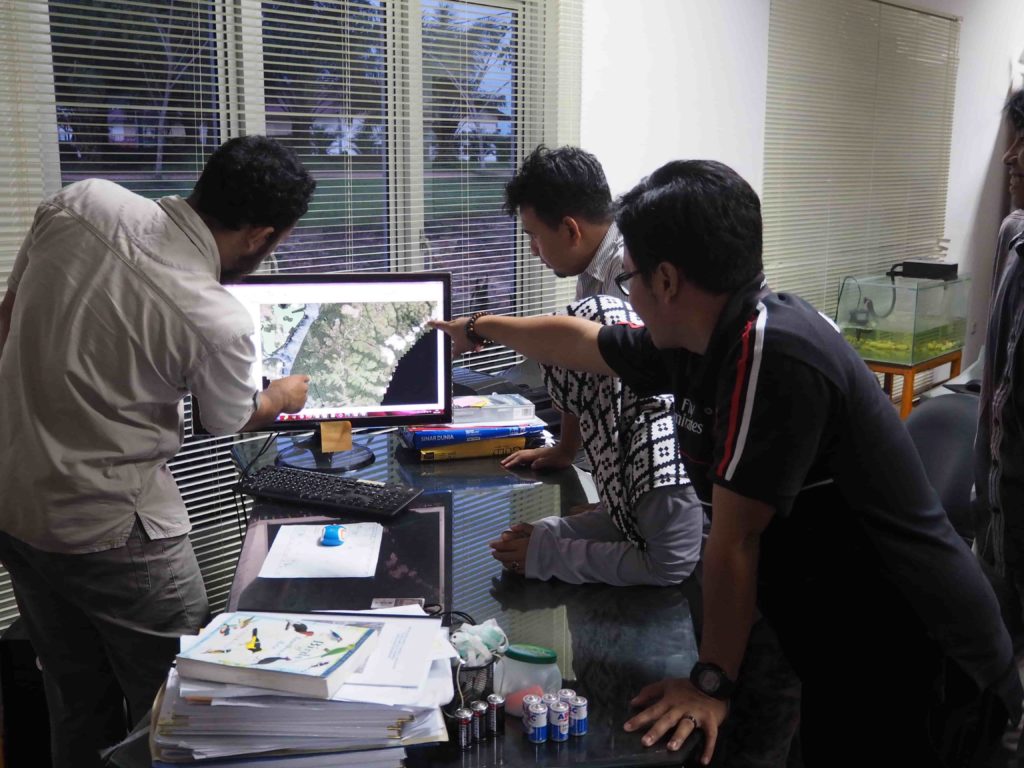
The BioD Team has set up a comprehensive GIS-database with several hundred information layers (e.g. rivers/streams, topography, boundaries, channels, planted areas, soil composition, flow-direction, water sampling sites, neighbouring forests reserved, conservation areas and many more).
The UP/PTSSS GIS-database is built up around ESRI’s ArcGIS® software platform that is considered the world’s most powerful GIS software. The software handles every type of data-input, from NASA’s high-resolution satellite images, to general orangutan observation way-points.
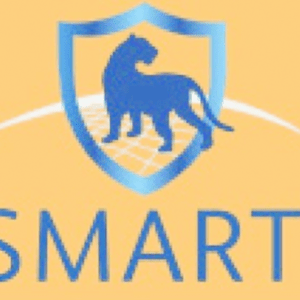 Built into the BioD GIS-database is the Spatial Monitoring and Reporting Tool (SMART) that was developed by a conglomerate of international conservation agencies. The SMART system is the world’s preferred, most comprehensive and user-friendly conservation monitoring system. The added advantage of using SMART is its statistical power that allows the BioD to compile and develop trend-lines and other forms of analyses pertaining to managing and protecting conservation areas and species.
Built into the BioD GIS-database is the Spatial Monitoring and Reporting Tool (SMART) that was developed by a conglomerate of international conservation agencies. The SMART system is the world’s preferred, most comprehensive and user-friendly conservation monitoring system. The added advantage of using SMART is its statistical power that allows the BioD to compile and develop trend-lines and other forms of analyses pertaining to managing and protecting conservation areas and species.

Environmental concerns
Oil palms are highly efficient producers of vegetable oil, requiring less than any other oil-producing crop. Despite being one of the more sustainable sources of vegetable oil there is concern that the growing demand for food and biofuel could lead to rapid expansion of palm oil production and result in serious environmental and social consequences.
NGOs and Palm Oil
Palm oil producers worldwide, continue to be exposed to much criticism by predominantly Western Non-Governmental Organizations (NGOs). Their accusations take the form of generalized views that disregard the positive socio-economic impact of the industry and continue to highlight mainly allegations of deforestation, environmental degradation, social conflicts, and economic problems.
Nonetheless, dialogue with NGOs in a constructive atmosphere of goodwill and fairness is essential in order to pursue the process of achieving a balance between the natural environment and habitat as well as the need for economic development. Those dedicated to this cause always need to be aware of the other side’s case and thereby do their best to remain objective.
Consequently, the RSPO promotes palm oil production practices that help reduce deforestation, preserve biodiversity, and respect the livelihoods of rural communities.
Land zoning issues in Indonesia and the challenges of protecting forest areas from development
Since our foundation in 1906, UP has been focusing on economic development combined with social and environmental care. This is in line with our core principle of being a good corporate citizen through proper governance and doing business responsibly by adhering to and respecting all applicable laws and regulations in the countries where we operate.
In 2006, a century after commencing our operations in Malaysia, UP ventured into Indonesia in order to further expand our involvement within the palm oil industry. To date, more than 9,000 ha of oil palm and approximately 1,300 ha of Plasma have been planted and more than 7,500 ha of conservation area set aside. These conservation areas make up about 41% of the concession area in our Indonesian operations and are a testimony to our Group’s commitment towards maintaining an important balance between economy and ecology and where conservation means development as much as it does protection of the environment.
Whilst our Indonesian operations are running smoothly, we have during the years encountered some land zoning complications over forest boundaries between Provincial and Central Governments. This can be exemplified by the incompatibility between the Provincial-Level Spatial Plan (RTRWP, 2003) and the Forest Land Use Plan (Tata Guna Hutan Kesepakatan, TGHK, 1982) that affected several hundred companies in Central Kalimantan across various sectors. Despite discussions, advice and recommendations from the Provincial Government, PTSSS (UP) became one of the affected companies after entering Indonesia in good faith based on the Provincial-Level Spatial Plan (RTRWP, 2003) in early 2007, which mapped this land area as non-forest area (KKP – Kawasan Pengembangan Produksi and KPPL – Kawasan Pemukiman dan Penggunaan Lain). However, when this incompatibility of the maps came to light thereby designating a part of our concession/planted area as being in a forest zone, PTSSS (UP) immediately consulted the Ministry of Forestry in 2009 and have since taken all necessary steps to resolve the incompatibility in line with the Indonesian Government’s regulations.
Since 2009, PTSSS (UP) has worked closely with the Ministry of Forestry to resolve this land zoning incompatibility and it is pleasing that we are now in the final stages of obtaining the forest zone release letters, which is an important milestone in obtaining the HGU (land title) for these affected areas. For a full overview of the above process, please refer to the below table, which provides an insight into the complexity of land zoning in Central Kalimantan.
| Year | Milestones | Background Details |
| 2006/2007 | UP entered Indonesia |
PT. Surya Sawit Sejati (PTSSS) was established in 2004 and the company had approvals and was in possession of HGU (Land title) for 2,508 ha’s and the remaining +13,000 ha’s had been further processed up to surveyed land boundary map (Cadastral) before issuance of the HGU (Land title) Decree. The Land Office boundary confirmation was based on the Provincial-Level Spatial Plan (RTRWP 2003) for Central Kalimantan Province, which mapped this land area as non-forest area (KKP – Kawasan Pengembangan Produksi and KPPL – Kawasan Pemukiman dan Penggunaan Lain). United Plantations Berhad (UP) subsequently completed the acquisition of the Company in January 2007. |
| 2008 | Discrepancies between the RTRWP 2003 and the TGHK1982 maps |
On the 15th August 2008, the Central Land Office (BPN) from Jakarta issued a circular to the Province Land Office (BPN) in Palangkaraya. The Province Land Office (BPN) Palangkaraya subsequently issued a letter on 2nd September 2008 to 30 companies affected by the discrepancies between the Provincial-Level Spatial Plan (RTRWP 2003) and the Forest Land Use Plan (Tata Guna Hutan Kesepakatan, TGHK, 1982) map, of which PTSSS (UP) was one of the recipients. The letter stated that the process for application of HGU (Land title) is postponed until the forest land release permit (Ijin Pelepasan Kawasan Hutan) is obtained from the Ministry of Forestry. |
| 2009 | Application for the forest zone release letter begins |
Further to the letter received on 2nd September 2008, PTSSS sent a letter to Forestry Department on 5th June 2009 to apply for the forest zone release letter (Ijin Pelepasan Kawasan Hutan). |
| 2010 | Regulation on how to apply for the forest zone release letter issued |
Issuance of Government Regulation PP. 10/2010. |
| 2012 | Amended regulation on how to apply for the forest zone release letter issued |
Issuance of Government Regulation PP. 60/2012. On 2nd August 2012, PTSSS (UP) re-applied for the forest zone release letter (Ijin Pelepasan Kawasan Hutan) in accordance with the amended regulation (Government Regulation PP. 60/2012). Issuance of Surat Keputusan Menteri Kehutanan No.529 dated 25th September 2012 amending the Forest Land Use Plan (Tata Guna Hutan Kesepakatan, TGHK, 1982) map pertaining to forest zoning in Central Kalimantan. |
| 2014 | Director General of Planology Forestry Department clarifies the zoning status and forest release mechanism |
PTSSS (UP) received a letter from Director General of Planology Forestry Department on 6th January 2014 clarifying the zoning status for PTSSS concessions when comparing the RTRWP 2003 and the Surat Keputusan Menteri Kehutanan No.529 maps. The letter further advised that +9889ha of PTSSS (UP) concession is under forest zone (Production Forest, HP and Convertible Production Forest, HPK) and PTSSS (UP) may further proceed with the forest release mechanism for Convertible Production Forest (HPK) land. |
| 2015 | Approval letter for the release of Convertible Production Forest (HPK) land received |
On 20th March 2015, PTSSS (UP) received the approval for the release of +5122.73ha Convertible Production Forest (HPK) land. On 14th April 2015, PTSSS (UP) submitted a letter for land swap forest area (TMHK) for the balance area of +4793ha which falls under HP zone. Issuance of Government Regulation PP. 104/2015 dated 22nd December 2015. |
| 2018 | Land survey by the Harmonization Team begins and land title received |
On 4th July 2018, PTSSS (UP) received a letter from the Minister of Forestry for the Harmonization Team to conduct land survey on the HP area of +4793ha. On 12th March 2018, PTSSS (UP) received HGU (land title) approval for 6004.15ha of PTSSS (UP) concessions. |
| 2019 | Successful completion of land survey and principal permit for land swap granted by the Forestry Department |
Completion of land survey and recommendation by the Harmonization Team to the Minister of Forestry Department in May 2019. On 7th October 2019, the Minister of Forestry Department issued a principal permit for the land swap application for an area of +4793ha. PTSSS (UP) engaged an accredited consultant to conduct border setting/boundary marking including consultations with all relevant stakeholders such as Government authorities and local communities. A deadline of 12 months to complete the boundary marking was given. |
| 2020 | Extension applied due to COVID-19 pandemic |
On 19th June 2020, we applied for extension on the border setting/boundary marking as our consultant was unable to conduct the task due to the COVID-19 pandemic. |
| 2021 | Extension approved for border setting/ boundary marking in relation to the land swap process |
On 9th February 2021, the Board of Coordinating Investment, on behalf of the Forestry Department, approved our extension request for border setting/boundary marking in relation to the land swap process. On 19th May 2021, the Minister of Environmental and Forestry Ministry, has issued the Decree of Relinquish of the Permanent Production Forest (HPT) of ± 4,872 ha to PT Surya Sawit Sejati. Then, the boundary marking process as one of the step under the land swap will continue. |
| 2022 | Boundary marking process by the Integrated Team engaged by the Ministry of Environmental and Forestry is on going |
In 2022, the Integrated Team engaged by the Ministry of Environmental and Forestry has performed the boundary marking and the process has completed in the 3rd quarter of 2022. The Integrated Team has provided actual hectarage on the ground with the Ministry of Environmental and Forestry for further processing of forest release.
|
| 2023 | Receive an approval letter for the release of Production Forest (HP) land
Submitted the application of HGU at the Land Office Kanwil Palangkataya and the Central Jakarta (Kantor ATR/BPN Jakarta) |
On 3rd February 2023, the Ministry of Environmental and Forestry Minister has issued the Decree of Relinquish of the Production Forest (HP) of 4,669.82ha to PT Surya Sawit Sejati. In October 2023, we have submitted the application of HGU for 5,001ha (made up of 4,669.82ha of HP under land swap process and some balance APL area) and proceed with kadastral as the first step of HGU processing. Subsequently, we have been going through the process of thematic, pre-Panitia B, Panitia B meeting and submission of all relevant documents to the Central Land Office in Jakarta before receiving the SK HGU. We are still awaiting the issuance of SK HGU. Once we have received the SK HGU, we shall proceed with the payment of Establishment of Tax on Land and Buildings Rights (BPHTB) prior to the issuance of HGU by the Land Office of Pangkalan Bun.
|
| 2024 | Payment of Timber Replacement Cost (PSDH and DR) |
For the Convertible Production Forest (HPK) land, we have made the payment of the Timber Replacement Cost (PSDH and DR) for a total of 1,762.31ha.
|
| 2025 | Release of Presidential Regulation Number 5 of 2025 concerning the Order of Forest Areas
Release of Decree No 36 Year 2025 related to the list of legal subjects of oil palm plantations which are involving in the forest zoning issues
Ongoing communications with interested stakeholders.
Seeking more clarifications from the Government authorities
|
The Government of Indonesia has released the Presidential Regulation Number 5 of 2025 concerning the Order of Forest Areas, signed by Pak Prabowo Subianto on 21 January 2025, aims to regulate forest areas controlled without permits, with a focus on collecting fines, re-occupying and recovering assets. On 6th February 2025, the Ministry of Forestry has released a Decree No 36 Year 2025 related to the list of legal subjects of oil palm plantations that have been established in forest areas that do not have forestry permits that are in process or have had their applications rejected by the Ministry of Forestry. Whilst we have forestry permits in process, PT SSS was nevertheless, one of the Companies amongst over 400 Companies listed in the Appendix of Decree No 36 Year 2025. More that 1.1 million hectares of planted area in Indonesia has been impacted by the Decree. Specifically for PT SSS, it has been mentioned that 412ha (of which around 300ha is planted) falls under the category of rejection, representing approximately 3% of our planted area in Indonesia. We shall be discussing and collaborating further with the Indonesian Government, in order to clarify if the small area claimed to be rejected actually falls under this category, considering that PT SSS has followed a due process since 2009 and strictly adhered to all regulations during the years. We shall transparently communicate with our interested stakeholders once there is more clarity on these developments. On 6th March 2025, our appointed Certification Body for ISPO i.e. Mutuagung Lestari Indonesia reached out to us via email with an attachment i.e Appendix of Decree No 36 Year 2025. We immediately proposed to have a virtual discussion with the management team of Mutuagung Lestari Indonesia to explain the progress made as of to-date concerning the forest zoning issues. The virtual meeting took place on 7th March 2025, where we have transparently shared the latest developments and our commitments in addressing the issue in accordance with the proper due process and continuous engagement with the Ministry of Forestry. In relation to our RSPO Time Bound Plan which has been approved by RSPO Secretariat in 2023, we planned to conduct the RSPO Scope Extension Assessment as soon as we have obtained additional HGU from HP and HPK areas, tentatively by the 3rd quarter of 2025. Due to this unforeseen circumstances of the Presidential Regulation Number 5 of 2025 and the Decree No 36 Year 2025, we will revise our Time Bound Plan once we have received more clarification from the Government authorities on the next step. Nevertheless, we are committed to continue our engagement with the authorities to address this important issues relating to land legality in forest zones and we shall keep RSPO Secretariat updated by the 3rd quarter of 2025.
|
|
|
||
Further details of our Indonesian concessions are outlined in the RSPO Annual Communication of Progress (ACOP) summary report: https://www.rspo.org/members/33/united-plantations-bhd
Deforestation – How to balance Development & Conservation
UP has a clear commitment against deforestation as enshrined in our Environment and Biodiversity Policy: ’No primary forest clearing policy (1990), “No deforestation, no new development on High Conservation Value (HCV) and no new development on peat soils regardless of its depth (2010)’ () and ‘HCV combined with HCS assessments & land use change analysis for new plantings (2014)’.
Whilst a certain portion of oil palm cultivation, just like all other agriculture, is a result of land use change, it is incorrect to single out the oil palm industry as the lightning rod for the world’s growing anger on global warming and deforestation. Globally, according to the Food & Agricultural Organization (FAO), 12 million hectares of forests are cleared every year.
Between 1990 to 2018, more than 375 million hectares of forests were cleared and converted into other uses such as commercial ranching, agriculture, town expansion as well as infrastructural projects amongst others. Oil palm areas globally have increased from 3.7million hectares in 1990 to 20 million hectares in 2018 or a net increase of 16.3 million hectares or equal to less than 5% of the total deforestation from 1990 to 2018.
Whilst fully supporting and recognising that ongoing initiatives must be intensified to minimise the impacts of deforestation and greenhouse gas emissions, there is an acute need by the NGO fraternity and scientific network including politicians in the West for mutually balanced impact on deforestation and greenhouse gas emissions.
In this context, it was with much interest that the US NGO, The Union of Concerned Scientist (UCS) who on the 14th of December 2016 published an article entitled “Ending Tropical Deforestation Have we got our Priorities Backwards?’’ which concluded that the NGO fraternity including the UCS had got their priorities wrong. The findings concluded that the main drivers of commodity-based deforestation were in fact not palm oil production but several other commodities.
An article by the USC states,
Quote:” I don’t want to go overboard with the mea culpa here. Companies have to take responsibility for their actions, and lack of action. They can’t just “The NGO community made me do it.” But the Climate Focus Report and the new data from the Amazon demonstrate forcefully that when we get the priorities wrong, there are consequences”
Earlier in the same article it is also stated that
Quote: “The data is pretty clear: by far the biggest driver of deforestation is beef. Soy is second, but far behind in terms of importance and palm oil and wood products are even smaller drivers, causing only about a tenth as much deforestation as beef”.

Relates to UP’s measure to preserve and protect waterways and manage the use of water throughout our organisation.
United Plantations fully appreciates that much more can be done in terms of water productivity. In order to maximize the available water resources, United Plantations has, since 1913, gone to great length to construct an extensive system of water gates, bunds, weirs, canals and drains hereby enabling us to harvest and optimize the usage of rainwater. In addition, leguminous cover crops are established in all our immature plantings to conserve moisture.
It is in this context, it is important to mention that except for the nursery areas, none of United Plantations’ planted areas under oil palms or coconuts is irrigated. All our areas are under rain-fed agriculture, thus making use of whatever water comes naturally from above. We are continuously working to mitigate our water footprint related to mill waste, maintaining buffers along natural waterways, harvesting rainwater, frugal domestic water usage and judicious use of pesticides and weedicides.
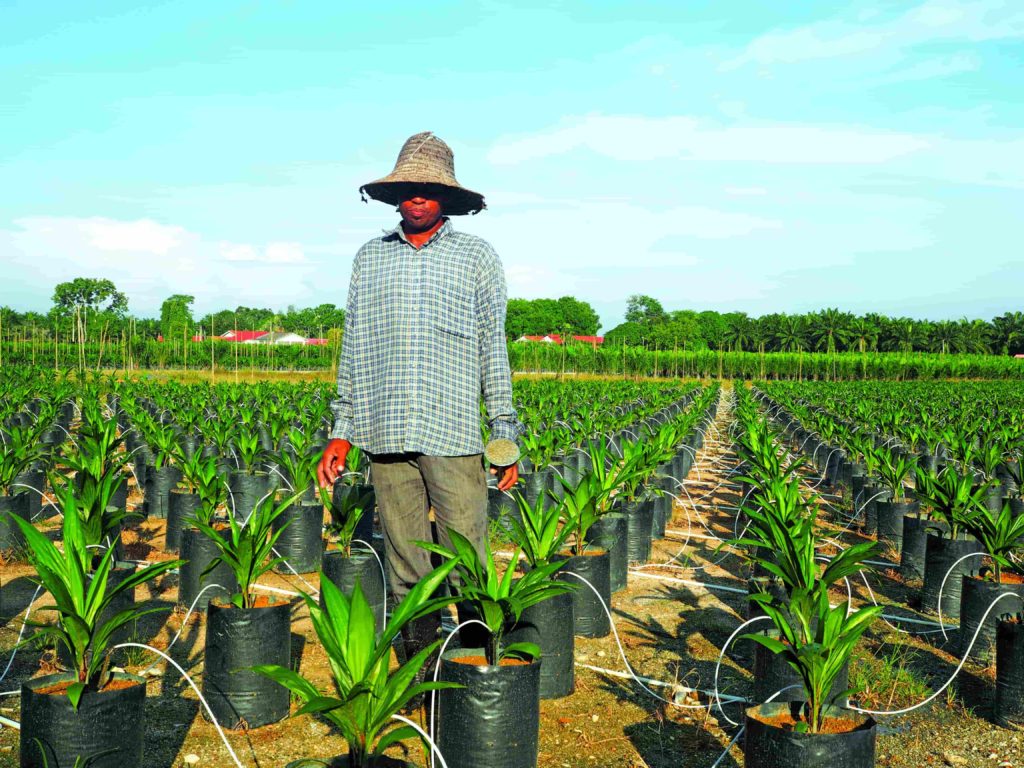
Drip Irrigation System in the Oil Palm Nursery
The consumptive use of water (evapotranspiration) of these crops ranges from 120-150 mm per month. To meet requirements, the monthly rainfall should equal or preferably exceed this figure, failing which moisture stress would occur. The rainfall in the UP Group ranges from 1,600 to 2,500 mm per year, with the average being 2,000 mm. Weirs have been constructed across the collections drains to harvest rainfall and hold back water to raise the water table during the drought season.
Moisture stress causes a reduction in cell division and cell elongation – two important growth processes. Its effect on oil palm and coconuts is summarized in the table below.
Effects of Moisture Stress
| Oil Palm | i | Accumulation of unopened spears |
| ii | Reduced leaf production | |
| iii | Drying and snapping of leaves | |
| iv | Abortion of inflorescence | |
| v | Affects sex differentiation favouring male flower production | |
| vi | Reduced oil/bunch yield | |
| Coconuts | i | Premature nut fall |
| ii | Reduced nut yield | |
| iii | Reduced nut size | |
| iv | Reduced copra/nut |
Hydrology and Limnology
Clean water is critical to sustaining all kinds of life form on Earth. In rural Indonesia, thousands of local residents are dependent on water supplies from lakes and rivers. Maintaining a clean and uninterrupted supply of water constitutes one of the most critical components in sustainable palm oil production.
The Biodiversity team has developed a “Hydrology map” and identified a number of permanent sites for sampling water quality. Using the state-of-the-art equipment, the team measures and records organic, inorganic and physical pollution parameters in the field.
Potential trace elements and toxins are measured with a spectrophotometer in the laboratory. In the event of a sudden deterioration in water quality, the team will identify the source of pollution and initiate a process to rectify the problem.
This includes identifying any unusual organic contamination, usually due to empty fruit bunches that mistakenly have slid into a stream or if an unusually high level of inorganic contamination is detected, it is usually a result of excessive wash-out of fertilizer. Such information is communicated to the respective estate manager, allowing them to rectify a potential problem within a very short time period.
In our pursuit to conserve this depleting precious gift, every effort is being done to educate our residents to be frugal on its usage. Old water pipes, water tanks, faulty taps are being replaced from time to time to arrest leakages. We aim to reduce our domestic water consumption by 10% from the average of 80 gallons per capita per day in 2025.The domestic water is sourced from either Government supply or our own treated water from river to reservoir. In 2023, domestic water consumption in Malaysia has seen some reduction while in our Indonesian operation water consumption is still much lower than two years ago as seen from the table below.

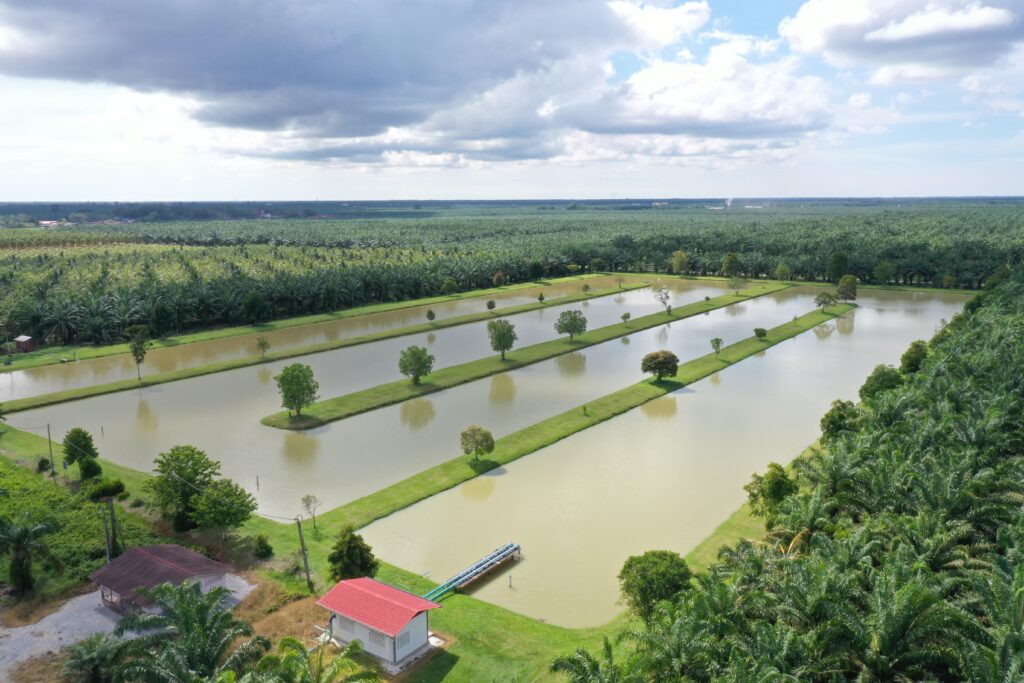
Erosion Monitoring Plots
To better understand the dynamics of soil, water and nutrient loss that can occur in our property, several erosion monitoring plots measuring 6m x20m were set up in one of our estates on slightly sloping land under mature oil palm. Thereafter the amount of soil loss, surface runoff and nutrient losses in each of these fractions are being closely monitored to determine the major routes of soil, water and nutrient loss.
Such studies illuminate the areas of major loss through which mitigating measures can be developed to minimise the depletion of these vital natural resources.
Rain Harvesting
As part of our effort to conserve water resources and minimise wastage, we have embarked on a programme to fit workers’ housing with tanks to store harvested rain water which is especially beneficial during periods of prolonged dry weather.
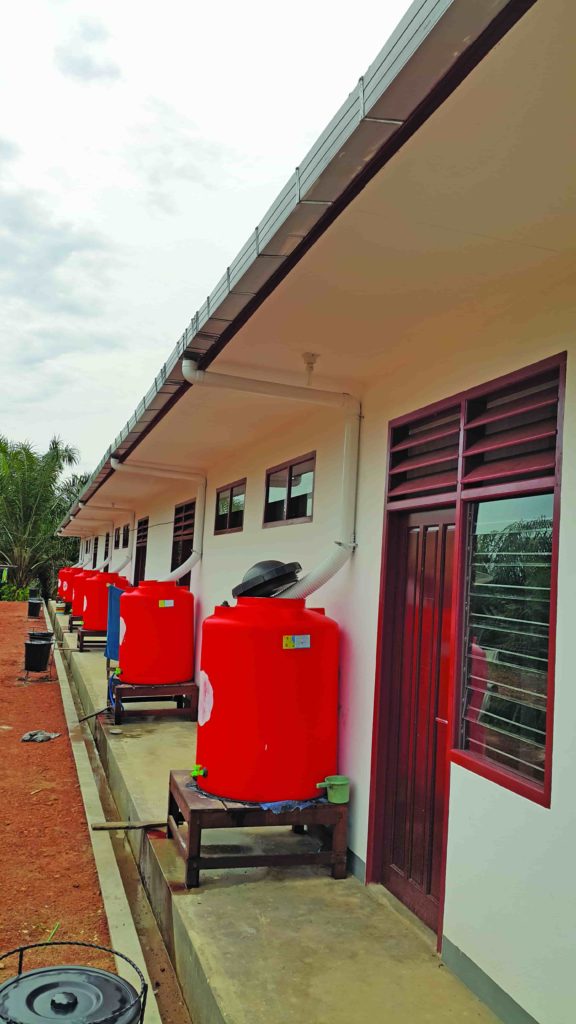
Planting of Leguminous Cover Crops
Leguminous cover crops are established in all our immature plantings to conserve moisture.
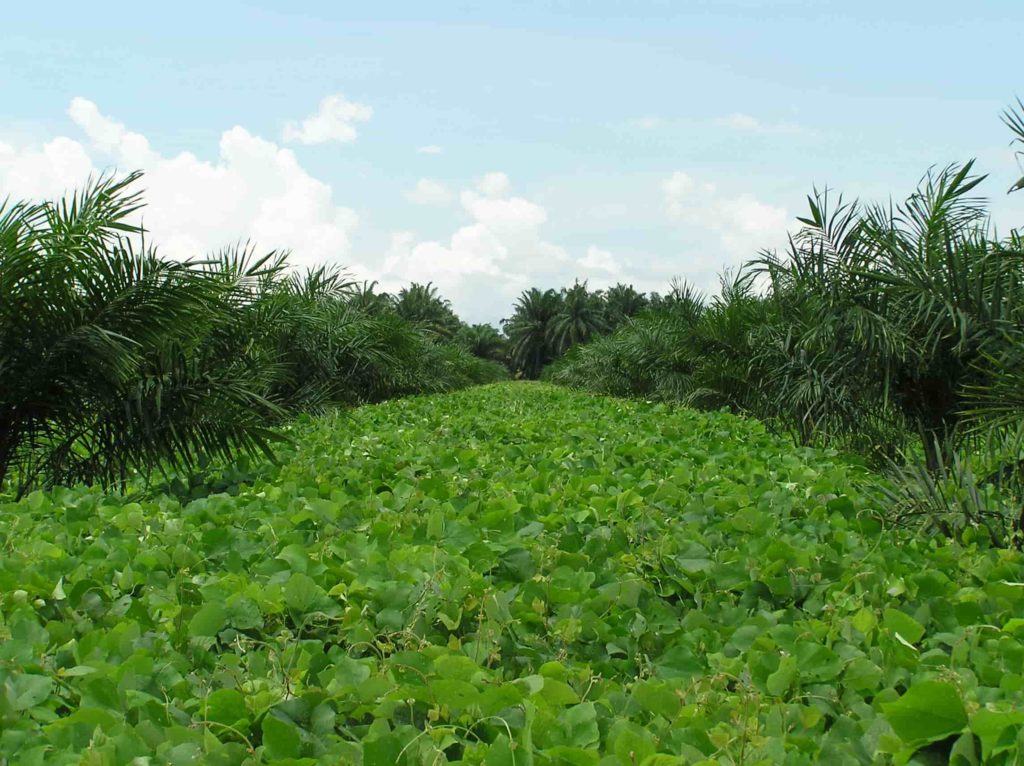
Monitoring of Water Quality
Clean water is critical to sustaining all kinds of life form on Earth. In rural Indonesia, thousands of local residents are dependent on water supplies from lakes and rivers. Maintaining a clean and uninterrupted supply of water constitutes one of the most critical components in sustainable palm oil production.
The Biodiversity team has developed a “Hydrology map” and identified a number of permanent sites for sampling water quality. Using state-of-the-art equipment, the team measures and records organic, inorganic and physical pollution parameters in the field.
Potential trace elements and toxins are measured with a spectrophotometer in the laboratory. In the event of a sudden deterioration in water quality, the team will identify the source of pollution and initiate a process to rectify the problem.
This includes identifying any unusual organic contamination, usually due to empty fruit bunches that mistakenly have slid into a stream or if an unusual high level of inorganic contamination is detected, it is usually a result of excessive wash-out of fertilizer. Such information is communicated to the respective estate manager, allowing them to rectify a potential problem within a very short time period.
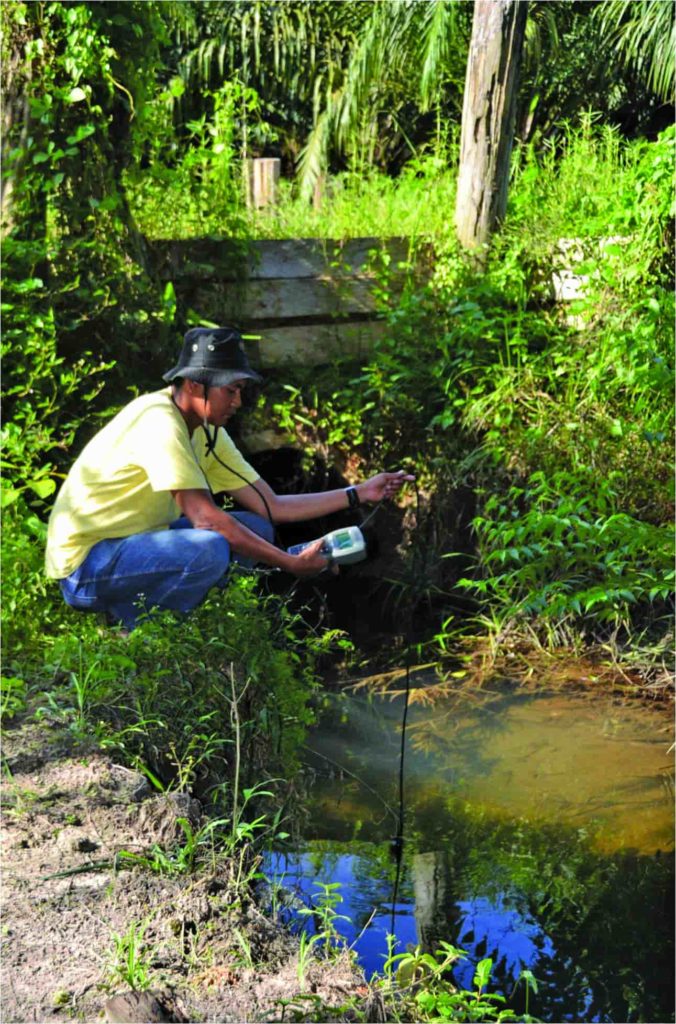
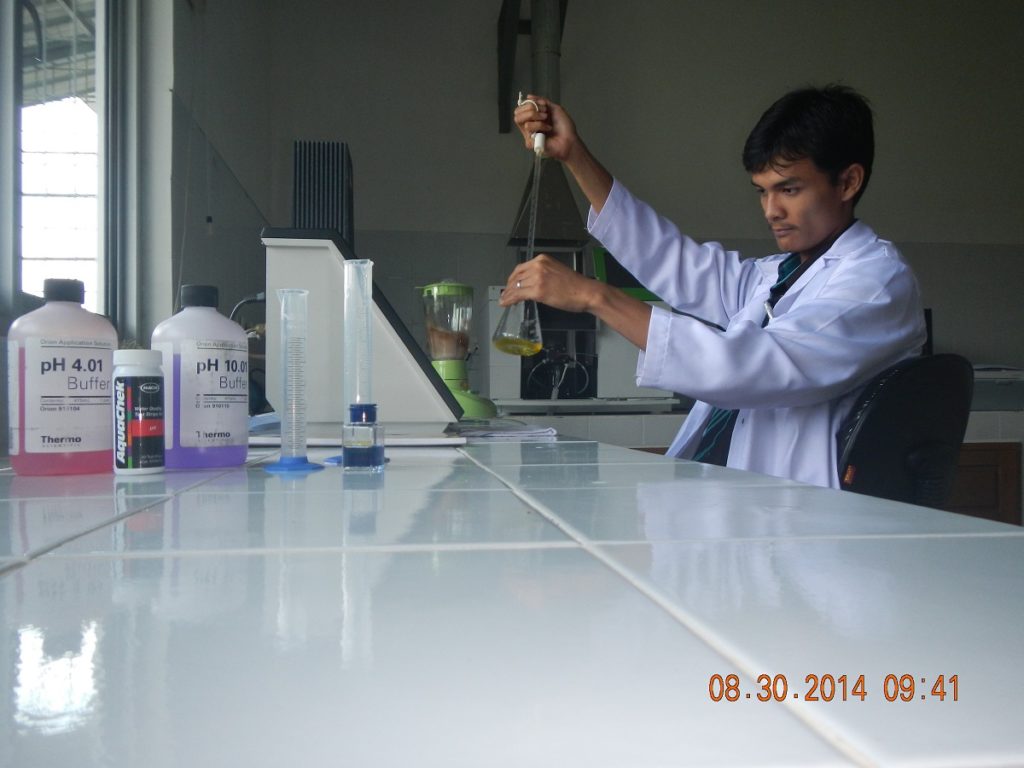
Mill Water Consumption Rate
Water consumption rate in our Indonesian operation has improved over the recent years and is now holding steady whereas the mill water consumption rate in our Malaysian operations has also improved with the phasing out of the older mill and the commissioning of the new Optimill. We aim to reduce the average of 1.6MT water/MT FFB processed by 2025.

There shall be no use of open burning/fire in new on ongoing operations for land preparation, land management, or any other reason other than justified and documented cases of phytosanitary emergency.
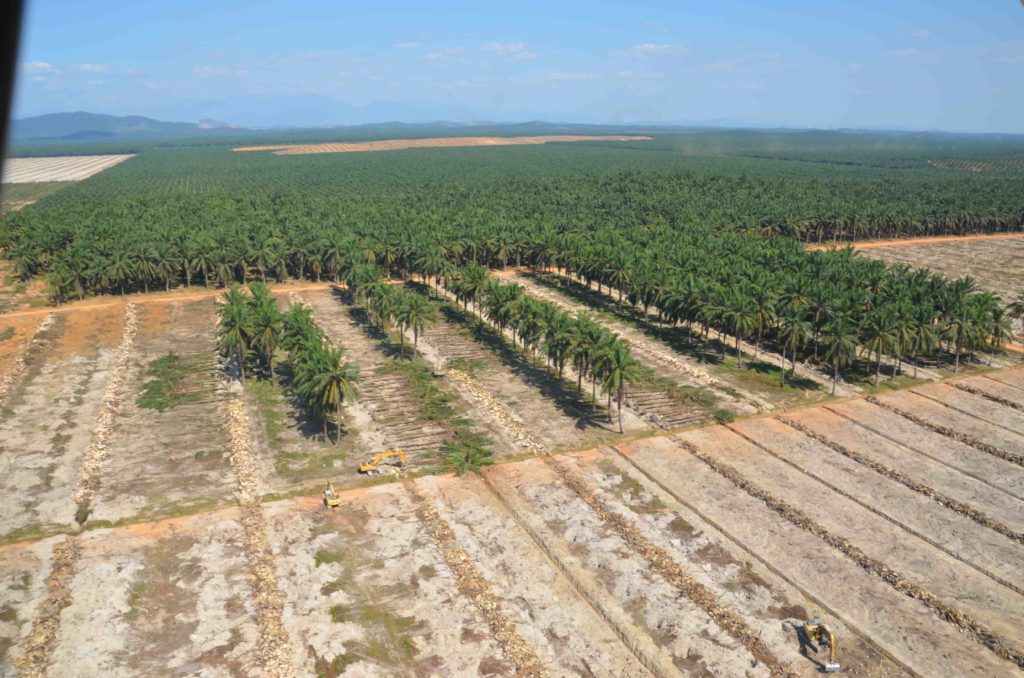
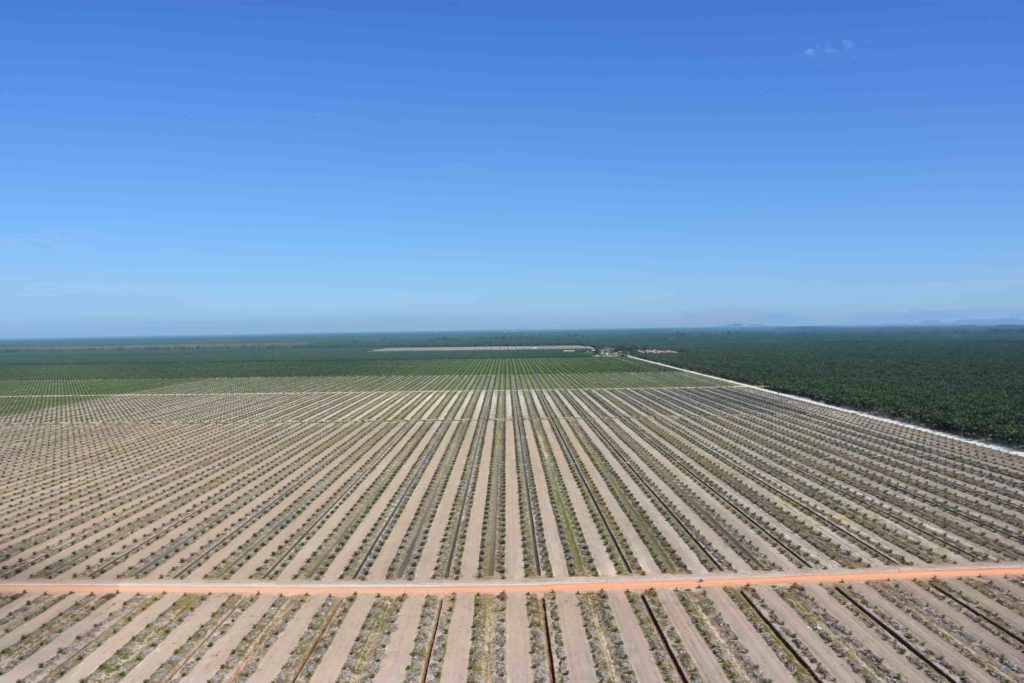
Monitoring of Meteorological Parameters
A dozen weather stations have been set up at strategically important locations in PTSSS/UP. These provide a large amount of micro-climate information critical to, particularly, make accurate fire-risk predictions.
Being able to predict the risk of fire allows the management in each estate to implement proactive measures, to prevent and minimize the risk of fire, as well as to be on high alert with firefighting equipment, in case of a fire outbreak.
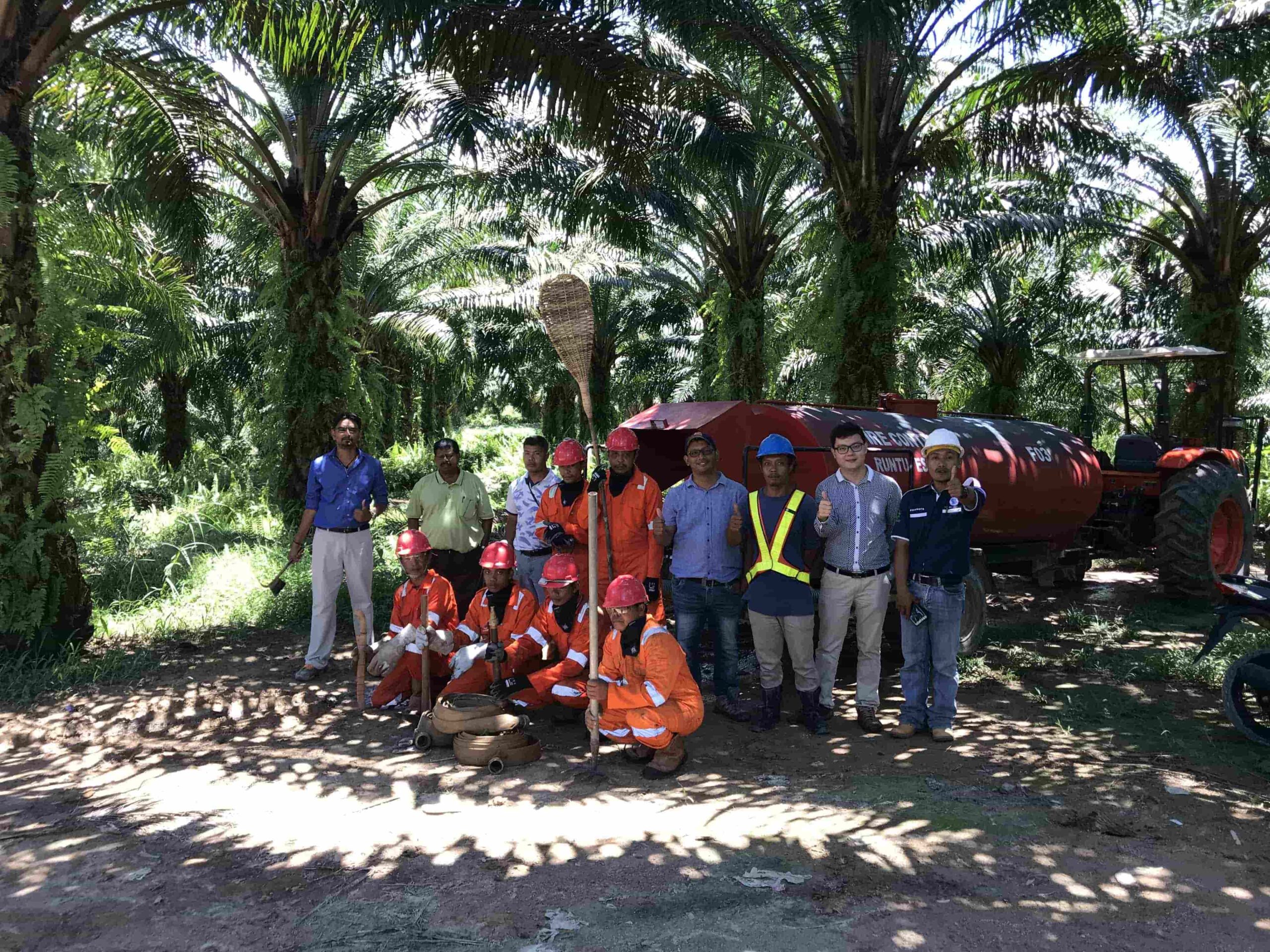
Global Forest Watch Fires (GFW Fires)
GFW Fires is a dynamic online forest monitoring and fire alert system that provides near-real-time information that can empower people to better combat forest and land fires before they burn out of control.
The GFW Fires interactive map includes near real-time fire alerts from NASA and NOAA, real-time wind direction and air quality data, maps of concessions and forest cover, high-resolution satellite images, and geo-tagged social media conversations about where fires occur.
Plantations under United Plantations Berhad have subscribed to the monitoring system to receive fire alert when there is fire occurrence within estate territory as well as 500m of outer ring.
Zero Burning Policy
Our fire prevention is managed through our strict zero burning policy since 1989, as well as through our fire management and monitoring standard operating procedure. These are continuously reviewed to ensure they are effective. Our emergency response teams (ERTs) are regularly trained in fire prevention and firefighting in all our plantations. The causes of fires vary greatly. The impacts can be catastrophic, including loss of life and loss of primary biodiversity.
We have ongoing community workshops to educate our local communities about the environmental and social consequences of slash-and-burn farming, as well as to promote alternative methods of land clearance.
Training sessions are done regularly in-house, as well as in conjunction with the local authority, fire brigades, and the Ministry of Forestry. Any fire that starts within an outer ring of 500 m from any of our plantations’ borders is immediately reported to the local fire brigade for their action. We will be conducting a series of community workshops to educate our local communities about the environmental and social consequences of slash-and-burn farming, as well as to promote alternative methods of land clearance.
A fire within an outer ring of 500 m is fought by our ERTs. We embrace fire safety in various ways such as promoting anti-smoking, tracking and identifying fire brigade locations and water sources.
Our goal is the total eradication of fire as a means to clear land by the local communities. This year thankfully there was no severe drought in Indonesia.
To further enhance the fire patrol, four additional fire watch towers were constructed at strategic points and purchased additional six units of GPS devices.
There were some isolated fire incidents which burnt approximately 1.06 Ha within our Plasma area(inner ring) and 13.2Ha at the outer ring adjacent to our concession. However, the fire was immediately extinguished by our ERT in PTSSS.



